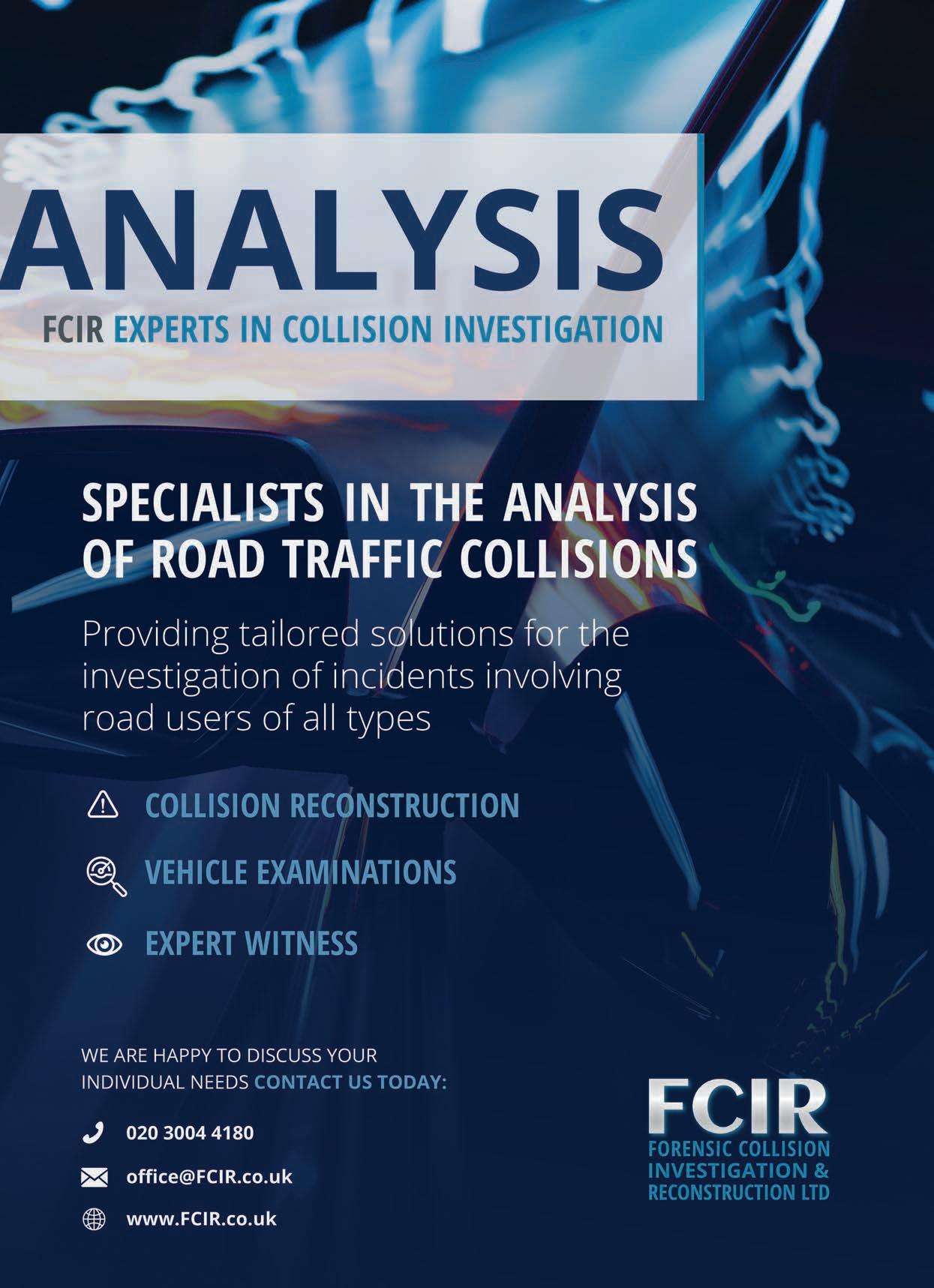
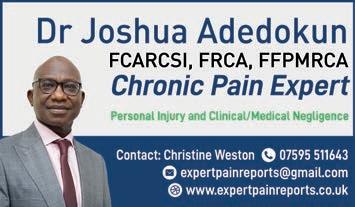
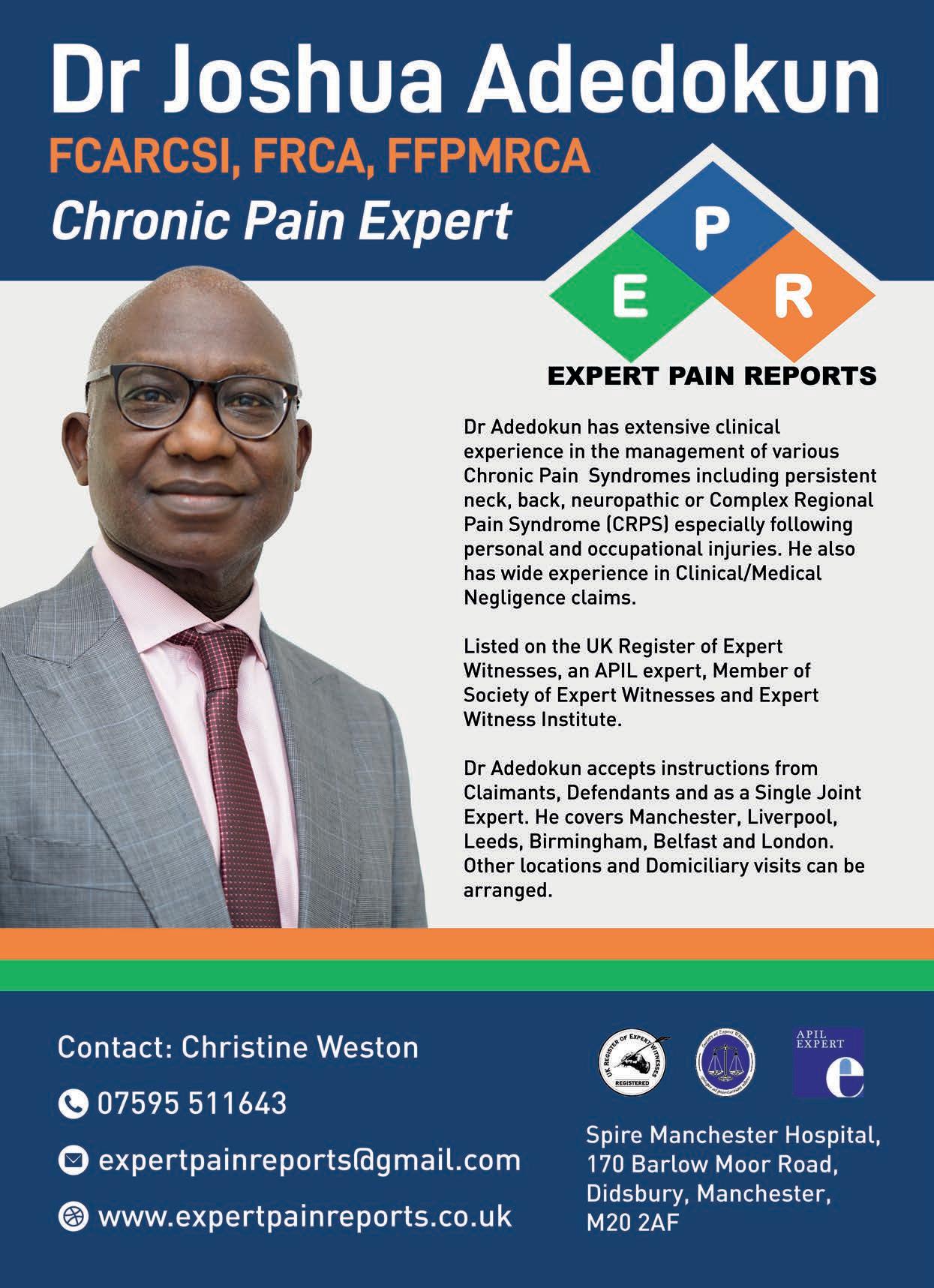











9 Lawyers sceptical about efficacy of extra court tier 9 Experts criticised for failing to declare previous criticisms 10 Hillsborough Law delivers on Kier Starmer’s promise 11 Plans to hike NI court fees will jeopardise access to justice, lawyers warn
13 Mediation: floodgates, or yet another false dawn?
PROPERTY, CONSTRUCTION & ENGINEERING
15 Companies urged to counter skills card fraud
15 Renters’ Rights Bill moves towards Royal Assent
17 Construction is still suffering from its COVID hangover
17 PI awards can help with home adaptation or purchase
FIRE INVESTIGATION
18 Fire engineers urged to prepare for new cladding test
19 Homemade e-bike battery thought to have triggered Peterborough fire
MARITIME DISPUTES
21 Shipping makes world trade go round
21 New regulations are reshaping bulk carrier operations
TRANSLATING & INTERPRETING
23 Court interpreting report draws govt response
23 Scottish govt boosts traditional languages
23 Translate Hive: fast, court-compliant language services for legal professionals
FORENSIC ACCOUNTANCY
25 SFO issues statements on Supreme Court LIBOR judgements
25 Barrister named by HMRC in tax avoidance list
26 New fraud law will help build an ‘anti-fraud culture’
ERGONOMICS
27 Expert opinion can simplify a complex relationship
27 Ergonomics: it’s not just about chairs
GEOTECHNICAL & GEOENVIRONMENTAL ISSUES
28 Surveying the lie of the land requires an expert’s eye
29 When the earth moves, the consequences can be expensive
29 Story shows how sinkholes can reveal the past
ENVIRONMENTAL ISSUES
30 Understanding plant pathology can unravel knotty problems
31 What steps do governments need to take on climate change?
32 Water companies face record number of criminal investigations
33 Experts help interpret environmental regulation
33 Illegal waste operator must repay £1/4m
TREE CARE
34 The tree expert’s case book: independent review of evidence at an early stage



45 New league tables being rolled out across England
47 Doctors’ union disappointed with associates court ruling
49 Dash Review draws conclusions; makes recommendations
51 Nuclear plants given ‘all clear’ in cancer link study
51 Some doctors feel hesitant over escalating care
53 CQC reports continuing high levels of patient satisfaction
53 New contract awarded for dispute mediation panel
55 Blackpool police investigation continues
55 Lack of continuity of care led to distress for patient
PLASTIC, RECONSTRUCTIVE & HAND SURGERY
57 Govt publishes proposals for licensing of non-surgical cosmetic procedures
57 Plastic surgery in childhood can have lifelong effects
59 Hand and wrist injury: where two specialties combine
59 Expert teams treat children’s hand defects
MEDICAL TATTOOING
60 Experts can help determine when medical tattooing is needed – or when it goes wrong
60 Covering the effect of burns is a major reason for tattooing
A & E MEDICINE
61 All UK countries report summer chaos in EDs
63 Position statement issued on back-of-ambulance assessments
SEPSIS
65 Sepsis: when might timely intervention prove crucial?
65 Parliamentarians join Harry Redknapp to raise sepsis awareness
HAEMATOLOGY
67 Infected blood scandal: govt responds to additional report
67 Blood stem cell transplants ‘could be revolutionised’
OBSTETRICS & GYNAECOLOGY
69 Trusts named for inclusion in Amos inquiry
71 Antenatal lapses that can lead to a claim
71 Midwives welcome Welsh Oversight Panel
COLORECTAL SURGERY
73 What are the questions the colorectal surgery expert needs to address?
VASCULAR SURGERY
74 Swelling of the leg: when can it be litigated?
CARDIOLOGY
77 BCS president joins call for better AF treatment
77 Heart waiting list reduces; but still too long
OBESITY AND WEIGHT MANAGEMENT
78 ASA takes action against weight-loss ads
79 Why nutritional negligence is the next big legal battleground
ORTHOPAEDICS
81 Hip replacement: increased popularity carries increased risk
81 Report makes recommendations for hip fracture care
83 Investigation finds higher risk of revision with specific hip stem
83 You don’t get tennis elbow just from playing tennis
PAIN MEDICINE
84 New workstream will help pain medicine get it right first time
84 Pain Faculty reiterates position on opioids
RESPIRATORY MEDICINE
85
Drug trial offers hope for mesothelioma sufferers
85 Figures reveal declining deaths
HEARING LOSS
87 Most noisy workplaces lack essential knowledge on hearing protection
87 Device manufacturers highlight major issues in hearing care
OPHTHALMOLOGY & OPTOMETRY
89 Cataract surgery: outcomes continue to improve, audit finds
89 Optometrists welcome prospect of compulsory post-70 driving eye tests
91 Eye specialists call for standardisation of records
91 Report details potential risks of eye test separation
MALE SEXUAL HEALTH
93 Erectile dysfunction experts need to assess a range of effects
93 Huge payout secured for erectile dysfunction and incontinence
GERIATRIC & STROKE MEDICINE
95 Stroke affects older people more – and treatment is different
95
Research centre combines stroke and older people
NEUROSURGERY & NEUROLOGY
97 Brain injury soldier ’s story told by ITV news
97 Rugby star’s ‘selfless’ withdrawal praised
ONCOLOGY
98 Report highlights time difference in diagnosis and ruling out of cancer
NEPHROLOGY
99
99
99
Nephrology experts sift the negligent from the inevitable
Kidney community voices concerns to government
Home dialysis kit helps patients get a fair deal
DENTISTRY & MAXILLOFACIAL SURGERY
101 GDC explores role of remediation in the FtP process
101 Dentists back high-caffeine drinks restriction
OCCUPATIONAL THERAPY
104 Amanda Hunter: profile of an occupational therapist
PHYSIOTHERAPY
105 Physios take the rehab message to Parliament
105 Physio body submits evidence to MPs’ inquiry
PSYCHIATRIC & PSYCHOLOGICAL ISSUES
107
109
110
111
111
Depression and personal injury claims
Autism in adulthood: breaking down barriers with Expert in Mind
BPS urges future Scottish Government to take decisive action
New mums at risk from postnatal depression
Adults with developmental conditions need appropriate treatment in court
112 Has your expert reached their expiry date?

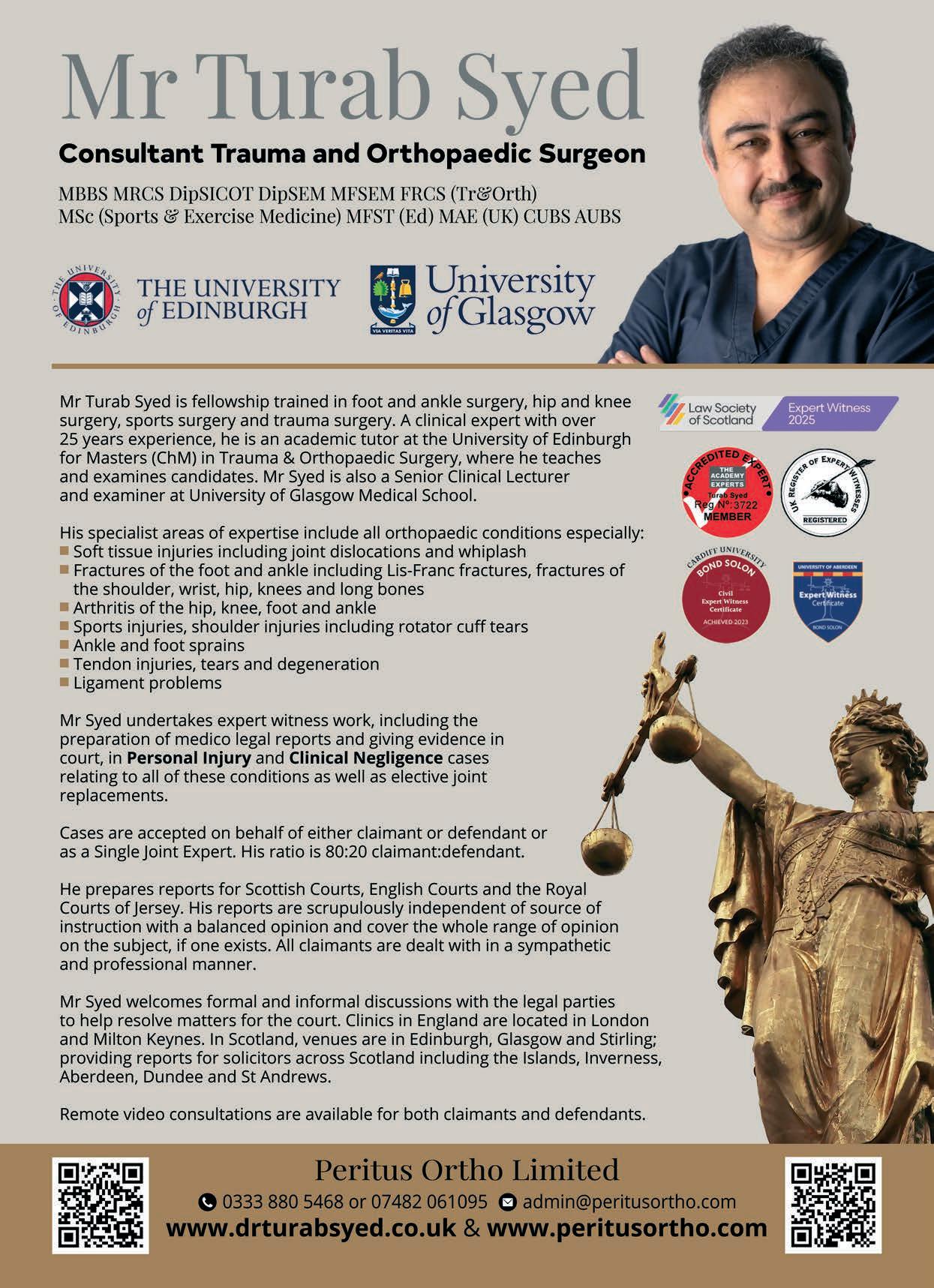
[ THE BACKLOG OF COURT CASES is universally recognised as being a major cause of justice denied, with cases already being scheduled for 2029. The proposal to address the issue by creating an extra tier of court has been met with barely-concealed derision by the Law Society. The idea is for an intermediate court known as the Crown Court Bench Division, which would help to clear the backlog by hearing extra cases.
The Law Society, reflecting research it undertook in collaboration with Sky News, points out that, in order to hear more cases, the new tier would need extra judges, magistrates, court staff and lawyers. Where, the society asks, are these people going to come from?
Perhaps predictably, the suggested solution is an increase in resources for the sector.
• In Northern Ireland the problem is being exacerbated by proposals to increase court fees by, firstly 9% in the next three years and by inflation thereafter. APIL points out that access to justice should be free for all.
• It is rarely if ever acknowledged that the cause of increased court cases is due, at least in part, to an ever-increasing number of laws. One new law that has been years in coming, however, is The Public Office (Accountability) Bill, known as the Hillsborough Law. While perhaps not as prominent in the consciousness of those outside the North of England, the law seeks to ensure public servants tell the truth at public inquiries – the Duty of Candour. Outrageously, the campaign to introduce the law has been the subject of much ‘push back’ from those potentially affected.
• A duty of candour is also, it seems, necessary for expert witnesses. In a recent case the judge had occasion to admonish two experts for failing to reveal past criticisms from judges concerning the quality of their evidence: one from the judge in question himself! The ‘hired gun’ approach has not gone away.
• Disclosure failures appear to be rife, both in the courts and in the commercial world. A new law (yeah, yeah; another one) places a duty on companies to put in place policies to prevent their employees committing fraud to the benefit of the company.
The construction industry is an industry with a singular area in which the new law can be flouted – use of false or cloned cards allowing a worker access to a building site.
• It’s not as if the construction industry doesn’t have problems already. The COVID pandemic disrupted all areas of industries, but the construction industry was arguably hardest hit, with sites needing to be closed down because it was not possible to ensure social distancing and other projects delayed by sometimes years. That crisis is still detectable.
The industry already had problems with delays and cost escalation, so deciding which was responsible is very much an expert’s job.
• The water companies have also come in for more than a fair share of brickbats. A recent report by the Independent Water Commissioner was damning in its description of the need for change. More recently the Environment Agency has announced 81 criminal investigations into water companies for breaking environmental regulations. Most involve the escape of sewage into water courses. The EA described their findings as ‘widespread law-breaking’.
• At their most spectacular, water leakages can result in sink holes appearing in residential areas. Some are huge and threaten homes, such as the hole in Merthyr Tydfil. A smaller hole has been the subject of an enlightening post on Buckingham County Council’s website. What lay beneath was an 18th-century drainage channel. You never know what may lie beneath. q
Ian Wild, Director of Business Development Your Expert Witness





[ SOLICITORS HAVE EXPRESSED pessimism over whether an additional court tier will help reduce the rocketing criminal court backlogs.
The Law Society of England and Wales carried out research, in collaboration with Sky News, asking solicitors for their views on potential reforms to the criminal courts.
Proposals include introducing an intermediate court, which would be known as the Crown Court Bench Division. The research revealed that:
• Solicitors felt a broad range of measures would be required for an additional court tier to be effective, including additional court staff who are fully trained, and increased public funding for legal defence.

• Most solicitors think the introduction of an additional court tier would make the justice system worse (56%) and is unlikely to reduce the backlogs (60%).
[ BOND SOLON has reported a recent case that raised the issue of to what extent experts have a duty to disclose previous criticisms of their evidence.
SC Commercial Bank Privatbank v Kolomoisky & Ors [2025] EWHC 1987 (Ch) is a case about a claimant bank’s allegation of misappropriation of funds.
In his judgment, Mr Justice Trower considered criticisms made of both parties’ experts. In relation to an expert instructed by the claimant, the judge himself had voiced criticisms in a previous, unrelated case. In relation to one of the defendants’ experts, despite judicial criticism in several earlier cases, that was not disclosed until three days before he was cross-examined.
Judge Trower stated that there was a particular aspect of one of the defendants’ expert’s evidence that caused him “real concern as to the seriousness with which he had undertaken his overriding duty to the court”.
In two previous cases that expert’s evidence had been declared unreliable and therefore had not been accepted by the Commercial Court. In fact, in one case he had been specifically told by the judge that he should have disclosed criticisms of his evidence in two previous judgments.
However, despite that warning, it was only six months later: “…a mere three days before his cross-examination in these proceedings, that the defendant’s solicitors disclosed to the bank’s solicitors what had been said.”
The judge concluded that the onus was on him, the expert, to ensure that the information was made available to the other party and the court much earlier on in this case.
Mr Justice Trower stated that failure to disclose previous criticism amounted to a breach of an expert’s duty to the court. While he was clear that this breach does not in itself mean that an expert’s evidence should be disregarded completely, their evidence should be (as it was in this case) subject to a higher level of scrutiny. q
• Almost three-quarters (73%) of the solicitors surveyed were concerned about jury trials being removed as part of the proposals.
Law Society president Richard Atkinson said: “Our criminal justice system – a vital public service – has been starved of resources for decades with inevitable dire consequences. These include the massive criminal court backlogs which result in unacceptable delays for victims, witnesses and defendants, with cases listed for 2029.
“The research results reflect our concerns over the effectiveness of introducing an additional tier of courts when the existing Magistrates’ Courts and Crown Courts are already overwhelmed and under-resourced. Where are the spare judges, magistrates, court staff and lawyers going to come from? Unless action is taken to halt the dwindling availability of criminal defence solicitors, the reforms could be fatally undermined.
“While there is spare capacity in the court estate in some parts of the country, this is not universally the position and so extra physical capacity will also have to be found for the new court tier to be able to sit.
“Solicitors also share our concerns over removing the right to trial by jury for serious offences. The proposed new division of the Crown Court on its own is not a silver bullet and will not solve the Crown Court backlog. The government would have undermined our historic jury system for no effect.
“Only investment in the whole system, as envisaged by Sir Brian Leveson in his report, has any chance of success.” q

[ON 16 SEPTEMBER the Prime Minister faced the cameras and repeated his personal promise that he would bring in a Hillsborough Law, stating: “Today, I have delivered on that promise,” as the government introduced The Public Office (Accountability) Bill.
The Bill contains a new professional and legal Duty of Candour, with criminal sanctions for egregious breaches and prison for the most serious. It also provides for the provision of Legal Aid for bereaved families – providing nonmeans tested help and support for inquests.
A new offence of misleading the public will lead to meaningful cultural changes and a public service that truly acts in the public interest, the government says. But for those who don’t, there will be criminal sanctions for the most serious breaches, including for misleading the public in a way which is seriously improper.
The Bill was announced as the Prime Minister met with campaigners for the ‘Hillsborough Law’, including Margaret Aspinall, who lost her son in the Hillsborough tragedy.
Sir Keir Starmer said: “I first met Margaret Aspinall as the Director of Public Prosecutions, and found her courage, and the strength of all
the Hillsborough families and survivors, utterly breathtaking. Faced with smears and lies about their loved ones, they held on to the truth and battled for decades to prove it.
“I made a promise to her, and to many others who faced terrible tragedies – incredible campaigners like Pooja Kanda and Figen Murray – that I would act so no one else would need to suffer the way they had.
“Today, I am proud to be making good on the promise I made to Margaret by bringing in the Hillsborough Law. I know nothing can ever undo the years of injustice those families have endured, but I hope it can add to the already profound legacy they have created in memory of the 97.
“Hillsborough will always remain in our national consciousness for its tragedy and disgraceful injustice. But today it can also be remembered for the way it changed our country for the better. Because with this law, we are changing the balance of power in Britain and ensuring that the State can never hide from the people it is supposed to serve.
“Make no mistake: this a law for the 97, but it is also a law for the sub-postmasters who
suffered because of the Horizon scandal, the victims of infected blood and those who died in the terrible Grenfell Tower fire.”
The Bill will include measures to better support families at inquests and ensure the focus remains on establishing the facts to deliver justice for victims: avoiding ‘David and Goliath’ style showdowns. A legal duty will also be placed on public bodies to ensure their spend is always proportionate, stopping the state from hiding behind unjustifiably large legal teams at inquests and making sure both sides are on a fair and equal footing.
The Mayor of Liverpool City Region, Steve Rotheram, commented: “Today is a landmark moment – not just for our city, but for the whole country. A day of history making and permanent legislative change. An opportunity to enact the Bill as a lasting legacy to the 97 Hillsborough victims, unlawfully killed in 1989.
“The tabling of the Hillsborough Law is the biggest victory for ordinary people campaigning and organising together in generations – and the most important change in how our justice system treats ordinary citizens since the Human Rights Act.” q
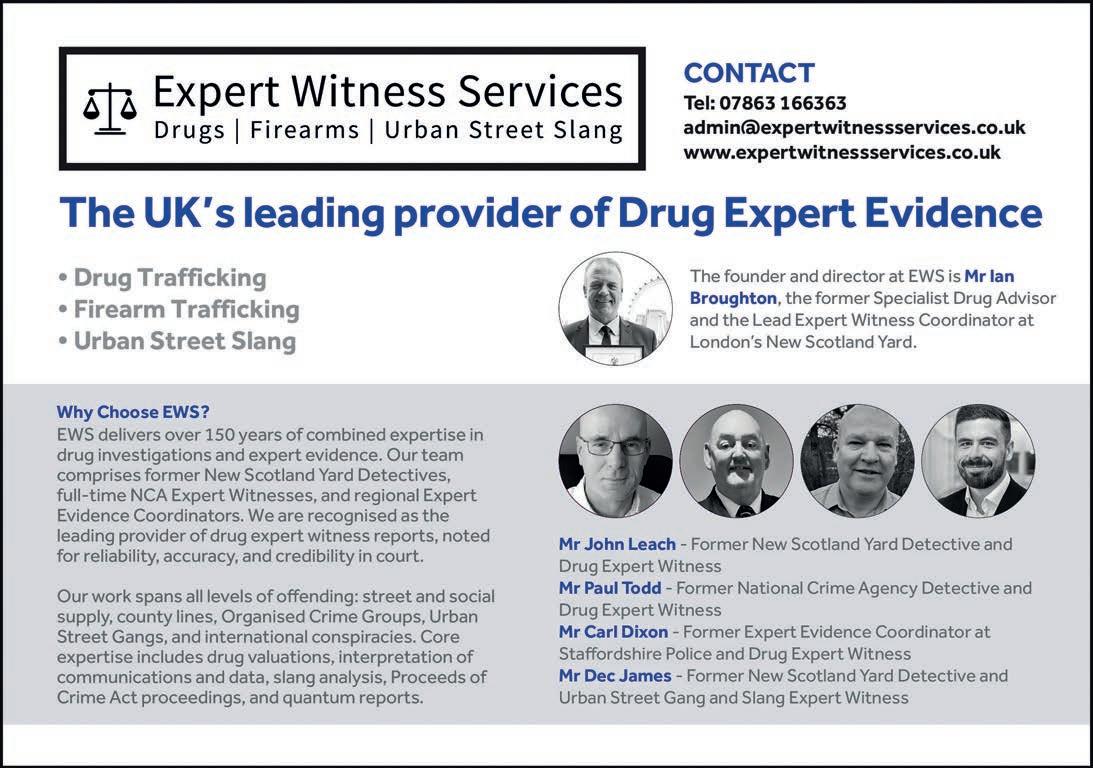
[ THE Northern Ireland Courts and Tribunal Service (NICTS) wants to increase court fees in civil claims by a total of around 9% over three years, starting in 2026. After those rises, it proposes annual inflationary increases.
“Access to the justice system should not depend on whether you can afford to issue court proceedings or not,” said Sabrina Lawlor, the Association of Personal Injury Lawyers’ (APIL) Northern Ireland representative. “Courts should be funded primarily through taxes, and people who need to use them could make an affordable contribution towards the service they use.”
She continued: “The civil courts are a vital public service which benefits all of society – not just those who have to turn to them for help in their hour of need. Without justice through the courts, for example, injured people must turn to the state for support while negligent wrongdoers escape accountability.
“Anyone can become a victim of a negligent employer or a reckless driver. People who suffer needless injuries must have access to the civil justice system to get the redress they need to put their lives back on track.”
In its response to a NICTS consultation on the proposals, APIL said it is also concerned that county court ‘scale fees’ –the fixed amounts courts can order a losing party to pay the winning one for their legal expenses – have significantly lagged behind inflation.
“The failure to review scale costs has left many law firms chronically underfunded during a period of extraordinary inflationary pressure,” said Ms Lawlor.
“Firms representing victims of negligence often have to pay the initial costs of pursuing a case, such as the court fees and medical expert fees, upfront. The combination of inadequate scale costs and rising court fees has a significant impact on a firm’s ability to do this. It’s a double hit on legal professionals and the vulnerable people they represent.
“If solicitors are not properly renumerated for the work they do to progress cases to trial, and court fees are set at higher and higher levels, there’s a real danger some will be forced to decline taking on more complex cases due to the expense of funding these types of cases.
“It means seriously injured people face being denied the redress to which they are entitled by law.” q



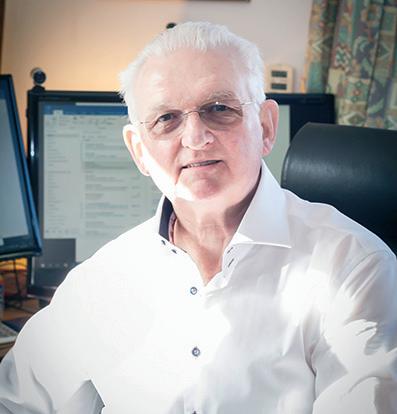
By Chris Makin chartered accountant, accredited civil mediator and accredited expert determiner
[YOU MAY HAVE SEEN my article last December, and many similar from other mediators, with the title Have the Floodgates Finally Opened? We rejoiced at the case of Churchill v Merthyr Tydfil County Borough Council [2023] EWCA Civ 1416 when, at long last, the Court of Appeal overturned Halsey v Milton Keynes General NHS Trust [2004] EWCA Civ 576 where Dyson LJ had said: “…to oblige truly unwilling parties to refer their disputes to mediation would be to impose an unacceptable obstruction to their right of access to the court.” He said that this would offend Article 6 of the European Convention on Human Rights, which establishes the right to a fair trial.
Well, now there isn’t an obstruction. Sir Geoffrey Vos, Master of the Rolls, decided that a judge can now insist that the parties go to mediation before being allowed a hearing. So all those years where judges imposed costs orders, made pointed remarks from the bench and kept parties waiting for many months, are over. Yippee! Parties can be helped by a friendly mediator, promptly and at modest cost, and have their own solution to their dispute. Wonderful!
Yet the bad news continues. We recently read of an elderly lady called Christel Naish, in dispute with married doctors next door, over a tap and a pipe which hung a couple of inches – a couple of inches –over the adjoining property. Legal costs to date? £280,000. And there’s to be an appeal. What a waste!
But I have lots of examples where I have mediated boundary disputes, where at least the parties had the good sense to mediate –yet if settlement isn’t achieved they can spend good money on legal fees. Let me tell you about one of them.
Along a street in a local town was a row of between-the-wars semi detached houses. Two such shared an unmade drive. On one side, the householder smartened up his house with a kitchen extension which went right up to what may have been the border. He finished the job by laying paviours right up to where he thought was his share of the joint drive. And we can’t rely on a Land Registry plan to decide the exact position of the border; if we scale up the red line on the plan it will be about three feet wide!
So Makin goes along as mediator, has a good chat with everyone (in their separate homes; no fraternising!) and, bit by bit, we make progress and there is agreement on where the boundary is. Better still, paviours man agrees to pull back a row of paviours which encroached on what was now next door’s property. All good news.
We even reached agreement where next door allowed paviour man to go onto their side of the border to fix the gutters on the kitchen extension; that hadn’t been possible because the chap next door had not allowed access.
Then we came to the sticking point. When the shared drive had been undeveloped, next door had erected a gatepost so that he could close off his back garden. The trouble was, that now we had defined and agreed the border, that gatepost was on paviour man’s property. And would this chap agree to move his gatepost now that it didn’t serve any purpose? We agreed to meet another day, and lawyers attended, but gatepost man would not budge.
I asked both lawyers for their estimate of future legal costs if the case went to court, and they both said £100,000. So, on top of what had already been spent, the losing party at trial would have to pay their own costs of £100,000 and then, allowing for say 30% ‘taxed off’, another £70,000. Madness! And what was worse, £170,000 was more than the equity either party had in their own home; in fact, even ignoring mortgages, the houses were not worth much more.
So after two days of negotiation, the first day very satisfying, we were left with the parties going to court – and the loser probably having to sell their home.
That isn’t far from where we came in with Christel Naish.
So is there a floodgate of mediations keeping people like me busy? Well, I haven’t seen much difference yet. Fortunately, mediation isn’t my day job, though I will always drop everything for a mediation because it’s so satisfying.
But my main job is as a forensic accountant and expert witness, and in that I am truly bursting with work. That’s on a vast range of cases; everybody wants to go to court. Why? I make a very good living as a forensic accountant, but I would much rather work less hard, for far less money, helping people settle their own disputes through mediation. When, oh when, will those floodgates finally open? q
[ CHRIS MAKIN was one of the first 30 or so chartered accountants to become an Accredited Forensic Accountant and Expert Witness –see www.icaew.com/about-icaew/find-a-chartered-accountant/find-anaccredited-forensic-expert
He is also an accredited civil and commercial mediator and an accredited expert determiner. Over the last 30 years he has given expert evidence at least 100 times and worked on a vast range of cases. For CV, war stories and much more go to the website at www.chrismakin.co.uk – now with videos! q





[ The UK’s New Failure to Prevent Fraud law – which came into effect on 1 September – has a number of potential consequences for the construction industry. The law requires all large organisations to put fraud prevention procedures in place in advance of any issues occurring. Large organisations without reasonable prevention measures will now be held criminally liable if staff commit fraud for company benefit.
The law defines a large organisation as one that meets two of the following criteria: more than 250 employee, more than £36m turnover or more than £18m in total assets.

The Construction Skills Certification Scheme (CSCS) has pointed out that, in the construction sector, it means that companies must ensure that all workers have the correct skills and qualifications
to be on a site and are not working fraudulently, for example by using a fake CSCS card.
The scheme’s CEO Sean Kearns explained: “Card and skills fraud remain a serious concern for the construction industry. Individuals lacking proper training present not only a legal risk, but also pose a threat to the safety of sites and buildings.
“It is CSCS’s firm belief that, to ensure UK construction sites remain safe, workers must have legitimate training and qualifications before being allowed to work on site. Following the implementation of this law today, verifying worker skills and qualifications is no longer optional, but essential.
“We urge all employers, contractors and site managers to implement rigorous card fraud prevention measures and use CSCS Smart Check to verify cards and safeguard their businesses.” q
[ON 8 SEPTEMBER MPs debated the Renters’ Rights Bill as it returned to the House of Commons for what has been described as the ‘ping-pong stage’: when amendments made by the House of Lords are considered. It was a crucial step in determining whether the Bill will pass to Royal Assent before the end of the year.
The Commons reviewed and responded to a series of amendments, many of which reflected concerns raised by industry and campaigners. While some technical changes were accepted, the UK Government signalled its determination to press ahead with the central reforms.
When will the Bill become law?
Exact timelines are still unknown, but during the debate Housing Minister Matthew Pennycook MP confirmed that the UK Government would introduce periodic tenancies for the private rented sector in one stage, possibly as soon as three months after the Bill receives Royal Assent. The new tenancy system will apply to all private
tenancies: existing tenancies will convert to the new system and new tenancies signed on or after the implementation date will be governed by the new rules.
The professional body for letting agents, Propertymark, explained: “While the broad direction of reform is now clear, important questions remain around student lets, supply pressures and the practicalities of enforcement. Propertymark will keep members informed as further details emerge and continue to campaign for a balanced approach that protects tenants while supporting agents and landlords.”
Possibly the most significant change to the Bill is that, as well as rejecting the amendment to allow a pet deposit, the UK Government has also removed the original clause which would have made it possible for landlords to require tenants to take out pet damage insurance. That means that the enhanced right to ask to keep a pet – which the landlord cannot unreasonably refuse – remains, but the Bill will contain no additional protections for landlords.

Matthew Pennycook MP explained that the UK Government is satisfied that the existing maximum deposit of five weeks rent is sufficient to cover any risk of damage. If damages did exceed the deposit, landlords can apply to the small claims court to recover the balance.
Propertymark CEO Nathan Emerson commented: “The Renters’ Rights Bill represents one of the biggest evolutions of housing legislation across England in over 30 years. Implementing such a wide-ranging overhaul of law must prove dynamic by design to help deliver a fair and workable balance between tenants and landlords.
“Housing fundamentally affects everyone, and there is an immense pressure on this new legislation to deliver tangible results. There is an essential on-going need for new sustainable housing stock across all regions, and for this to efficiently happen there must be long-term investment within the private rented sector, especially as population growth continues to move at pace.” q




[THE COVID-19 PANDEMIC has had a profound and lasting impact on the construction industry, disrupting timelines, inflating costs and introducing unprecedented risk management challenges.
Architects and engineers have been at the forefront of addressing those challenges, particularly in projects involving specialist accommodation, complex infrastructure or historic buildings. In parallel, legal teams and insurers have increasingly turned to expert witnesses to provide independent assessments of delays, costs and associated risks, ensuring clarity and fairness in contract disputes or claims arising from the pandemic. In disputes arising from COVID-19-related delays, expert witnesses have played a vital role. Legal teams frequently instruct construction, engineering and cost management specialists to provide independent evaluations of project delays, financial losses and compliance with contractual obligations.

Expert witnesses can assess whether delays were genuinely attributable to COVID-19, whether the impact on costs was reasonable and whether any mitigation measures were appropriate. Their analysis is often relied upon in settlement negotiations, adjudications and court proceedings, providing impartial, technically robust evidence that assists parties in reaching fair outcomes.
The instruction of expert witnesses requires careful consideration. Legal teams typically engage experts early in the dispute process to advise on the viability of claims, support negotiation strategies and prepare comprehensive reports. For projects with specialist accommodation or complex engineering requirements, multi-disciplinary experts – including architects, engineers and cost consultants – may be necessary to provide a full assessment of technical, financial and operational factors.
[ON SOME OCCASIONS when very large sums are awarded in compensation for a personal injury claim it is because the injured party needs substantial adaptation to their home – or even needs to move to a new home. The amounts awarded can seem eye-watering and often lead to adverse headlines in the press.
But, as Alex Tengroth of Fairweathers explained: “Claimants who are seriously injured through medical negligence or in personal injury claims will require new, larger, accommodation, often single storey, in order to maximise their ability to maintain an independent life and to provide the additional space required for live-in carers or equipment.”
The kind of adaptations that may be required to an existing home can be substantial. That is where the expert witness comes in. Experts will be able to explain to the court the extent of the claimants needs, while others, such as architects or quantity surveyors, will be able to accurately cost adaptations.
Until recently the claims for accommodation were calculated in line with a Court of Appeal decision of 1988 in the case of Roberts vs Johnstone. That calculation used the Personal Injury Discount Rate (PIDR) and was only viable while the PIDR was positive. When the PIDR became a negative figure in 2017 a new method was required. Clarity was provided by the Court of Appeal in Swift v Carpenter in October 2020.
Charity Leonard Cheshire, which is campaigning for new homes to be built so they can be easily adapted to accommodate disability, point out that the adaptation must allow the disabled person the same facilities as if they weren’t disabled.
“All pathways, hallways and doorways need to be wide enough for a wheelchair. Nobody can live with dignity if they’re unable to use their bedroom, bathroom or kitchen, or just can’t move from room to room.”
They describe the practicalities that have to be considered, such as simply getting around: “This is important in the home but also outdoors in the garden and parking spaces. Doorways don’t just have to be wide enough to fit a wheelchair though: there needs to be space for a wheelchair to turn around.”
And there are structural issues: “It’s essential that walls and ceilings are strong enough to fit supports and hoists where necessary. It should also be possible to install a level-access shower with controls within easy reach.” q
Speaking in 2022, Dev Amratia, CEO of data analysts nPlan, commented: “In construction, as in so many other sectors and areas of public life, the pandemic hasn’t just created new problems; it has highlighted and exacerbated existing problems – in this case the costly project overruns which are endemic to the industry. Because this issue was not dealt with before the pandemic, we are now in a situation where projects have suddenly become much riskier.
“This will pile pressure on contractors and may mean clients bring forward fewer projects. On the other hand, the salience the pandemic has given this issue means we now have an unparalleled opportunity to get better at anticipating and preventing project overruns using advanced forecasting and risk management techniques.” q

[A MAJOR CHANGE is coming to European cladding fire testing. From January 2026 a new standard will replace visual assessments with a temperature-based system, aimed at delivering more consistent and objective results across Europe. The revision also introduces updated classification rules, new test substrates, greater flexibility for manufacturers and easier use of bio-based materials.
According to The Danish Institute of Fire and Security (DBI) the updated method will replace the current system of visual fire test assessments with a temperature-based approach. DBI explained that cladding products, such as plasterboards and wooden panels, must protect underlying materials when exposed to fire.
At present, testing relies on visual checks for signs of charring on materials like particleboard, which DBI noted can lead to inconsistent results between laboratories.
Jeanne Kirk, resistance to fire engineer at DBI, commented: “It can be a bit subjective and cause variations from lab to lab. Disagreements often arise in borderline cases.”
Under the revised approach, pass or fail will be determined by recorded temperatures, with a threshold of 270°C. DBI has been directly involved in designing sensor placement to ensure accurate assessment of whether unaderlying materials risk becoming charred.
Jeanne Kirk explained: “It’s about getting data sets that show how the material actually performs. If the temperature exceeds the limit, it automatically fails. This makes the conclusion much more objective.”
Cladding in Europe is currently classified under K1 10 and K2 30 standards, representing protection for 10 and 30 minutes. DBI confirmed that the revision expands how those classes are documented, helping prevent products being approved for unsuitable applications.
The new rules also redefine application areas, requiring results to reflect the intended use. Three test substrates will now be used:
expanded polystyrene (EPS), low-density materials such as insulation and particleboard.
Jeanne Kirk clarified: “If you test on EPS, which is considered the worst-case scenario, you are allowed to install your cladding on anything. But if you test on insulation, you can only install it on similar low-density materials. In both cases, the installation method must be the same as in the test.”
The revision will provide greater flexibility for manufacturers. For example, plasterboard producers previously required separate tests for each substrate type. Now, a single test on EPS will cover multiple substrate types including cellulose, seagrass, PIR and PUR – reducing duplication. Flexibility will also be introduced in fastening methods.
Ms Kirk added: “A lot of people ask why they can’t just test it as a wall – because that’s how it’s actually installed in practice. Now this will be possible, but then of course it can only be used as wall cladding.
“If you test with nails, you will in the future be allowed to use screws in practice – something that was previously not possible without a separate test or an assessment in the European classification system.”
The revision will also make it easier to incorporate bio-based materials in construction. Currently, each product and manufacturer must be tested individually. Under the new system, switching between suppliers will be permitted, provided the materials are of the same type and equivalent properties.
As Jeanne Kirk explained: “As it stands, you can’t change anything – not thickness, not density, not manufacturer. Now we’ll have a standard method that allows switching within the same type.”
DBI confirmed that the revised standard has been in development for seven years and will apply from 31 January 2026. The institute advises manufacturers to begin preparing now. q

[ A FIRE that destroyed two outbuildings in Peterborough is believed to have been triggered when a damaged homemade e-bike battery pack ‘burst into flames’, prompting fire crews to warn of the dangers of DIY battery packs..
Cambridgeshire Fire and Rescue Service has issued a fresh warning about the risks of homemade e-bikes and DIY battery packs following the incident on 1 September.
“There were no injuries, but due to the severity of lithium battery fires the contents of the shed and a shed in a neighbouring property were destroyed,” a spokesperson said.
Crews from Stanground and Dogsthorpe were called to the fire. Firefighters used hose reels to put out the blaze, which was ruled accidental. It is thought the fire began after a battery cell pack, damaged when it was dropped, ignited. The resident quickly realised what was happening and dialled 999.
“We would like to remind people of the risks of homemade e-bikes and construction of battery packs at home,” said the spokesperson.
“While seen as a cheap alternative, most of the time these do not contain the safety systems that are in batteries purchased from a reputable seller.”
The service added that if a battery has been dropped or damaged, it should be placed somewhere safe – ideally outside –and replaced. q


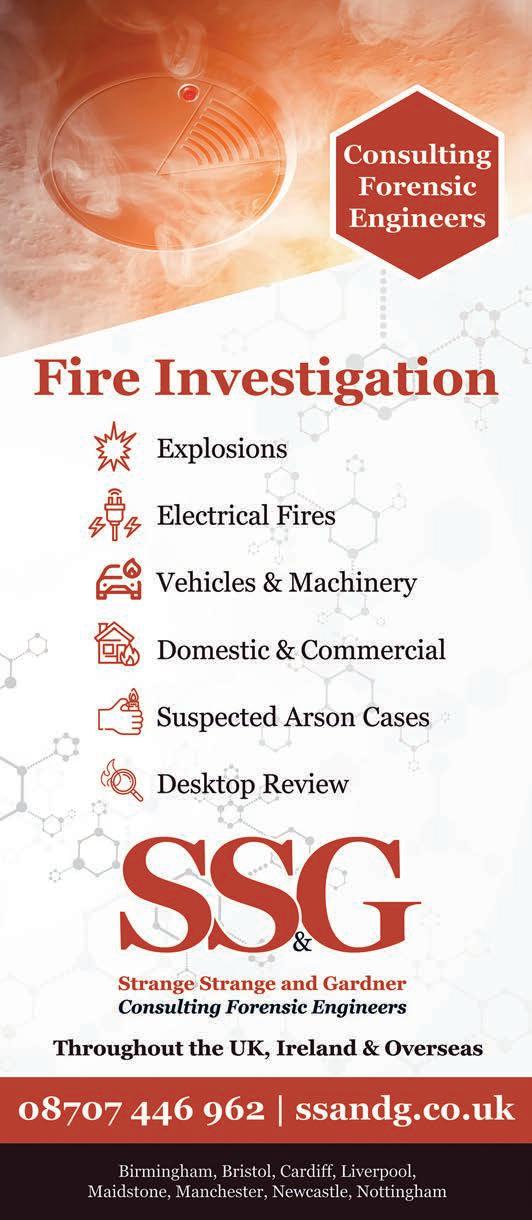

[ THE WORLD’S FLEET of 90,000 merchant ships keeps the planet moving.
According to the representative organisation Baltic Exchange, 90% of international trade is moved by sea: 10.7 billion tonnes of commodities and goods were transported in 2020.
While some high value, urgent goods are moved by air, shipping by sea is the most cost effective, efficient and environmentally friendly option for most cargo. However, ships are still carbon intensive consumers of energy. Like every other industry, the maritime industry is challenged to reduce its environmental impact on the planet.
Why do freight rates fluctuate?
Baltic Exchange explains how the market works. A shipowner will ‘charter’ their vessel to a cargo interest (the charterer) at the prevailing market rate. The contract between the owner and the charterer is the ‘charterparty’. Depending on the type of charter, the shipowner will generally earn a ‘dollar per day’ rate or a ‘dollar per tonne’ rate for the ship. The rate an owner can achieve for their ship is established by free market forces. Rates fluctuate depending on a range of factors. They include:
• Supply and demand - how many ships are available for charter at any one time
• General economic conditions and the state of global trade
• Seasonal trading patterns/industrial cycles
• Strikes and port delays which will tie up ships
• Vessel speed – slow steaming ties up more ships
• Vessel orderbook – lots of newbuilds can swamp the market
• Vessel recycling – lots of scrapping decreases supply
• Floating storage – storing commodities at sea will decrease vessel supply
It is in these areas that disputes can sometimes arise and a maritime expert may be called upon. q
[ THE BULK CARRIER SECTOR is being reshaped by a combination of stringent new regulations and digital innovation. But the changes are not just about compliance; they are about enhancing safety, efficiency and operational excellence.
That is according to Morten Løvstad, vice president and business director for bulk carriers at global assurance and risk management provider DNV, reported by Baltic Exchange’s Carly Fields. In particular, new regulations will soon apply to lifting appliances.
From January 2026 a new chapter to the SOLAS Convention will introduce much stricter oversight of lifting appliances. It is a critical regulatory change and moves the process under the formal SOLAS safety regime, replacing the previous International Labour Organization scheme, which allowed inspections to be carried out by any ‘competent person’.
As Løvstad notes, it is a direct response to a concerning trend: a rise in lifting-related accidents. The new rules require owners to implement structured maintenance and inspection regimes, maintain meticulous onboard records and ensure crew members are properly trained and familiar with the equipment. For existing vessels, compliance is required by their first renewal survey after the regulation takes effect, reinforcing a new era of accountability in onboard operations.
Beyond the hardware, the practice of cargo loading is also being modernised. A 2026 amendment to the Grain Code formally acknowledges a previously common but non-compliant practice: partially filling holds in the way of the hatch opening with untrimmed ends. That scenario, which often occurs when vessels reach their maximum draft before full hold capacity is achieved, has now been given a formal, safe framework for execution.

For newbuilds, the condition must be explicitly included in the grain loading manual and loading computer, while for existing vessels updates are optional but may be necessary to meet specific port requirements. For operators, this is a development that marries operational reality with regulatory compliance. The amendment, according to Løvstad, offers ‘greater flexibility without compromising stability’.
DNV is working on a project exploring the integration of AI for defect recognition and autonomous drone navigation with digital twins, promising inspections that are faster, more accurate and less intrusive than ever before.
Read the full report at www.balticexchange.com q


[SARAH SACKMAN KC MP, Minister for Courts and Legal Services, has responded to the Lost in Translation report published by the House of Lords Public Services Committee.
The 26-page response provides a detailed commentary on the committee’s recommendations, which were set out in the report published in March, reflecting the complexity of the issues raised.
The committee found that there is a clear disconnect between what the government hopes is happening, what the companies contracted to deliver the services believe is happening, and what frontline staff report is happening. With a lack of an effective complaints system, unreliable performance data and inadequate remuneration for interpreters, the service is not delivering for all involved, the committee said.
The chair of the committee, Baroness Morris of Yardley, said: “Significant problems across the end-to-end process of the provision of interpreting services in courts mean that the current system is ineffective and presents a significant risk of people suffering disadvantages during hearings because of language barriers.”
Welcoming the response from government, the Institute for Translation and Interpreting said: “However, there remain several areas where greater clarity and further information are required before we can assess whether the proposed ‘improvements’ to the current framework – outlined in the Minister’s covering letter –will meaningfully address the concerns of our members.
“We are actively engaging with our colleagues in the Professional Interpreters for Justice (PI4J) network to review the Government’s response in full and determine our next steps.” q
[PLANS TO BOOST and encourage the use of Gaelic and Scots have been passed by the Scottish Parliament. The Scottish Languages Bill will enable parents to ask for a Gaelic school to be established in their area. Local authorities would then be required to assess if the request was practical and affordable. After taking advice, ministers could direct local authorities to proceed with the establishment of a new Gaelic school if the authority’s assessment considers it to be viable.
Other measures in the Bill include:
• Introducing educational standards for Gaelic and Scots
• Establishing Gaelic and Scots as official languages
• Supporting the creation of areas of linguistic significance in Gaelic communities so that ministers can better target policies to support the language’s growth
• Enabling parents in every part of Scotland to apply for Gaelic nursery and early years places for their children
• Ensuring that more qualifications are available in Gaelic
• Introducing targets on the number of people speaking and learning Gaelic Deputy First Minister and Cabinet Secretary for Economy and Gaelic Kate Forbes said: “This legislation will introduce powers to accelerate the growth of Gaelic and Scots.
“While there has been an encouraging increase in the number of Gaelic speakers across Scotland, we recognise that more support is needed in communities where the language is traditionally spoken.
“That’s why the Scottish Government is providing an additional £5.7m to promote Scotland’s languages. We are also working to drive growth in Gaelic communities so that more people who speak the language continue to live in those areas.”
• Census statistics show that 130,161 people in Scotland had some Gaelic skills in 2022, an increase of 43,105 from 2011. The census shows that 2,444,659 people in Scotland had some Scots skills in 2022, an increase of 515,215 from 2011. q
by Rebecca Guthrie of Translate Hive
[ IN THE LEGAL FIELD, clarity and precision are nonnegotiable. A single misinterpreted word can have serious consequences, particularly in expert witness reports or court proceedings. That’s why more and more legal professionals across the UK are turning to Translate Hive, a trusted provider of accurate, court-approved translation and interpretation services.
Specialists in legal language
At Translate Hive, we specialise in written translations and live interpretation that meet the exacting standards of the UK legal system. Whether it’s expert reports, witness statements, case bundles or correspondence, our linguists are fully trained in legal terminology and produce work that is both accurate and admissible.
Fast turnaround, zero compromise
Speed is key. We know legal professionals often work under pressure, so our team is set up to deliver high-quality translations quickly, without ever compromising accuracy or compliance. Our streamlined process ensures your documents are translated promptly, often within tight turnaround times, while maintaining full alignment with court expectations.
Compliance you can count on
What sets Translate Hive apart is our absolute focus on compliance. Every translator and interpreter in our network is a qualified professional with native-level language skills and extensive experience in legal settings. All written translations are produced to meet official standards, ensuring they can be used confidently in court or shared with solicitors, barristers and expert witnesses.
Interpretation services you can trust
We also offer reliable interpreting services – both in-person and remote – for hearings, consultations and conferences. From family law to immigration tribunals and civil litigation, our interpreters are vetted, court-experienced and punctual.
Your partner in legal communication
So whether you need a fast turnaround on a certified translation or a dependable interpreter for an upcoming case, Translate Hive is ready to help. We’re here to ensure that nothing gets lost in translation – especially when it matters most! q
• For further information email customer.services@translatehive.com, call 0845 505 9961 or visit www.translatehive.com



[ THE SERIOUS FRAUD OFFICE (SFO) has issued a series of statements in response to the Supreme Court judgement in the cases of R v Hayes and R v Palombo
In the first statement, issued on 23 July, the SFO said: “Today’s Supreme Court decision comes 13 years after we first investigated the practice used by some traders and submitters at selected banks to influence key benchmark rates of interest in financial markets. These rates were called the London Inter-bank Offered Rate (LIBOR) and the Euro Inter-bank Offered Rate (EURIBOR), and they affected the value of hundreds of trillions of dollars’ worth of financial products around the world, including ordinary people’s pensions, mortgages and savings.
[ HMRC HAS NAMED a practising barrister as the architect of a number of tax avoidance schemes. It is the first time a barrister has been added to HMRC’s list of tax avoidance promoters.
It is HMRC’s view that Setu Kamal, who has 20 years of experience as a barrister, designed four tax avoidance schemes and created contract templates that are essential to how the arrangements operate.
The schemes – promoted by MLG Pay Ltd, The Umbrella Agency Limited, Veqta Ltd and Vision HR Solutions Ltd –typically promise workers they can keep more of their pay by avoiding Income Tax and National Insurance contributions.
HMRC’s position is that those arrangements do not work and that users of them face tax bills, interest and potential penalties.
Jonathan Smith, HMRC’s director of counter avoidance, said: “Legal professionals have a position of trust and responsibility – they shouldn't be involved in creating schemes that purport to let people avoid paying tax that funds our vital public services. We want to support those who have used these schemes to exit them and bring their tax position up-to-date. I urge them to contact us as soon as possible so they can settle their affairs.”
According to HMRC the naming shows that it will not just target the companies and businesses that promote and sell avoidance schemes, but also those who are behind them – no matter their status. Tax avoidance schemes are marketed as clever ways to pay less tax but rarely work as promised. Users often end up paying more than they originally tried to avoid.
Many of the arrangements operate through umbrella companies and workers in umbrella company schemes should check their payslips carefully. Warning signs include loans instead of wages, minimal tax deductions or complex payment structures. Workers can use a tool on GOV.UK to work out their pay from an umbrella company.
New legislation from April next year has been announced to tackle tax avoidance and fraud by umbrella companies. The new rules would make recruitment agencies that use umbrella companies legally responsible for accounting for PAYE on workers’ pay.
The full list of named tax avoidance schemes, promoters and enablers is available on GOV.UK q
“Our investigation led to nine convictions of senior bankers for fraud offences, with two of these individuals pleading guilty and seven found guilty by juries.
“This judgement has determined that the legal directions given by the judge to the jury at the conclusion of trial were incorrect in Hayes’s and Palombo’s trials and for that reason their convictions have today been found unsafe. We have considered this judgement and the full circumstances carefully and determined it would not be in the public interest for us to seek a retrial.”
On 29 August the SFO issued an update in which it stated: “We have a duty, as a prosecutor, to inform past defendants about any development that could affect their conviction. At this point, we have made an assessment on six individuals.
“We consider that, in five instances, the circumstances that led to Tom Hayes’s and Carlo Palombo’s appeals being upheld by the Supreme Court could apply to them, too.
We consider that the jury directions, given at Hayes’s and subsequently Palombo’s trial and which were the basis of the court’s judgement, may apply to Jonathan Mathew, Jay Merchant, Alex Pabon, Philippe Moryoussef and Colin Bermingham’s trials. Therefore, their convictions may be considered unsafe.
“For one individual, Peter Johnson, we have considered the judgement in respect of his guilty plea, and we consider that the conviction is safe.
“It is for each defendant to consider whether they wish to progress their case to the Criminal Cases Review Commission or the Court of Appeal.” q
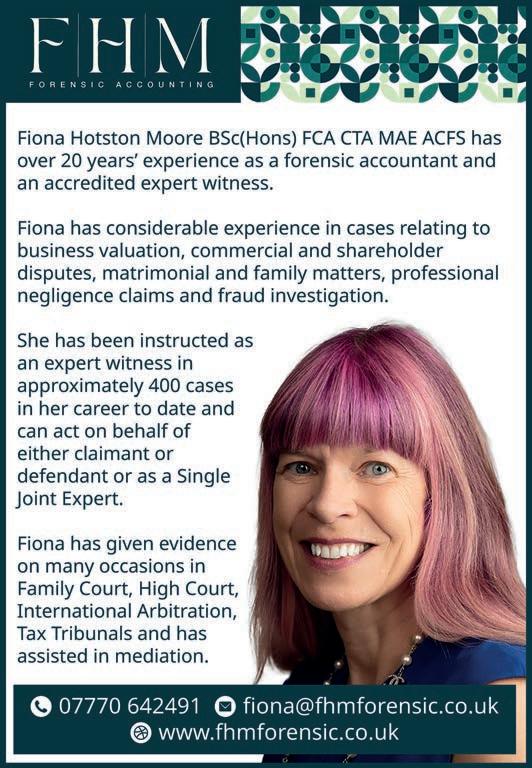
[A NEW CORPORATE CRIMINAL OFFENCE of ‘failure to prevent fraud’ came into effect on 1 September – designed to drive an anti-fraud culture and improve business confidence.
Introduced as part of the Economic Crime and Corporate Transparency Act (ECCT) 2023, the offence will hold large organisations to account if they profit from fraud. It forms part of wider measures introduced by the government to tackle fraud and protect the UK economy, as part of the Plan for Change.
The offence of ‘failure to prevent fraud’ follows major steps forward on fraud prevention including:

• Pushing forward with a ban on SIM farms – technical devices which facilitate fraud on an industrial scale
• A bilateral agreement with the insurance sector
• Adopting the first ever UN resolution on fraud
Under the new law, which was passed with cross-Parliament support, large organisations can be held criminally liable where an employee, agent, subsidiary or other ‘associated person’ commits a fraud intending to benefit the organisation.
Examples may include:
• Dishonest sales practices
• Hiding important information from consumers or investors
• Dishonest practices in financial markets
In the event of prosecution, an organisation will now have to demonstrate to the court that it had reasonable fraud prevention measures in place at the time the fraud was committed. The offence is
intended to encourage organisations to build an anti-fraud culture, in the same way that failure to prevent bribery legislation has helped reshape corporate culture since its introduction in 2010.
With recent ONS figures finding that fraud increased last year by 31%, the government has placed key focus on tackling the issue. Plans are developing at speed ahead of the publication of a new, expanded fraud strategy, which places tackling fraud against business at its heart.
Fraud Minister Lord Hanson said: “Fraud is a shameful crime and we are determined to bring those responsible to justice wherever it takes place. Today marks a pivotal moment for businesses, and this new offence strengthens our anti-fraud culture to protect businesses, build corporate trust and support long-term economic growth: a cornerstone of this government’s Plan for Change.
“I look forward to continuing our work with partners, as we publish our new, expanded fraud strategy, which places fraud against business at its heart.”
The Solicitor General Lucy Rigby KC MP added: “Fraud undermines our British values of fairness and playing by the rules. It hurts individuals and businesses and harms business confidence. This new legislation sends a clear message that large organisations must take responsibility for preventing fraud, and those that fail to do so will be prosecuted with the full force of the law.
“This government is committed to protecting our economy and we’re determined that those who don’t play by the rules will be brought to book.” q

[ LEGAL CASES involving repetitive strain injuries, musculoskeletal disorders or accidents related to poorly designed work environments often require detailed technical analysis. In these cases, the involvement of an ergonomics expert can be decisive in clarifying causation.
Expert witnesses specialising in ergonomics bring a unique perspective to legal proceedings. By providing objective, evidence-based insight, ergonomics experts can determine whether injuries were preventable and whether workplace design met relevant safety standards and regulations.
The value of an ergonomics expert lies not only in their technical assessment but also in the ability to communicate complex findings clearly to non-specialists. Solicitors, judges and juries rely on expert reports to understand the precise mechanisms behind an injury and the extent to which workplace or product design contributed. That independent analysis can influence settlement discussions, insurance claims or court judgments, providing clarity in disputes where responsibility and liability might otherwise be contested.
Early involvement allows for thorough site assessments, collection of objective data and preparation of robust reports that stand up to scrutiny in court. By combining scientific rigour with practical experience, ergonomics expert witnesses play a vital role in supporting informed outcomes in cases where workplace design, human factors and injury intersect. q

By Dr David Usher of Interaction of Bath
[ ERGONOMICS is about people and the work they do. It has been given various formal definitions since its inception in the 1940s, some of them helpful. The best so far is ‘the application of
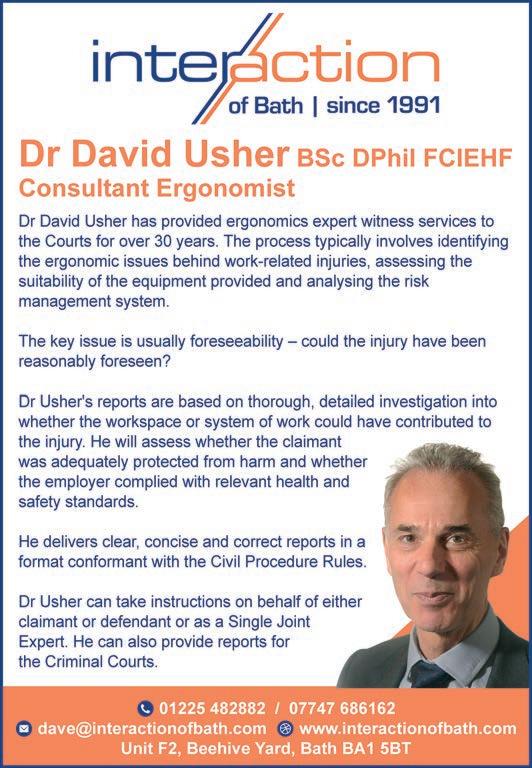
scientific information concerning humans to the design of objects, systems and environment for human use’.
However it is defined, ergonomics is clearly a very broad field. There is a huge variety of ways in which someone might interact with their equipment, their surroundings, their tasks and their colleagues. Ergonomists are concerned with most aspects of the human body: hearing (when considering noise hazard), vision (the sightlines to equipment), touch (vibration), strength (manual handling operations), anthropometry (reaches and posture) and mental workload (computer use).
Indeed, over the years, the scope of ergonomics has broadened to include ‘organisational’ factors – hours of work, work rotas and training – as well as ‘psychosocial’ ones such as perceived work stress and poor work clarity. The important concept here is the ‘safety culture’ of the organisation: the extent to which concern for health, safety and well-being forms a natural part of working life.
In the future, we can expect ergonomics to embrace ethical issues such as the extent to which AI can or should be relied upon for a lifeor-death decision – known as the ‘trolley problem’.
With an increasing focus on occupational health and employer liability, legal professionals are turning to ergonomics experts to provide authoritative assessments on causation, risk and preventative measures.
An important document when considering the culpability for workplace injury is the risk assessment. That is a list of the credible hazards, with their frequency – the estimated number of occurrences per year, not just ‘unlikely’ – and their severity: the number of resulting sick days, not just ‘mild’. The risk, usually in the range A to D, is a combination of the frequency and severity of each hazard; but the important point often missed is that the risk should be reduced, if practicable – whatever it turns out to be. Very few risk assessments meet those criteria.
Inevitably, computer applications have been developed for ergonomic analysis. Perhaps the most advanced and multi-featured is the task modelling tool ‘aTTAin’. This tool supports hierarchical task analysis, 3D object modelling and task animation, to give a comprehensive and rapid analysis of sightlines, reaches, speech intelligibility, noise and optimum pathways in the workspace.
Ergonomics is not just about chairs! q
Alan Binns of Plough Geotechnical Ltd explains why opting for the cheapest quote is seldom the best policy
[A LARGE PROPORTION of my work involves sorting out misunderstandings caused by clients going for the cheapest quote.
A geotechnical engineer is concerned with the behaviour of soil and rocks when their loading conditions are altered. That can involve a load increase or a load decrease: ie the building up or reduction of soil levels for a development platform or for a road or railway embankment.
The geotechnical engineer is involved with:
• Specifying and supervising the investigation of the site and
• determining the soil/rock properties of the in situ materials and also
• how those properties change during the works
• Carrying out adequate analyses to ensure stability of the
• development and to keep settlement or heave to acceptable levels
• Specifying the siteworks of construction, making sure that the
• material properties are specified correctly and that the works carried
• out have achieved them
To carry out all of those tasks to the specification requires a suitable standard of technical knowledge, for example a B Eng, a good level of suitable training of analysis and contract specifications under close supervision in the office, and on site work experience under close supervision. Those latter two take time and money.
Unfortunately, because of the time available, supervision can be rushed or very light. Staff can make mistakes because the importance of each clause in a specification is not understood or explained in enough detail.
A big part of the problem is down to cost. Clients often choose the cheapest tender. That can mean:

• Sometimes the client delays appointing an engineer to save cost,
• which means that all the stages of investigation, analysis,
• specification and construction are rushed, with insufficient time to
• improve methods for each job.
• Inappropriate methods of site investigation, soil sampling and
• testing are selected because they are cheapest.
• The analysis looks detailed; but, as most of that is carried out by
• spreadsheet or computer software, if supervision is not close
• enough then the analysis may not be appropriate.
• Often a new graduate is put onto site and has to ‘stand up’ to a
• contractor’s site foreman with many years of experience; or the
• client is only willing to pay for ‘part time’ site control.
The problem is complex but would be improved if engineers were brave enough to persuade clients to go for the best solution. If they do not, then my work as a geotechnical engineer expert witness will carry on for many years to come. q

[GROUND-RELATED DISPUTES can take many forms. Subsidence, for instance, can have devastating consequences for property owners and developers alike, with costly repairs, delays and insurance claims following structural failure.
Experts in geotechnical engineering and foundation assessment are crucial in these cases, providing detailed investigations to identify underlying causes – whether related to soil composition, drainage issues, nearby construction activity or natural ground movement. Their evidence allows legal teams to distinguish between pre-existing conditions and damage caused by third-party actions or negligence, which can be decisive in determining liability.
Contaminated land claims and environmental disputes are also on the rise. Increasing awareness of environmental regulations and heightened scrutiny from agencies have brought issues such as soil contamination, hazardous material handling and remediation obligations into sharp focus.
Experts in contaminated land assessment and environmental risk evaluation can provide comprehensive reports detailing the extent and severity of contamination, assessing potential health or ecological impacts and advising on appropriate remediation strategies. That expertise ensures that courts and insurers understand the technical realities of environmental harm, including compliance
with regulatory standards and long-term management requirements.
Experts are also increasingly being involved proactively, advising legal teams early in the dispute process. This early engagement allows for thorough risk assessment, evidence gathering and case preparation – often resulting in more effective strategies and reducing the likelihood of protracted litigation.
Multi-disciplinary expertise is often required, combining knowledge of geotechnical engineering, environmental science, construction management and regulatory compliance, to provide a holistic view of complex claims. q
[IN JULY the Highways Department of Buckinghamshire County Council posted a story of how it dealt with a sinkhole that opened up in the A413 in Great Missenden. Although not on the scale of the more widelyreported chasms in Merthyr Tydfil and Godstone, the story of the discovery of the cause and its repair are an illustration of ‘what lies beneath’.
On 1 July, Buckinghamshire Highways received an out-of-hours emergency call regarding a hole that had appeared on the A413 in Great Missenden. It was a large hole (pictured right), that was potentially very dangerous for drivers on the busy road.
According to the post: “That evening, and through to the next day, detailed investigations were carried out, with the road and our crews protected by a lane closure using two-way traffic lights. This included the use of ground penetrating radar and CCTV. It appeared the sinkhole had been caused by localised water ingress – the unwanted presence of water in openings or structures. However, whilst investigating the sinkhole, we found what we believed to be an old defunct drainage channel almost 2m under the road surface, running across the A413.”

The discovery of the old defunct drainage channel (pictured below) led to the council’s archaeology officer becoming involved, to record and map the feature as part of the council’s Historic Environment Record.
“It was clear that the channel pre-dated the road and perhaps was associated with the formation of the turnpike road in the 18th century,” the post continued. “We did not consider there to be any immediate safety issues concerning the depth of the feature found. It was, however,

important that this was addressed to preserve the future structural integrity of the A-road, so works were planned with immediate effect.
“Early on Saturday 5 July we closed the A413 to carry out a full repair of the sink hole and reinstate the old drainage channel. This required excavating down to 2.2m across the extent of the carriageway, filling in the old drainage channel and reinstating the road surface. We also worked closely with utility companies already operating nearby to co-ordinate efforts and minimise disruption and liaised with HS2Ltd/Align on the emergency works, recognising that this is a key construction route.”
On Monday 6 July the road was re-opened by 6am, in time for the morning rush-hour traffic. q

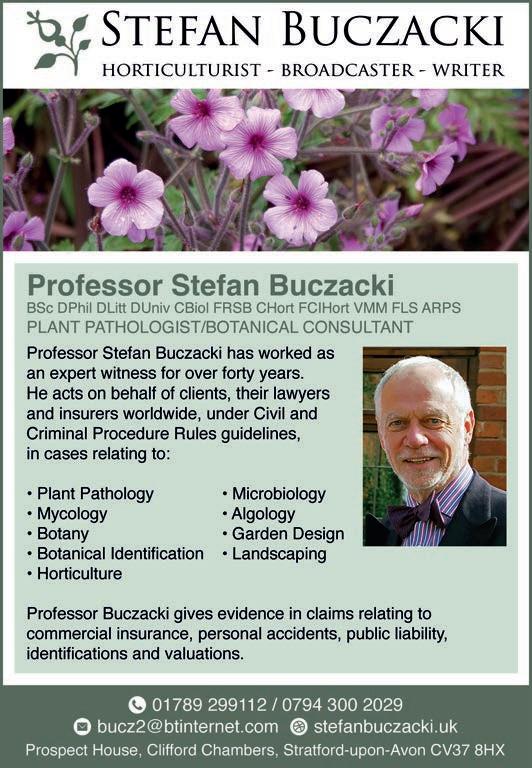
[PLANT PATHOLOGY EXPERTS are increasingly sought after in legal cases that involve environmental damage, invasive species, crop failure, property disputes, land contamination and biodiversity concerns. Legal professionals and insurers require specialist knowledge to navigate the complex scientific and technical aspects of such cases, particularly when claims involve substantial environmental or economic impact.
Experts in plant pathology provide authoritative insight into a wide range of areas, including plant disease diagnosis, biosecurity breaches, soil-plant interactions and the effects of pests, pathogens and environmental stressors.
Their input can be critical in determining causation, assessing the severity and spread of disease or contamination, and advising on remedial or preventative measures. In situations where land, agricultural production or natural habitats are affected, expert evidence can make the difference in understanding liability, mitigation and long-term management strategies.
Professionals with experience in plant diagnostics, mycology, agronomy, forestry or biosecurity are ideally positioned to support solicitors and insurers managing technically complex cases. Their expertise allows for precise assessment of environmental impact, evaluation of agricultural losses and identification of biosecurity failures, helping legal teams present clear, credible and scientifically robust arguments in court. q

Mark Hinnells, director of Susenco Consulting Ltd, ponders the implications of the ICJ Advisory Opinion on Obligations of States in respect of Climate Change
[ON 23RD JULY the International Court of Justice CJ passed an Advisory Opinion on Obligations of States in respect of Climate Change.
The opinion has clearly not been issued in isolation. It sits alongside a history of Intergovernmental Panel on Climate Change (IPCC) reports published since 1990, with increasingly urgent scientific evidence. It supports the Paris Agreement 2015 targets to limit warming to 1.5 to 2 degrees Celsius, implying a halving of greenhouse gas emissions by 2030, and net zero emissions by mid-century. Governments are currently in their third round of making Nationally Declared Contributions (NDCs) towards the Paris Agreement.
At the corporate level the opinion complements reporting obligations on climate change impacts, risks and opportunities, required of most listed companies by most stock exchanges, as well as a range of mechanisms to price emissions, including carbon taxes or trading schemes. There 1,989 cases of current or previous litigation relating to climate in the US, and 1,129 across 55 countries in the rest of the world . The opinion could be material in current and future cases.
In that context there are implications both for international and national UK policy.
A summary of the judgement
The judgement sets out:
• A right to a clean, healthy and sustainable environment is a
• fundamental human right. Climate change is an ‘urgent and existential
• threat’ to humanity and the planet.
• States are legally obligated to prevent significant harm, in good faith
• and with urgency, and co-operate to address it.
• Failing to deliver strong policy to contribute towards the Paris
• Agreement, or to regulate private actors, could constitute a wrongful act
• under international law.
• Responsible states may be required to provide reparations (restitution,
• compensation and satisfaction) to injured states or parties.
• Greenhouse gas emissions have no borders: states may be held
• responsible even for emissions that harm people beyond their borders.
• Emissions are also cumulative.
• Though non-binding, the opinion carries moral and legal weight.
International implications
The main effect, therefore, is to increase legal jeopardy for governments or corporates who ignore the need to act. That said, while all 193 UN member states are automatically parties to the ICJ Statute, the US, Russia, China and Iran are among countries who do not fully support or recognise the ICJ, and are four of the largest polluters or exporters of fossil fuel. Of those, only China is showing real leadership on climate issues.
As of now, the second round of NDCs proposed by signatories to the Paris Agreement achieve only a 2% reduction in emissions and risk an estimated 2.6-2.8 degrees Celsius temperature rise. A 43% reduction is needed from signatory NDCs, due before COP30 in November, to achieve the 1.5 degree Celsius goal. Arguably, the real intent of the opinion, coming as it does now, is to nudge governments to make meaningful policy in their third round of NDCs towards the Paris Agreement.
In addition, governments collectively will come under pressure at COP30 and beyond to spend more on the New Collective Quantified Goal (NCQG) – a key element of the Paris Agreement – to support developing countries in their climate actions.
There will also be more pressure on common mechanisms developed by the International Civil Aviation Authority (ICAO) and the International Maritime Organisation (IMO) to reduce emissions from international

aviation and shipping, which sit outside the NDC process and are almost in the ownership of trade bodies, with particular criticism aimed at the Carbon Offset and Reduction Scheme for International Aviation (CORSIA), which is not Paris Agreement compliant.
Financial markets such as stock exchanges, plus lending, insurance and pensions products, are international. Pensions in one country can hold globally diverse assets. Large companies trade in more than one jurisdiction. The opinion will build pressure on financial markets, both through IFRS reporting obligations and in the reconsideration of Fiduciary Duty owed by a decision maker to an investor in the context of climate change, where the opinion will influence best practice.
The opinion will build pressure on commercial valuations, especially of oil companies, with significant risk to investors. We simply cannot burn all proven probable and possible fossil fuels, because of the climate impacts: the concept of ‘unburnable carbon’ is more than a decade old.
The UK now produces less than 1% of global greenhouse gas emissions, but as the cradle of the industrial revolution the UK has emitted around 3% of all man-made greenhouse gas emissions.
The UK has been a global leader in policy to decarbonise with the UK Climate Change Act 2008 (as amended), although delivery has not matched ambition and the government has twice been found to be in breach of its targets. The UK Climate Change Committee, set up with a statutory duty to advise government, has as recently as June 2025 confirmed that, for 40% of expected emissions reduction ‘there are either significant risks, or insufficient or unquantified plans’. It is conceivable the UK could fall significantly short of its planned net zero pathway, and thus of its obligations under the Paris Agreement 2015.
Again, a particular point of pressure will be oil and gas, with implications for decisions on new extraction, both to consent by government or fund by banks or other investors. The opinion will be material for consenting and funding infrastructure (airports, ports, roads, rail etc) which imply additional emissions that are material in the context of UK carbon emissions targets.
Thus far, human rights cases have been much more likely to find climate change to be a material issue than judgements in commercial cases – and the ICJ opinion continues that well-established theme. Generally, decisions under commercial law recognise boards have competing interests to balance – eg between shareholders, employees, customers and over different timeframes.
Courts are loathe to interfere with board decisions, regardless of whether the board is in favour of more aggressive ESG or climate action or is seen by shareholders as not progressive enough on ESG and climate action. That relatively laissez faire attitude can only last so long, since international and national targets are now so clear and obligations seen as transnational. The ICJ opinion is another indicator in that trend.
At some point courts will decide that boards have to meet national and international targets and therefore must make decisions accordingly on reporting, investments, rewards and hiring decisions. In some domains, such as the US, that may be delayed but is unlikely to be avoided.
In conclusion the ICJ Opinion adds legal opinion to scientific fact in the IPCC reports since 1990, to commitments in the Paris Agreement and to a raft of policy.
Any dissonance between international or national obligations, targets and delivery – whether that be at government level, board level or under Fiduciary Duty – is going to cause friction. Friction might require advice or arbitration in the first instance, or potentially litigation. At Susenco we would be very pleased to help with finding a resolution. q
[ A RECORD 81 criminal investigations into water companies have been launched in England since the election, the Environment Agency has reported. A new operation spearheaded by Environment Secretary Steve Reed amounts to the largest criminal action against water companies in history.
The number of inspections carried out by authorities into sewage pollution has rocketed by nearly 400% since last July. That record number of Environment Agency spot checks at water company premises and rivers has revealed widespread lawbreaking. Over 80 criminal investigations have been launched against water companies over the last nine months, a surge of 145% since the election.
Following the investigations, water bosses could be jailed for five years and water companies fined hundreds of millions of pounds. That, it is hoped, will act as a powerful deterrent, focusing water bosses’ minds on investing to upgrade water infrastructure to clean up our rivers, lakes and seas. Water companies will also spend a record £104bn and cut sewage discharges by nearly half over five years.
Environment Secretary Steve Reed commented: “Water companies have too often gone unpunished as they pump
record levels of sewage into our waterways. No more. A record number of criminal investigations have been launched into lawbreaking water companies – which could see bosses behind bars.
“With this government, water companies who break the law will finally be punished for their disgraceful behaviour so we can clean up our rivers, lakes and seas for good.”
When a water company breaks the rules of its environmental permit, that is a criminal offence – for example, releasing excessive pollution into a river or failing to carry out water quality monitoring.
The Environment Agency follows up on every offence they find. The most serious offences, like illegal sewage spills, trigger a criminal investigation that could see water company fines and criminal prosecution for water bosses. The Environment Agency have also taken a zero-tolerance approach to identify and resolve over 1,000 minor issues last year, like unclogging pipes to deliver immediate improvements to local communities and the environment.
Philip Duffy, chief executive of the Environment Agency, said: “This milestone is testament to our determination to hold water companies to account and achieve a cleaner water environment. Our message
to the industry is clear: we expect full compliance throughout the water system, and we will not hesitate to take robust enforcement action where we identify serious breaches.
“This is just the beginning: we are on track to deliver 10,000 inspections next year, using our tougher powers gained through the Water (Special Measures) Act, alongside more officers and upgraded digital tools to drive better performance across the water sector.”
To drive forward the surge in action, the Environment Agency has hired 380 additional regulatory staff to carry out inspections and other enforcement activity.
New powers, delivered by the Water (Special Measures) Act 2025, also mean water executives who cover up or hide illegal sewage spills can now be locked up for up to two years.
The Environment Agency are also currently carrying out their largest ever criminal investigation into potential widespread noncompliance by water companies at over 2,000 sewage treatment works.
Seven cases against water companies will be going to court over the next few months following criminal investigations by the Environment Agency. q

[
EXPERTS IN waste management and environmental compliance provide authoritative advice on a wide range of matters. They include interpretation and application of the Environmental Protection Act, transfrontier shipments of waste, the quality and handling of refuse-derived fuel and performance failures in PFI-funded waste infrastructure projects.
In many cases their input is essential in assessing compliance with environmental regulations, determining the cause and impact of operational failures and evaluating whether duty of care obligations have been met. The evidence they provide can significantly influence legal strategy, liability assessment and the ultimate resolution of disputes.
Legal professionals and insurers require their specialist knowledge to navigate the technical, operational and regulatory complexities inherent in this sector, ensuring that cases are accurately assessed and defensible outcomes are achieved.
Professionals with experience in waste treatment technologies, environmental engineering, resource recovery and regulatory compliance are particularly well placed to support legal teams in highstakes, technically complex cases. They can evaluate the design, operation and performance of waste infrastructure projects, provide independent opinions on compliance and industry best practice and advise on the potential environmental and financial consequences of failures or breaches.
Their analysis is critical when assessing contractual obligations, regulatory compliance and the potential for reputational or financial damage to organisations involved in waste management.
By providing detailed, evidence-based analysis, expert witnesses enable solicitors and insurers to make informed decisions, present credible arguments and achieve defensible outcomes. Their
involvement ensures that environmental, operational and legal considerations are fully addressed, helping to protect clients’ interests while maintaining adherence to statutory and regulatory standards. In an industry subject to intense regulatory scrutiny and public attention, the insights of experienced waste and environmental experts are invaluable in ensuring that complex cases are handled with precision, professionalism and technical authority. q
[A MERSEYSIDE skip hire boss has been ordered to pay back £250,000 after she was found to have profited from illegal waste crime. The Environment Agency secured the confiscation order against Patricia Hills of Bootle, after she was previously jailed for operating MWM Recycling Ltd illegally. The confiscation hearing under the Proceeds of Crime Act took place at Liverpool Crown Court on 1 September. The hearing followed the conviction of Hills for illegal waste activity. At Liverpool Crown Court in March 2022, she was jailed for a year and banned from being a company director for five years.
Jeni Brittlebank, area environment manager for the Environment Agency, said: “This sends out a message to the industry that waste crime does not pay and not only will we hit people with court action, but we’ll hit them in the pocket. Illegal waste operations carried out in the interests of profit are at the expense of the environment, put communities at risk and undermine legitimate businesses that work within the law.” q

By Mark Chester, of Cedarwood Tree Consultants
[ THIS YEAR marks 25 years since I began working as a tree consultant and 23 since my first court experience relating to trees. I have been reflecting on some of the notable cases I have been involved with as an expert.
One aspect that remains important, but which is often overlooked, is that of reviewing evidence. That is in addition to proof reading or checking grammar. It involves a detailed reading of a statement or a report to ensure it reads well and flows. It isn’t about changing context, but about ensuring clarity.
Reviewing evidence can be very helpful, especially at an early stage, before submission. That includes witness statements. I ensure that my own reports are reviewed by a member of my team who is good at details – but not a specialist – before each report is issued. That is more than checking for quality control within an internal audit process. It includes ensuring that a reader can understand what the writer is seeking to convey; that it makes sense.
I have been involved with several cases that have reached a formal hearing, at which stage the evidence can be subject to a detailed critique during cross-examination of witnesses. During these, sometimes quite intense, occasions lack of clarity can become very evident. Highlighting such lack of clarity early on in the process can enable reviews to be undertaken.
In one case I reviewed a boundary hedge had been damaged during farming activities and the owner was seeking costs to replace it with a new hedge. They presented a statement written by their gardener in which he had described his duties, which included trimming the hedge to ensure it was tidy. As I read the statement, having visited the site and gained an understanding of the key issues, I realised that the text was not as clear as the claimant thought. The site included two hedges which were subject to different management.
I suggested that the claimant read the statement again. It was then that they realised it was vague – and the author had been vague in describing the setting. An addendum may have helped in that case, but by the time I was involved, and had seen the statement, the gardener was no longer so familiar with the site. Sadly for the claimant, their case was not successful, with the uncertainties of the gardener becoming very apparent under cross examination.
In another case a tree was uprooted during unseasonably inclement weather, damaging part of the garden of the neighbouring property. The tree was on land owned by a local authority and had been subject to a safety inspection some months


before the incident, with some pruning works to be implemented later on. The evidence of the inspector was key to the case. The tree was growing on a slope and so the inspection on the upper side, especially around the base of the tree, was limited. That was a key part of the inspector’s statement.
When I visited the site some time after the incident it was evident to me that the uprooting was not due to decay of the tree or its roots, there being a notable absence of dead wood. The claimant’s case was that the inspection should have been more detailed, and that he should have excavated the part of the tree that was buried. As I read the statement of the inspector, and that of the claimant’s expert, the vagueness of the former’s statement was evident. I also observed that the claimant’s expert seemed to be pursuing an adversarial position.
Under cross examination the inspector was able to clarify and explain that he did not observe any decay. He then described in more detail the setting, which explained his decision making: it now made sense. The statement was presented to me later in the case and the defence team reflected that, had the clarification been made before the hearing, matters may have been resolved without the need for a hearing.
In another case, where I had been presented with a witness statement providing an account of events leading to tree failure, being able to present my queries to the legal team enabled them to raise them with a key witness, who then realised that what they had written was not a clear account of events. It can be easy to miss key details when reflecting.
One important aspect of the early review of evidence is to ensure it is all presented to the court in a timely manner. In one hearing, involving enforcement, the prosecution stated that the defence could have appealed an application for consent to fell trees subject to the enforcement action. The defence had actually appealed, but the key appeal document remained in their office and not in the court bundle.
As I have reviewed some of the cases from 25 years of surveying trees, and 23 as an expert, and reflected on my own development, the importance of the evidence has become increasingly clear. I need to do my own research. That is specifically important when it comes to the weather, especially if that is associated with a claim.
Storms are often cited as the cause of tree failure. I have access to detailed weather information from across the UK for each day and each hour of the day. That can provide clarity very quickly.
I recall one of my earlier case where, following the failure of a tree, which caused a road traffic accident, the defendants cited a storm on the day of the incident. I was soon able to determine that there was indeed a storm on that day, but more than 100 miles from the tree! The defendant in that case settled shortly after receipt of my report.
While vagaries in a statement may be important limitations in a case, the absence of a statement can be equally key. For the case just cited, with the storm being 100 miles away, the defendant had employed a ‘tree surveyor’ to inspect the trees some months before the incident. I use inverted commas to describe the surveyor because their conclusion, having walked a site with dozens of trees, was a two line e-mail to confirm that they had not observed any issues. In that case, a lack of professional input in managing the trees was evident.
It is important to read one’s own work, but also to ensure that it makes sense to a lay person. Most cases involving an expert witness will require evidence to be read by a lay person. If the evidence, from the expert or witnesses, is clear and unambiguous, a case is better presented. Otherwise, providing an updated draft may be necessary. q




















COLLISION INVESTIGATION & RECONSTRUCTION
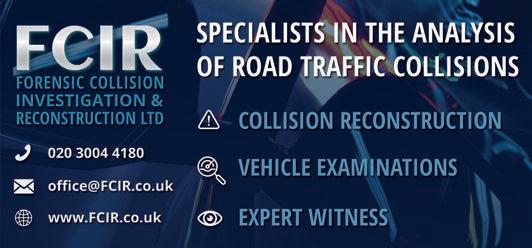
COMPLIANCE CONSULTANTS

COMPUTER & MOBILE FORENSICS


CRIMINOLOGY

DIGITAL TECHNOLOGY



ENERGY CONSULTANTS

ENGINEERS

EQUESTRIANS








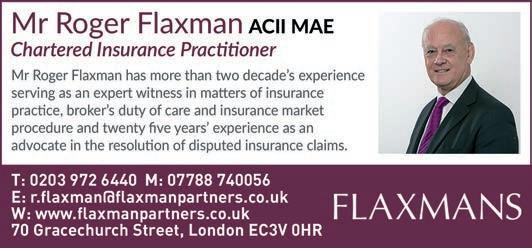





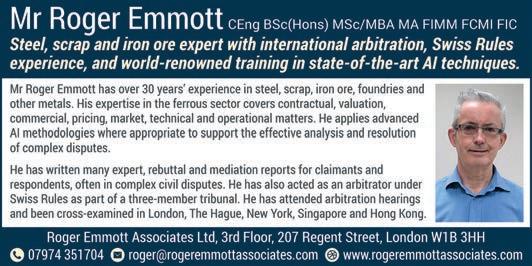







Translations and Interpreting for the Legal Profession since 1997. Specialists in Personal Injury and Clinical Negligence. www.abc-translations.co.uk
Andrew F Acquier BA FRICS
Chartered Art & Antiques Surveyor
Expert witness reports and representation at court for matters involving:
• Divorce settlements • Insurance valuation disputes • Arts litigation
• Contentious Probate • Associate member of Resolution for many years
www.andrewacquier.co.uk
David Berry PhD FRC Path MFSSoc MRSC
Independent Toxicology Consultant
Specialist in Clinical and Forensic Toxicology with particular emphasis on drugs (both illicit and therapeutic) and alcohol. www.toxicologyservices.co.uk
Professor Paul J Ciclitira MB PhD FRCP MRCS FRCP AGAF
Professor of Gastroenterology with particular interest in food allergy, including Coeliac disease, peptic ulcer, inflammatory bowel disorder and hepatology. www.profpaulciclitira.co.uk
Dr Sarah Cockbill Expert Pharmaceutical Witness
PhD BPharm MPharm LLM DAgVetPharm FRPharmS FVPA
• Pharmacology • Drug Interactions • Formulation
• Appropriate Dosage • Veterinary Pharmacy • Drug Licensing Instructions for claimant, defendant or as Single Joint Expert
E: cockbills1@gmail.com
Mr Philip Coleridge Smith DM MA BCh FRCS
Consultant Vascular Surgeon
20 years of:
• Defendant instructions • Claimant instructions
• Single joint expert • Court experience





www.adsummedicolegal.com & www.britishveininstitute.com
Clarke Gammon
Chartered Surveyors with experience in All Aspects of Property • Residential property values
• Asset valuations • Land values and more www.clarkegammon.co.uk
Chris Dawson MS FRCS LLDip

Consultant Urologist with 20 years experience of medico legal report writing and expert witness work and has completed over 1,850 reports. He also regularly completes Fitness to Practice reports for the General Medical Council.
www.chrisdawson.org.uk
DRC Forensics Limited


DRC Forensics Limited offers the complete range of forensic accounting & litigation support: • Fraud • Money laundering
• Partnership disputes • Loss of profit • Professional negligence www.drcforensics.co.uk
Mr Mark Duxbury MA (Oxon) DM FRCSEd (Gen Surg)
Consultant Hepatobiliary, Pancreatic & General Surgeon
• General & emergency surgery • Hernia surgery
• Liver & pancreatic surgery
• Gallbladder & biliary surgery
• Laparoscopic surgery • Hepatobiliary surgery www.markduxbury.info/medicolegal
Equip2Speak
Specialists in Brain and Spinal Injury. AT Consultant
• CUBS Certified Expert since 2012 • Accident, Negligence and Criminal Cases • Experienced in High Value Claims
• Claimant/Defendant/Joint Instruction
www.equip2speak.co.uk
Face Restoration
• Complications of cosmetic eyelid surgery
• Brow lift surgery • Ptosis • Non-surgical aesthetics
• Orbital diseases • Watery eyes • Thyroid eye disease www.facerestoration.com
FHDI - Kathryn Thorndycraft-Pope




Examining documents & handwriting • to determine authenticity • to expose forgery • to reveal aspects of origin. Electro Static Detection Apparatus and Mi-Scope used. www.forensichandwriting.co.uk
Mr Roger Flaxman ACII MAE
Chartered Insurance Practitioner with more than two decade’s experience serving as an expert witness in matters of insurance practice, broker’s duty of care, insurance market procedure and as an advocate in the resolution of disputed insurance claims.
www.flaxmanpartners.co.uk

Forensic Collision Investigation & Reconstruction Ltd
Specialists in the analysis of road traffic collisions
• Collision Reconstruction • Expert Witness
• Vehicle Examinations www.FCIR.co.uk
Formedecon Ltd
Forensic & Investigative Services to the Legal Profession
• All Aspects of Forensic Work Undertaken



Griffin Forensics eForensics and Data Recovery Experts
• CCTV Recovery and Analysis • Computer Media Investigations • Mobile Phone Extraction and Analysis • Forensic Data Recoveries
• LAA and Privately Funded • Free Estimates www.Formedecon.com www.griffinforensics.com
Mr Kim Hakin FRCS FRCOphth
Consultant Ophthalmic Surgeon and Expert Witness on ophthalmological matters
www.kimhakin.com


Dr Dan Jones PhD MSc BSc MA MEWI Cert Ecological Consultant – Japanese Knotweed. Undertakes expert witness instructions, including the preparation of expert reports and giving evidence in court, in civil claims relating to the growth and spread of all invasive plants.
www.advancedinvasives.com
Haydn Jones MEng DipLaw FIET
Data Technologist & Digital Regulation Expert
• Injunctive relief • Money laundering
• Digital currency theft
• Counter funding of terrorism E: h.jones@xchain.com


Atul Khanna FRCS (Plast)
Consultant Plastic, Reconstructive and Hand Surgeon
• Hand surgery • Soft tissue injury • Burns management
• Medical negligence in cosmetic surgery www.atulkhanna.co.uk/expert-witness/
Dr Raj Kumar – Dental Expert
Causation and Liability and Condition and Prognosis Reports
• General dentistry • Cosmetic dentistry • Patient consent
• Dental implantology • Orthodontics • Facial aesthetics
07802 456 804 | info@dentalexpert.me | www.dentalexpert.me
Kulvinder Lall Consultant Cardiothoracic Surgeon Instructions taken in cases relating to cardiac and thoracic surgery, including aspects relating to surgical care and those following trauma to the structures of the chest. www.kulvinderlall.com
Maggie Sargent & Associates
Internationally renowned provider of detailed and independent medical expert witness reports. We consistently provide our solicitors with meticulously prepared and highly trusted reports that put the client at the centre.
www.maggiesargent.co.uk
Mr Chris Makin
• Chartered Accountant • Accredited Civil Mediator




Andrew Smith FPC III CeMAP
Financial Conduct Authority Compliance & Risk Consultant
Cases relating to FCA compliance in consumer credit and mortgage lending.
• Mediation • Arbitration • Adjudication • Expert Determination

Mr Bernard Speculand MDS FDS FFD FRACDS (OMS)
Consultant Oral and Maxillofacial Surgeon. Personal injury and clinical negligence cases for claimant, defendant and as Single Joint Expert. Special interest is TMJ Surgery.
Yvette Young (Secretary) T: 0121 605 1884
E: info@medsecadmin.co.uk www.birminghamtmj.co.uk
Dr Ian Starke MSc MD FRCP
Stroke Medicine and Medicine for the Elderly
Reports and examinations for clinical negligence and fitness to practise cases in stroke medicine and geriatric medicine www.expertwitnessinstrokes.co.uk
Mr. William E G Thomas Bsc, MBBS, FRCS, MS
Consultant Surgeon specialising in general surgery, hernia surgery, gastrointestinal surgery, hepatobiliary-pancreatic surgery, laparoscopic surgery and endocrine surgery T: 0114 262 0852 E: wegthomas@btinternet.com W: www.wegthomas.com

Mr Richard Matthews MB BS FRCS FRCSE MAE PLASTIC & HAND SURGEON
Mr Matthews is well versed in the provision of Medical Reports relating to Personal Injury ranging from scarring through trauma, including burns and scalds, to non-bony hand injuries.
• Accredited Expert Determiner www.chrismakin.co.uk www.richardmatthewsmedicolegal.uk
Mr Abraham Odumala
MBBS M.MedSci FWACS FRCS FRCS(Tr & Orth)
Consultant Orthopaedic Surgeon – Upper Limb Specialist. Expertise in all upper limb conditions and treatment. Shoulder, elbow, wristand hand injuries. www.yorkshire-upperlimb.co.uk
Dr Shanthi Paramothayan
BSc PhD MBBS LLM MScMedEd FHEA FCCP FRCP
Consultant Respiratory Physician specialising in negligence cases relating to all aspects of respiratory medicine. www.paramothayan.com
Dr Stuart Porter Chartered Physiotherapist
PhD MCSP HCPC BSc Hons Grad Dip Phys MLACP PgCAP Cert.MHS SFHEA Specialist areas of expertise include: • Clinical negligence
• Breach of duty • Allegations of inappropriate contact
Simon Quinton Smith BSc FRICS MI Hort
Expert Witness to the Garden Centre & Horticultural Industry
• Rent Reviews
• Lease Renewals
• Assessment of adults and children • HCPC investigations. stuartbporter@aol.com www.quintonedwards.co.uk
• Valuation
• Planning




• Compensation
• Tax Issues
Mr Sameer Singh MBBS BSc FRCS Orth
Consultant Orthopaedic Surgeon • All aspects of trauma – soft tissue and bone injuries • Upper and lower limb disorders and injuries
• Whiplash injuries • Expert Witness for defence and claimant Clinic locations – London, Milton Keynes and Bedford
www.orthopaedicexpertwitness.net






UK Ophthalmology Experts
Dr Ravinder Varaich Dental Expert
BDS (University of Birmingham) MFGDP (RCS Eng) MAE
> Criminal cases > Personal injury > Clinical negligence

• Restorative dentistry • Periodontal disease • Endodontics • Dentures
• Oral surgery • Orthodontics • Cosmetic dentistry • Facial aesthetics
DR S V MEDICALS (Mr Sen Venkat)
UK Ophthalmology Experts are a team of leading, independent ophthalmology experts covering all aspects of ophthalmology. ukophthalmologyexperts.co.uk www.dentalexpertreports.co.uk

MSc Ortho (London) FRCS Consultant Orthopaedic Surgeon • Whiplash injuries • General trauma • Sports injuries
WOODEXPERTS
Specialist Timber Consultancy and Training since 1991
• Site visits & investigations • Structural surveys
• Desktop analysis & review of documents
• Specialist reports • Species identification
• Clinical negligence work • Joint replacement surgery of hip and knee • Hand, shoulder, elbow and wrist injury www.drsvmedicals.co.uk www.woodexperts.com
Ms Leyla Ziyal MPhil AFBPsS CPsychol
HCPC Registered clinical Neuropsychologist
• Neuropsychological assessment and rehabilitation
• Depression • Occupational stress • PTSD • Anxiety www.accentpsychology.co.uk www.paxen.co.uk




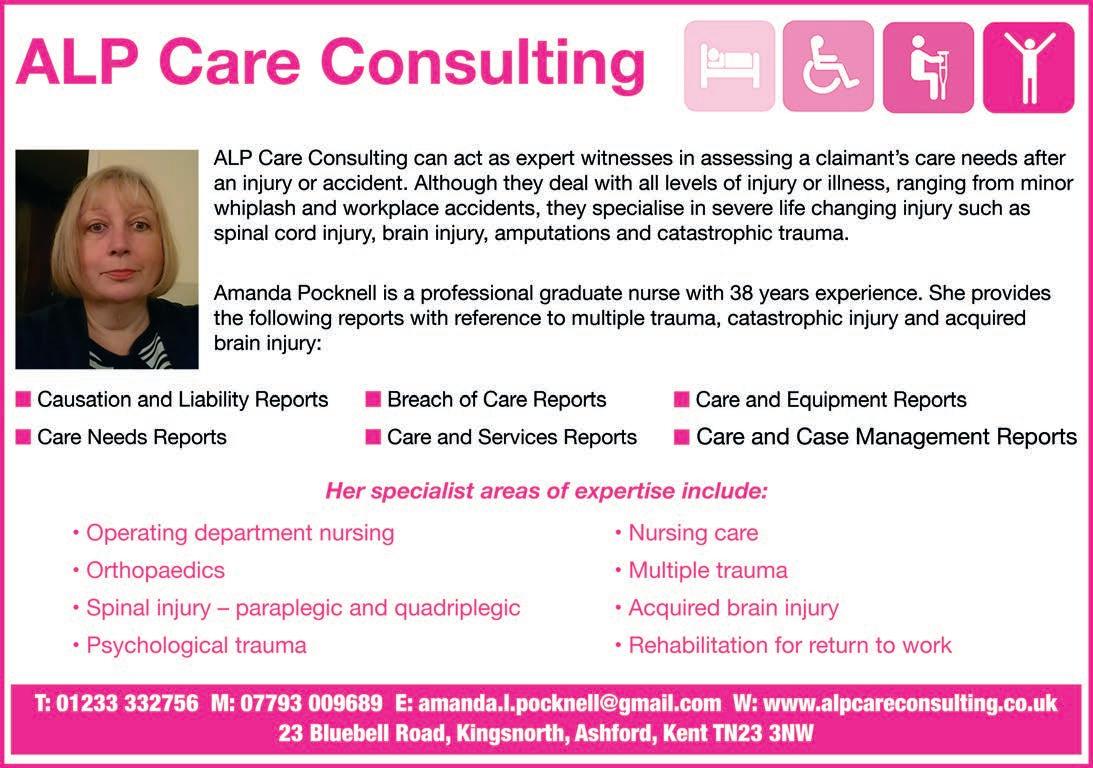


[ADDRESSING SHORTCOMINGS in the NHS is still the focus of government action. A new flagship league table of trusts has been announced that aims to allow local citizens to compare their trust with those in the surrounding area. So far the league table is only encompassing acute, non-acute and ambulance trusts, but will be expanded next year to cover integrated care boards and other NHS organisations.
• Patients’ satisfaction with their hospital stay has been the subject of surveys by the Care Quality Commission since 2002. This year’s survey is encouraging in that it shows consistently high levels of satisfaction with patients’ relationship with staff and even a slight improvement in overall experience. Satisfaction levels in some areas are not so positive and the overall picture still lags behind pre-COVID levels.
• Some areas of care are, however, far from where they should be. A number of investigations into maternity services have led the government to set up a general investigation into maternity provision across England. Baroness Valerie Amos recently announced the 14 trusts that will be participating in the inquiry. Some are those which have been named as in need on improvement, while others are beacons of good practice.
• A review that has already been published is that of Dr Penny Dash into patient safety. The review was tasked with evaluating the performance of six organisations engaged with ensuring or contributing to patient safety in England. It can be inferred from the fact that there are six of them that Dr Dash found a ‘cluttered landscape’, making it difficult to disentangle who does what.
• If all that seems to paint a depressing picture of NHS performance, there are definite areas where pats on the back are in order. One such is in heart care, where waiting lists seem to be on the decline. The number of people waiting more than 18 weeks fell from May to June, the latest period for which figures are currently available. The number is still too high, however, leading to needless deaths.
• Another cause for cautious optimism is cataract surgery, the most frequently performed procedure in the NHS. The rate of the major complication of surgery – posterior capsule rupture, or PCR – has more than halved since 2014. As treatment options have improved, this major cause of sight loss is being slowly vanquished.
• Unfortunately, not every element of healthcare can boast an upward curve. When Sir Brian Langstaff published the results of his inquiry into the infected blood scandal he must have thought his job was done and the compensation scheme would begin to issue redress. Not so: the number of people contacting him with stories of feet-dragging and obfuscation prompted him to issue a further, follow-up report. The government has now responded to that follow-up report.
• Mental health is still in a state of crisis, particularly in Scotland. The British Psychological Society, as part of a coalition of mental health organisations, has called on the next Scottish Government to take ‘bold and decisive steps’ to address what it describes as that country’s ‘mental health emergency’. The call comes ahead of the elections to the Scottish Government next May.
• It’s rare that care in an NHS hospital is the subject of a police manslaughter investigation, but that is what is happening in Blackpool. Those of us living in the North West have been following the saga of Blackpool Victoria with increasing incredulity.
• That has been the story of the summer. Emergency departments have been stretched and patients are being treated in the backs of ambulances. In the words of Dr Adrian Boyle, president of the Royal College of Emergency Medicine: “If this is summer, what will winter be like?” q

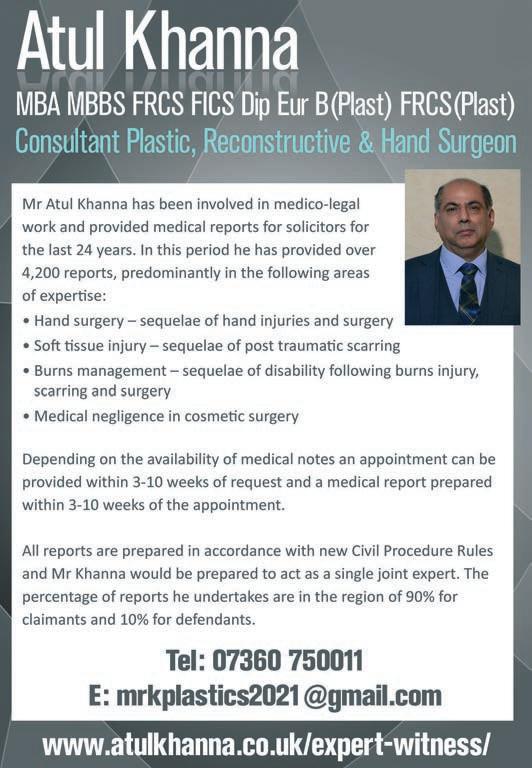

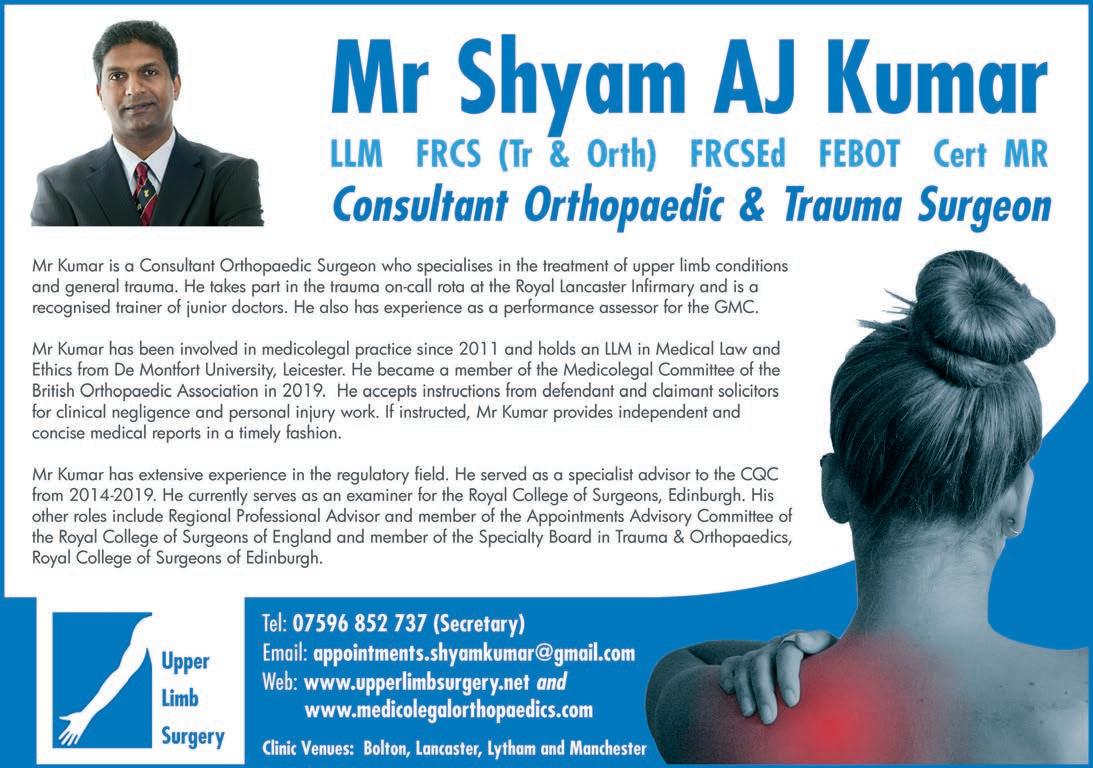
[PATIENTS WILL GET BETTER CARE and value from record investment in the NHS thanks to a pioneering new system of league tables being rolled out across England, according to the Department for Health and Social Care (DHSC).
Every trust in England will be ranked quarterly against consistent standards: from urgent and emergency care to elective operations and mental health services. It marks a new era of transparency and accountability in the NHS, the DHSC says, with league tables delivering on the government’s promise to drive up standards, tackle variation in care and ensure people get the high-quality service they rightly expect.
“This is not just about data,” the department said in its announcement, “it’s about delivery. The public expect results from the record funding going into the NHS, and this reform ensures that investment is matched by improvement. That is why top-performing trusts will be rewarded with greater autonomy, including the ability to reinvest surplus budgets into frontline improvements such as new diagnostic equipment and hospital upgrades.”
From next year, a new wave of foundation trusts will be introduced, giving the best-performing trusts more freedom to shape services around local needs - a key pillar of the government’s 10 Year Health Plan. Meanwhile, trusts facing the greatest challenges will receive enhanced support to drive improvement, with senior leaders held accountable through performance-linked pay. The best NHS leaders will be offered higher pay to take on the toughest jobs, sending them into challenged services and turning them around.
The move is aimed at helping end the postcode lottery in care, ensuring patients receive timely, high-quality treatment wherever they live. Patient feedback will also play a central role in how trusts are ranked, giving people a stronger voice in shaping their care.
Health and Social Care Secretary Wes Streeting said: “We must be honest about the state of the NHS to fix it. Patients and taxpayers have to know how their local NHS services are doing compared to the rest of the country.
“These league tables will identify where urgent support is needed and allow high-performing areas to share best practices with others, taking the best of the NHS to the rest of the NHS.
“Patients know when local services aren’t up to scratch and they want to see an end to the postcode lottery: that’s what this government is doing. We’re combining the extra £26bn investment each year with tough reforms to get value for money, with every pound helping to cut waiting times for patients.”
The new league table, known as the National Oversight Framework (NOF), is part of a series of bold reforms to make the NHS fit for the future by increasing transparency and delivering better outcomes for patients.
Trusts will be scored into four performance segments, with the first segment representing the best performing areas and the fourth segment showing the most challenged. To enable fairer comparisons, separate league tables are published for acute, non-acute and ambulance trusts.
Those trusts in middle segments of the tables will be encouraged to learn from top performers to help them improve on their rankings, so they too will be able to financially benefit from their budget surpluses in the future.
According to the DHSC: “A trust’s segmentation classification is the overall assessment of an organisation’s performance. Differences in average performance of trusts near to each other in the league tables are also unlikely to be significant and could be marginal.
“Rankings should only be used as a guide to where an organisation roughly sits amongst its peers, rather than a definitive judgement of whether one trust is considered to be ‘better’ than another.”

Unlike Care Quality Commission assessments, the NOF measures relative rather than absolute performance. NOF segments are initially determined by performance quartiles. This means that there will always be 25% of trusts in each, regardless of improvement or deterioration in performance.
Sir Jim Mackey, chief executive of NHS England, said: “NHS staff across the country work flat out to deliver the highest standard of care to their patients and every day we see or hear fantastic examples of this; but we still have far too much unwarranted local variation in performance.
“Letting patients and the public access more data will help to drive improvement even faster by supporting them to identify where they should demand even better from their NHS and by putting more power in their hands to make informed decisions on their choice of provider.
“The data also supports local NHS trust boards and leadership teams to more easily identify the highest performing services in the NHS and adapt how they deliver care to drive improvement even faster going forward.”
The league tables deliver on a key commitment in the government’s 10 Year Health Plan to improve transparency, reward high performance and intervene to address poor performance across the NHS.
By summer 2026, the tables will expand to cover integrated care boards – NHS organisations responsible for planning health services for their local population – and wider areas of NHS performance. q


[THE BRITISH MEDICAL ASSOCIATION (BMA) has expressed its disappointment after a legal challenge to the GMC’s failure to regulate PA (physician associates) and AA (anaesthesia associates) was rejected by the High Court. A judicial review brought by the doctors’ campaign group Anaesthetists United (AU) and supported by the BMA has been dismissed on all grounds following the handing down of a judgment on 4 September.
The case had sought to challenge the medical regulator’s approach to regulating PA/AAs, asserting that it had acted irrationally by refusing to issue a scope of practice for those staff or ensure informed patient consent or adequate supervision in their use.
The case also argued that the GMC failed to comply with its duty of inquiry, by failing to gather and consider sufficient information to address the question whether it should introduce safe and lawful practice measures.
In bringing the legal challenge, Anaesthetists United were joined by Marion and Brendan Chesterton, whose daughter Emily died in 2022 after being misdiagnosed by a PA who she had believed to be a GP.
In her judgment, however, Ms Justice Christina Lambert rejected claims that the regulator had acted irrationally; nor had the GMC failed to comply with their Tameside obligations, given they had ‘embarked on an extensive research program to inform the development of its professional standards and guidance to be applied to associates...’
The Tameside obligation is the principle of judicial review that requires public bodies to take reasonable steps to inform themselves before making a decision.
A spokesperson for the GMC said: “Our thoughts remain with the Chesterton family. Today, our regulation of associates – supported by a robust system of registration –ensures they are safer and better equipped to carry out their duties and can be held to account if they pose a risk to patients or public confidence.
“We welcome the decision of the High Court to dismiss the claims on all grounds and we are pleased the court found our approach when considering how we would regulate associates, and our decision not to impose limits on their practice, was coherent and rational.”
Responding to the judgment, BMA council chair Dr Tom Dolphin said that, while he was ‘disappointed’ at the outcome, the case had nonetheless highlighted the fact that medical opinion overwhelmingly supports nationally agreed scopes of practice for association staff in the interests of patient safety.
Dr Dolphin also paid tribute to Anaesthetists United and to Marion and Brendan Chesterton for their bravery and determination in bringing forward the legal challenge.
He said: “This is a disappointing outcome. The case was rightly brought by Anaesthetists United and the family of Emily Chesterton following the failure by the GMC to act on the overwhelming consensus of doctors that there should be a clear scope of practice that sets safe limits on what physician assistants can and cannot do. That consensus is still correct even though the court today decided that who sets scope is not a matter for a court of law.
“We thank Emily’s parents Marion and Brendan for their bravery in bringing this case, and the many doctors who supported AU directly by providing funds to ensure it could be heard. We remain proud to have stood by AU, the wider medical profession and the Chesterton family, and are sorry that today’s outcome didn’t deliver the outcome we all wanted.
“It is important to make clear that the court has not vindicated the GMC’s refusal to set a scope or adopt scopes set by others. Instead, it has simply stated the GMC’s decision not to do so was not unlawful. The GMC should take no comfort in this outcome. The prevailing weight of medical opinion agrees that nationally agreed scopes of practice will protect patients, and that the GMC has a role to play to ensure that when these are set, they are enforced.
“Along with AU and the Chesterton family, the BMA will be considering next steps in relation to this regrettable ruling.” q


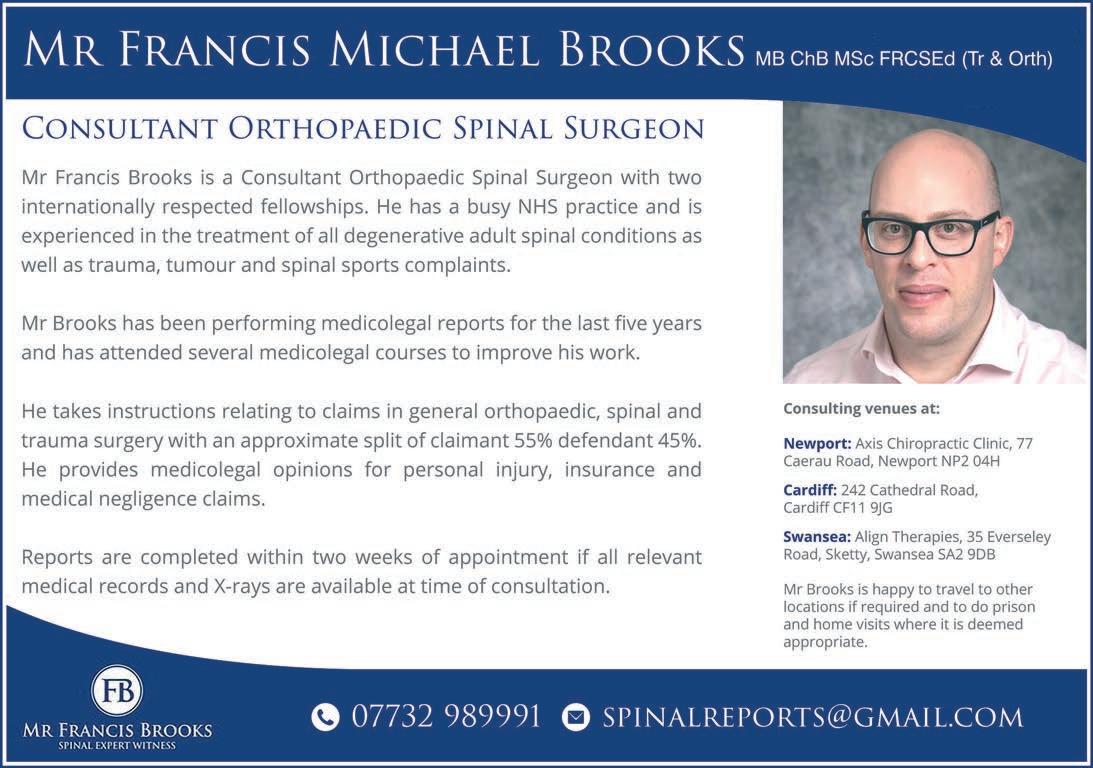
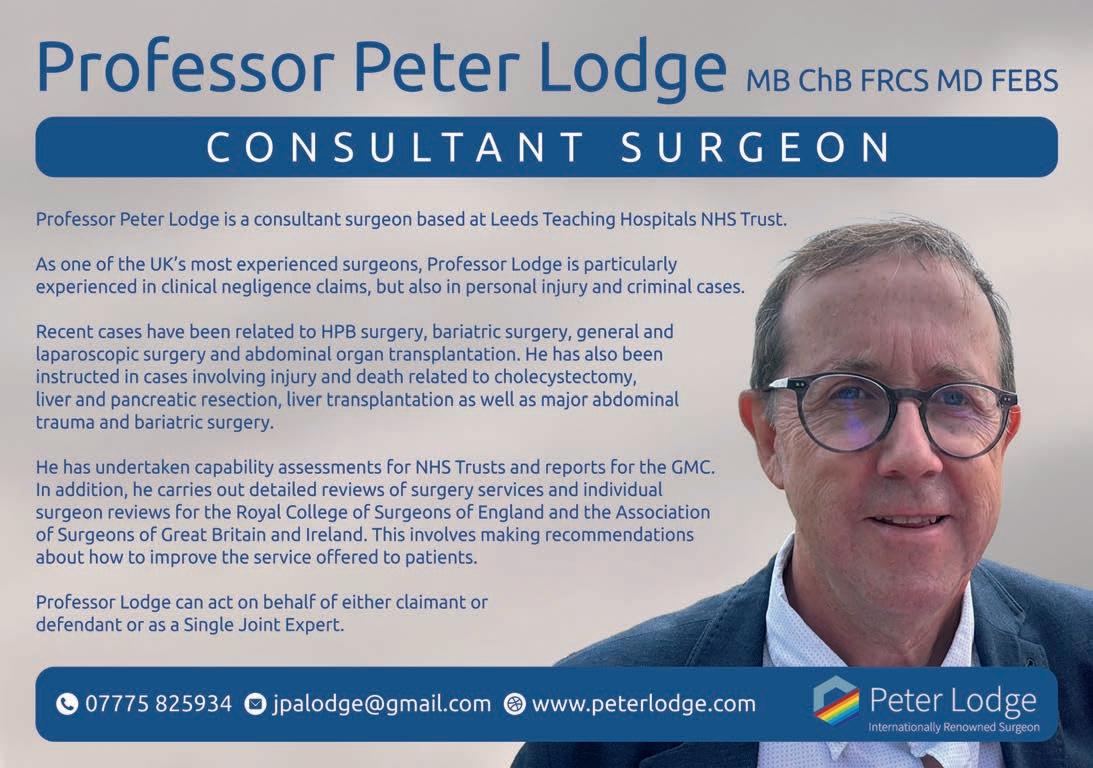
[ON 7 JULY the government published Dr Penny Dash’s review of patient safety across the health and care landscape in England. It was commissioned by the Secretary of State for Health and Social Care, following a review into the operational effectiveness of the Care Quality Commission (CQC) in summer 2024.
The review was asked to look at six specific organisations that were established to either assure – or contribute to improving – the safety of care, while also making reference to the wider landscape of organisations influencing quality of care. Those six organisations were CQC, the Health Services Safety Investigations Body, Patient Safety Commissioner, National Guardian’s Office, Healthwatch England and Local Healthwatch, and the patient safety learning aspects of NHS Resolution.
It was asked to consider whether there are overlaps and gaps in functions across organisations, and make recommendations as to the future roles of the six organisations.
The review was established against the background of an increasing focus on the safety of care over the past 10 years, with a number of highprofile failures – for example in Mid Staffordshire NHS Foundation Trust.
The reaction to them has typically been to set up a public inquiry or review into what went wrong, with subsequent recommendations for changes that often establish new organisations and bodies external to the mainstream work of the commissioners and providers of care. That led to a growth in the number of organisations considering safety and the wider quality of care, with the resulting impact of even more recommendations and a cluttered landscape.
The review is seen as a first step in considering where change could most appropriately be made.
In the executive summary of the report, Dr Dash states: “Poor management of care contributes to unsafe care, ineffective care and poor user experience. Research from 2019 found that poor or inadequate management results in a 5% efficiency gap. Applying this to NHS trusts, it is a cost of over £5bn each year, which equates to 330,000 quality-adjusted life years (QALYs) using Department of Health and Social Care estimates of cost per QALY.
“More recent analysis suggests that productivity in acute hospitals has declined since financial year 2019 to 2020 by about 8%. This equates to around £6bn per year or around 400,000 QALYs.”
She draws five principal conclusions from her findings:
• Action is needed to address gaps in functions. In particular, a strategic approach to improvement and innovation in quality of care (including safety) is needed that considers allocation of resources to maximise outcomes and co-ordinates and prioritises the very many recommendations and ‘asks’ of providers.
• There is a need to streamline, simplify and consolidate functions where considerable duplication and overlap currently exist: specifically when it comes to user, patient or community engagement, capturing and learning from user or patient experience
– the ‘voice of the user’ – and investigations.
• Too many functions sit outside of the commissioners and providers of care who are ultimately responsible for improving quality (including safety). That results in limited impact from the very many inquiries, reviews, investigations and resulting recommendations that are made.
• Within commissioners and providers, there needs to be a far greater focus on building skills and capabilities, effective governance structures and clearer accountability for quality (including safety) of care.
• CQC was established as the independent regulator of health and care. It needs to rebuild public, professional and political confidence, and should also house functions where independence is required.

From those conclusions she makes nine recommendations for improvements.
Responding to the review, Rebecca Hilsenrath KC (Hon), chief executive of the Parliamentary and Health Service Ombudsman, said: “Disentangling the complex and overlapping world of patient safety organisations will improve the way the NHS functions and how it responds when things go wrong. Streamlining these organisations was a key recommendation of our Broken Trust report and the Dash Review has recognised how this would better support the delivery of high quality care.
“I welcome the importance placed on managing and learning from complaints and on building on our NHS Complaint Standards, which set out how organisations should respond to complaints. A well-handled complaint can be pivotal in driving lasting change and improving care for all.
“We look forward to working with partners to strengthen the use of the standards so that more NHS organisations get it right first time for patients and families.” q
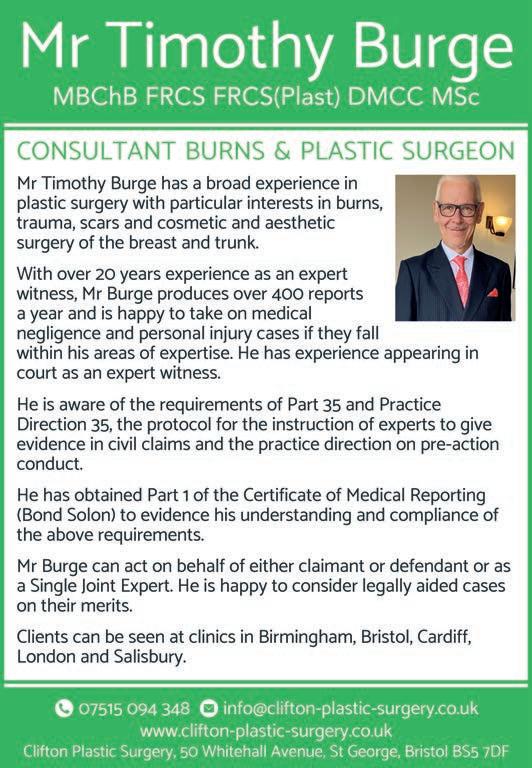

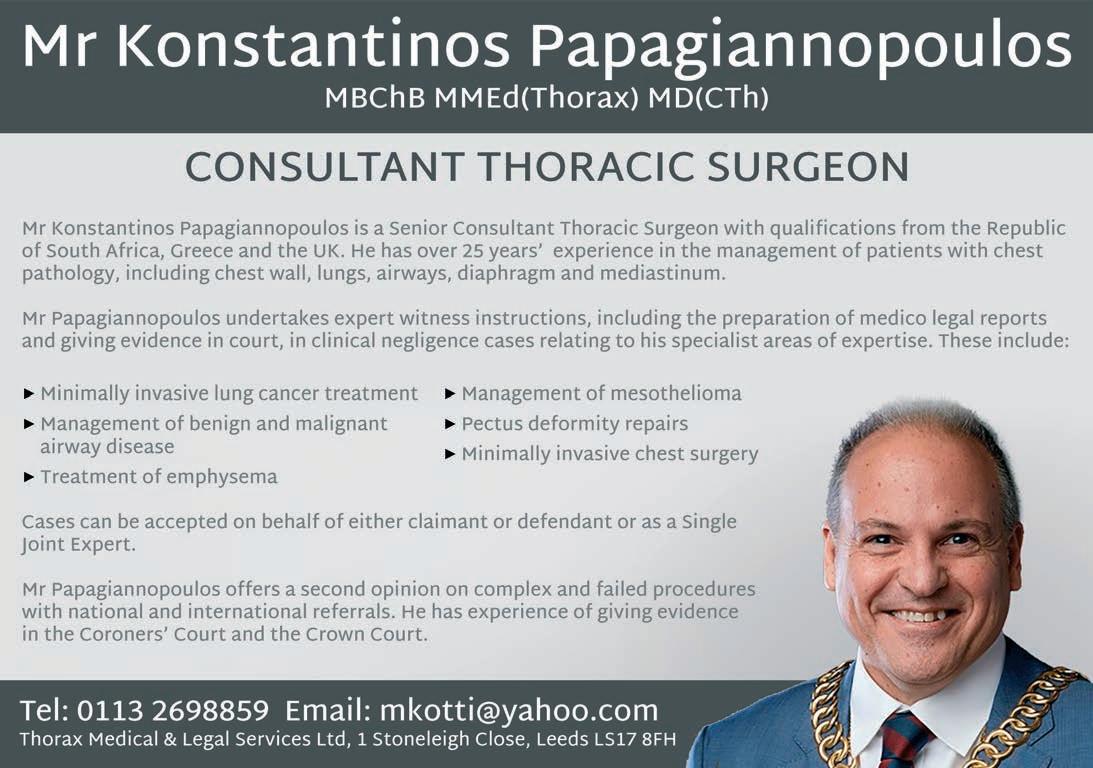
[
NUCLEAR POWER STATIONS in the UK do not seem to be linked to risk of childhood cancer, according to a major new study. The latest study, commissioned by the UK Committee on the Medical Aspects of Radiation (COMARE), has examined cancer incidence near to nuclear power installations between 1995 and 2016. It was carried out by researchers from Imperial College London and the University of Bristol.
The research team examined the geographical spread of nearly 50,000 cases of cancer in children under the age of 14. Those cancers include leukaemia, non-Hodgkin’s lymphoma, central nervous system cancers and other solid tumours. The researchers say they used advanced statistical modelling to search for signs of increased incidence within 25 kilometres of nuclear power stations.
The team concluded that there was no evidence that children living near nuclear power installations have an increased cancer risk compared to children living elsewhere in Great Britain.
The researchers say that there have been investigations in the UK and Germany over the past 40 years following reports of clusters of childhood cancer around power stations. Studies failed to find links between radiation exposure and cancer risk – although a report from COMARE in 2016 suggested the mingling of populations, associated with migratory workers, might be an explanation.
The findings have been published in the International Journal of Epidemiology
[DATA PUBLISHED IN JULY by the GMC reveals that more than one in five trainee doctors have felt hesitant about escalating patient care. The GMC’s 2025 national training survey, the UK’s largest annual insight into medical training, surveyed over 71,000 doctors and trainers.
For the first time it asked about escalation of care, a critical safety issue. While 79% of trainees reported never feeling apprehensive, 21% said they had hesitated at least once in the past 12 months. The figure rose to nearly a third in specialties such as surgery, obstetrics and gynaecology, medicine and emergency medicine. Those most hesitant to escalate care were also more likely to experience burnout.
Professor Pushpinder Mangat, medical director and director of education and standards at the GMC, said: “These findings are extremely concerning because doctors need to work in environments where they feel comfortable escalating. When they don’t, there are potentially serious risks to patient safety.
“The Government’s 10-Year Health Plan rightly recognises that a modern health service must empower its workforce and foster a culture of openness and safety. The GMC is committed to supporting this transformation and playing our part. The national training survey is one of several vital data resources we produce to help to identify where change is needed and ensure that training environments are safe, inclusive and fit for the future.”
The majority of trainees remain positive about their training, with 76% saying their teaching was good or very good and 87% rating their clinical supervision highly.
Professor Mangat added: “Our data and workforce insights can support governments and organisations across the UK as they look to drive improvements to ensure that every doctor can thrive. We will continue to share our findings to help address concerns, celebrate good practice and play our part in building a workforce that is confident, supported and ready to deliver the health services of the future.” q

Study leader Dr Bethan Davies, from Imperial College London, said: “As the UK government announces a multibillion-pound investment for new nuclear energy infrastructure, our findings should provide reassurance that the historical clusters of childhood cancers reported near sites such as Sellafield and Dounreay are no longer evident.” Fellow researcher Professor Mireille Toledano added: “These findings are both timely and important. As the UK and other countries expand their nuclear energy capacity, it’s vital that public health remains a central consideration. It’s reassuring that our study found that the historic case clusters have resolved, but it remains important we continue to monitor public health data around such sites across the UK for any emerging trends of concern.” q
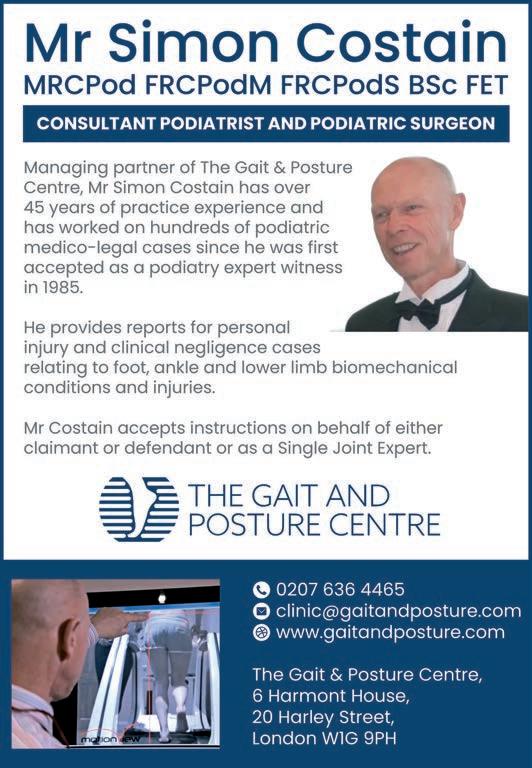

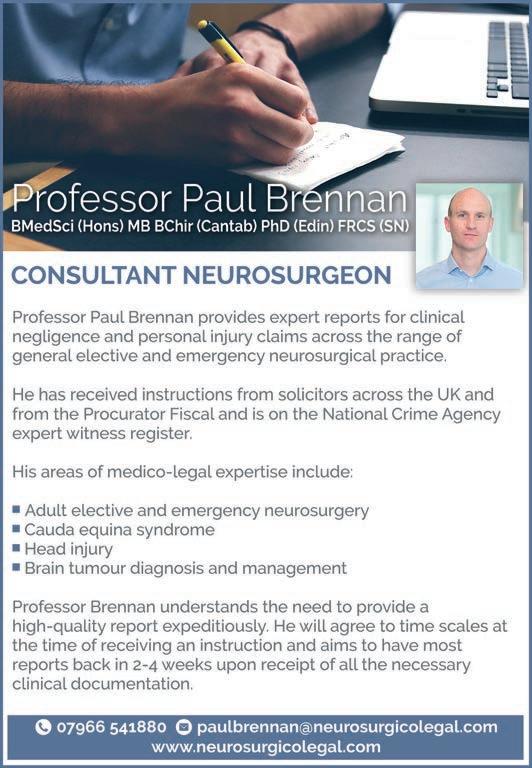
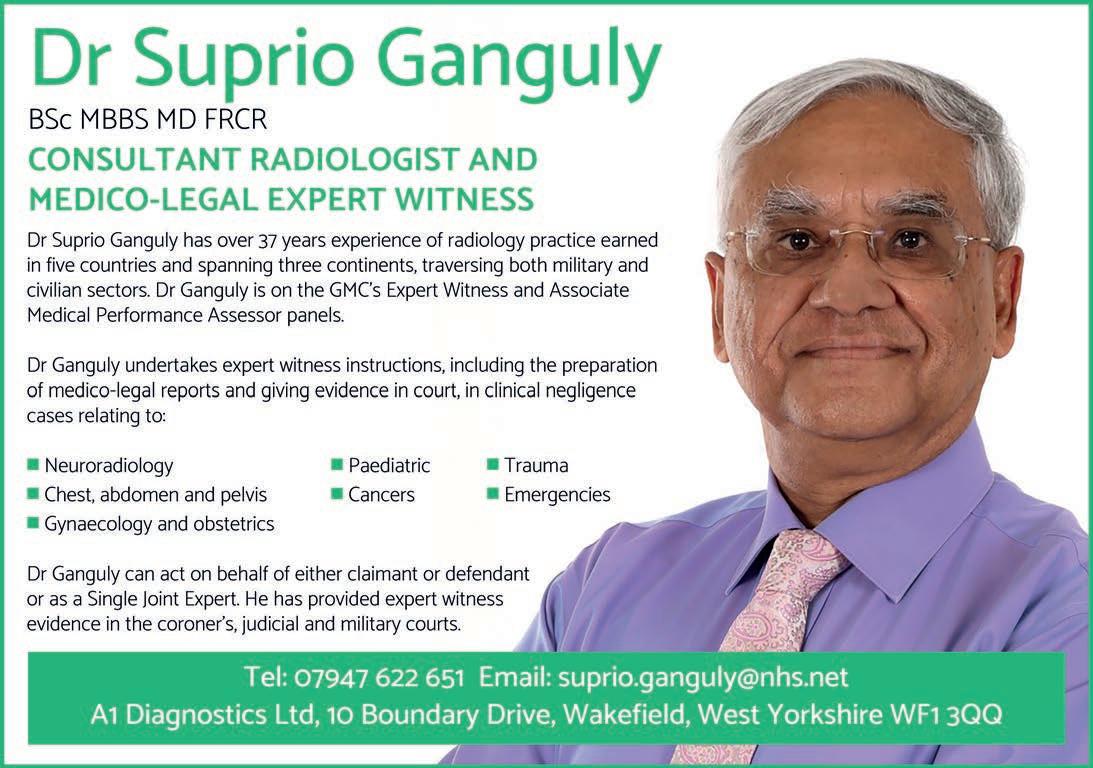
[THE RESULTS of the latest annual survey of hospital in-patients, published on 9 September by the Care Quality Commission (CQC), reveal that patient satisfaction levels have continued at a consistently high level in the past year. Indeed, a greater number of respondents rated their ‘overall experience’ as nine or 10 out of 10. However, the results still indicate that many aspects of in-patient care are worse than pre-pandemic and show that waiting times and access to treatment are a continued frustration.
The 2024 adult in-patient survey captures the views and experience of more than 62,000 people who stayed in one of 131 acute and specialist NHS trusts in England for at least one night in or just before November last year. It has been carried out annually since 2002.
The survey asked people to give their opinions on the care they received, including quality of information and communication with staff, whether they were given enough privacy, the amount of support given to help them eat and drink, and on their discharge arrangements.
The majority of respondents were positive about their interactions with doctors and nurses – as has been the case in previous years. A high proportion of people surveyed (80.1%) said they ‘always’ had confidence and trust in the doctors treating them, as opposed to 80.2% in 2023, and more than four fifths (82%) felt they were ‘always’ treated with dignity and respect: unchanged from 2023.
However, despite some indications of improvement since 2023, the 2024 survey results show several areas where people’s in-patient experience fell short of expectations, and the long-term trend reveals that satisfaction levels have fallen over time for many questions where a year-on-year comparison is available.
Responses to the 2024 survey show that people with a disability and those who were considered frail reported poorer than average experiences for all questions analysed. Worse than average experiences were also described by respondents who had been admitted as an emergency, those who had dementia, Alzheimer’s disease or another long-term condition for most questions analysed.
As well as a report of the national findings, CQC has published the
[NHS RESOLUTION has announced the award of a new fouryear contract to its panel to mediate disputes arising from personal injury and clinical negligence incidents and claims. It follows a robust and competitive retender process. Three providers have been contracted from 1 August to deliver the service in partnership with NHS Resolution: Centre for Effective Dispute Resolution, Global Mediation and Trust Mediation Ltd.
A spokesperson for NHS Resolution said: “The goal of our claims mediation service is to support patients, claimants, families and NHS staff in working towards the resolution of incidents and legal claims without the need, expense and potential emotional distress of going to court.
“Even though the vast majority of claims made against NHS providers are resolved without formal court proceedings – 83% in 2024/25 – as an organisation we remain committed to reducing the number of cases going into formal litigation even further.”
The claims mediation service was launched in December 2016 and NHS Resolution was at the forefront of UK indemnifiers offering such a service. Since then, over 2,100 claims made against NHS organisations have been mediated through the service. q
results for each of the 131 individual trusts that took part, and a report identifying those trusts that have scored better or worse across the survey overall, so that people can see how their local services performed.
Dr Toli Onon, CQC’s chief inspector of hospitals, said: “Despite the pressures facing the NHS, most people surveyed continue to report positively about their interactions with hospital staff. That feedback is a testament to the efforts of frontline healthcare professionals working tirelessly to provide high-quality care to those that need it. Results relating to the availability of staff and people receiving help when they needed it show encouraging improvements since 2023 and that is great to see.
“However, the lack of progress in areas such as discharge arrangements and in people feeling they received enough information – particularly when leaving hospital – is disappointing. There are also some worrying reports of lengthy waits and the proportion of people whose health deteriorated while waiting for elective care is a real concern. Equally, waits to be transferred to a ward when in hospital are an issue.
“Patients should receive safe and effective care in an environment that allows for their privacy and dignity to be protected. ‘Corridor care’ must not become normalised; however, these survey results demonstrate that in some cases the short-term use of temporary escalation spaces to relieve pressure on the ambulance sector is a regrettable reality. Hospitals must have in place the processes and culture to ensure that patients receive the care and attention they need in every environment.”
The survey findings have been shared with each participating trust so that they can review their individual results and take steps to address any areas where there may be changes within their power to drive further improvement. q



[LANCASHIRE POLICE have confirmed that it is carrying out a major investigation into allegations of neglect, mistreatment and possible corporate failings at Blackpool Victoria Hospital’s stroke unit. The inquiry – known as Operation Bermuda – is considering offences including corporate manslaughter, corporate ill-treatment, wilful neglect and breaches of the Health and Safety at Work etc Act 1974.
The investigation, which covers the period between 2014 and 2018, follows the conviction of five healthcare workers in 2023 for offences including sedating patients with powerful drugs to keep them quiet. While none of the patients connected to those convictions died, police enquiries have since uncovered additional disturbing concerns. In 2021 it also emerged that police were reviewing the deaths of eight other patients treated on the unit in 2018 as part of allegations of mistreatment and neglect. Those inquests remain outstanding.
The hospital trust has undergone significant leadership changes since 2018 and has stated that it is fully co-operating with the police. The scale of the investigation highlights the serious concerns raised by families and former patients about the care received on the stroke unit.
Christian Beadell, partner in the medical negligence team and

head of group actions at Fletchers Solicitors, said: “We have been approached to help people treated within the stroke unit and have had first-hand accounts of the care people received. I think the investigation is another step forward to seeking answers. Transparency and openness are incredibly important when healthcare professionals are dealing with patients.
“It strikes me that, if people felt they could come forward earlier, then some of these incidents may not have occurred. You don’t expect to encounter these types of issues when you are critically ill and we hope that the investigation can surface the responsibility for some of these things on an organisational level.
[THE Parliamentary and Health Service Ombudsman (PHSO)has found that a GP practice failed to provide continuity of care and treatment to a patient who had breathlessness. She was later diagnosed with cancer.
Mrs A went to see her GP about various issues, including breathlessness. After a physical examination the GP could not find the cause of her breathlessness but ordered blood tests. The GP left the practice a few days after the consultation with Mrs A, without arranging any follow up to review the results. Although the practice transferred Mrs A’s care to another GP, there was a delay in reviewing her blood test results.
The blood test results came back normal but it was over a month later, when Mrs A visited the practice with similar symptoms, that it referred her for a chest X-ray at the local hospital. Following that, doctors there diagnosed Mrs A with cancer.
Mrs A complained that the practice took too long to refer her for an X-ray to investigate her breathlessness. She said that there was a lack of continuity when her GP left the practice. Mrs A said that if the practice had referred her to hospital sooner, she could have received treatment for her cancer to stop it from spreading.
In its report the PHSO said: “We partly upheld Mrs A's complaint. We found that the practice referred Mrs A for a chest X-ray in line with the applicable standards. It was highly unlikely that further investigations taken before her second visit to the GP would have made any difference to her prognosis. However, the failure by the first GP to put a plan in place to review the results of the blood tests with Mrs A and for the practice to implement that plan would have worried Mrs A. Once she did the tests, she was in the dark about what happened next. The GP should have explained to Mrs A the need to follow up the consultation, even if the tests came back normal, as she was still suffering with breathlessness.
“The GP should have organised a follow-up consultation with the person taking over from her to review the blood test results, even if they came back normal.”
The practice apologised to Mrs A for the distress she experienced at not knowing what was happening with her test results and for the lack of continuity in her care. q
“This is reflective of the severity of what has taken place, and the hope is that lessons from this will be learned across other NHS Trusts to prevent something like this happening again.” q
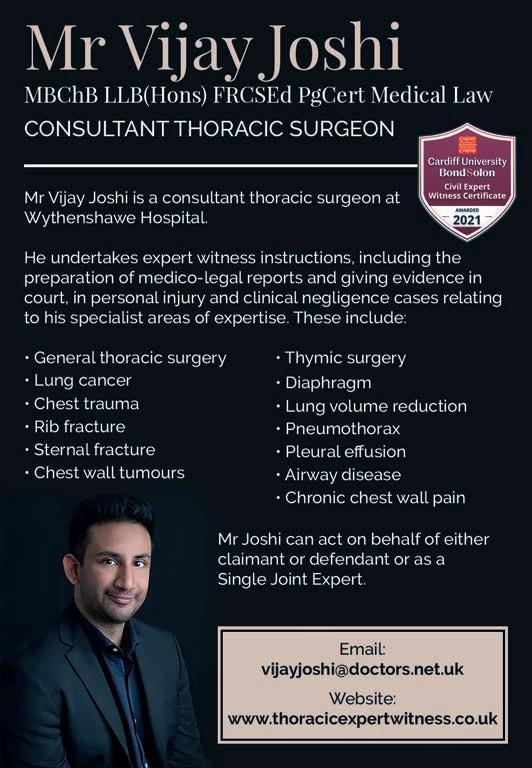


[ ON 7 AUGUST the government published its response to its consultation on the licensing of non-surgical cosmetic procedures in England. The consultation ran from 2 September to 28 October 2023. Following analysis of the responses received, the government has set out its commitment to:
• Introduce legal restrictions which will ensure that cosmetic procedures which are deemed to pose the highest level of risk to the public, such as liquid Brazilian butt lifts, are classed as Care Quality Commission regulated activities
– which can only be performed by specified regulated healthcare professionals
• Develop and implement local authority licensing for lower-risk procedures through powers granted through the Health and Care Act 2022
• Introduce age restrictions for those undergoing non-surgical cosmetic procedures
The purpose of the licensing scheme is to ensure that consumers who choose to undergo a non-surgical cosmetic procedure can be confident that the treatment they receive is safe and of a high standard. Under the proposed scheme, practitioners will need to be licensed to perform specific procedures and the premises from which they operate will also need to be licensed.
The new measures follow a series of incidents where people have had high-risk treatments from operators with little or no medical training, leading to dangerous complications, permanent scarring and even death. These new rules will protect people from unqualified, rogue operators

and reduce the cost to the NHS of fixing botched procedures.
There has also been growing alarm over unqualified individuals performing invasive treatments in unsafe environments –including homes, hotels and pop-up clinics. Many of these procedures are marketed as non-surgical but, in reality, are invasive and carry serious risks.
Minister of State for Health Karin Smyth said: ”The cosmetics industry has been plagued by a Wild West of dodgy practitioners and procedures. There are countless horror stories of cosmetic
cowboys causing serious, catastrophic damage. This government is taking action to protect those seeking treatments, support honest and competent practitioners and root out the cowboys.
“This isn’t about stopping anyone from getting treatments; it’s about preventing rogue operators from exploiting people at the expense of their safety and keeping people safe. We’re giving them peace of mind and reducing the cost to the NHS of fixing botched procedures.”
Priority will be given to introducing regulations to restrict the highest-risk procedures first – such as fillers injected into breasts and genitals. A public consultation will be published early next year. This will seek views on the range of procedures which should be covered in the new restrictions.
While the measures are being developed, the government urges anyone considering a cosmetic procedure to check their provider’s qualifications and insurance, and to avoid treatments that appear suspiciously cheap.
Millie Kendall OBE, chief executive officer at the British Beauty Council, said: “The British Beauty Council has worked tirelessly in pushing for increased regulation of the aesthetics sector since its inception. I therefore fully welcome the government’s announcement that it is pushing forward with legislation.
“Any measures that increase protection for the general public and professionalise the industry will help instil confidence as well as helping to prevent the normalisation of horror stories that have become synonymous with our sector.” q
[ CHILDREN PRESENT UNIQUE CHALLENGES in surgical care. Their anatomy, physiology and healing processes differ significantly from adults, and even minor deviations in treatment can have profound long-term functional and cosmetic consequences. Experts in paediatric plastic surgery bring an indepth understanding of those nuances, including growth patterns, scar formation, tissue regeneration and the psychosocial impact of visible deformities.
That expertise is invaluable when assessing whether care met the standard expected at the time of treatment, particularly in complex cases where delayed or inappropriate interventions are alleged.
Birth defects, such as clefts, craniofacial anomalies or syndromic deformities, often require staged surgical interventions tailored to a child’s growth and development. Litigation may arise when these conditions are mismanaged or when post-operative outcomes are suboptimal, prompting scrutiny over surgical timing, technique
and multidisciplinary co-ordination. Similarly, children who sustain burn injuries or facial trauma frequently require meticulous reconstruction to restore both function and appearance.
Expert assessment in those scenarios examines wound management, grafting or flap selection, timing of reconstructive procedures and the likelihood of future corrective surgeries.
Scar revision and aesthetic reconstruction represent another dimension of paediatric plastic surgery in litigation. Children are particularly susceptible to hypertrophic and keloid scarring, which can impede function or cause significant psychological distress.
Experts provide detailed evaluation of surgical outcomes, including whether scarring was preventable, managed appropriately or addressed with timely intervention. Their insights extend to longterm prognosis, the expected number of procedures, and potential impact on growth and development, helping courts and insurers to understand the full scope of care required. q
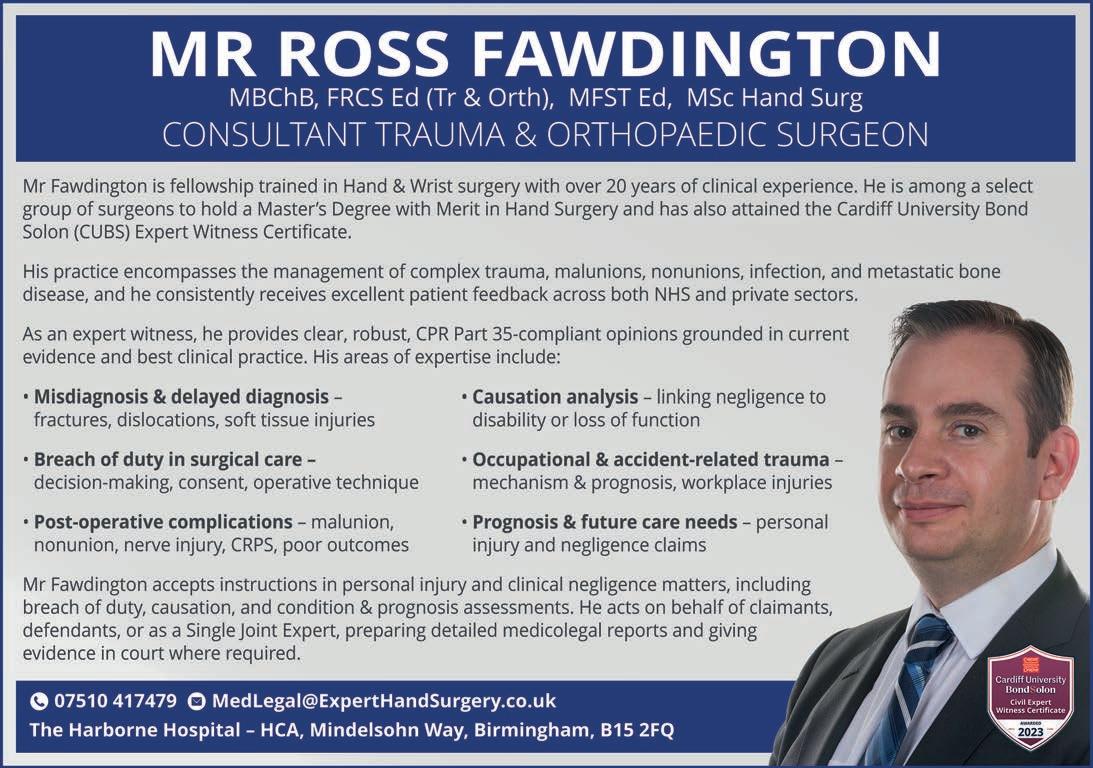
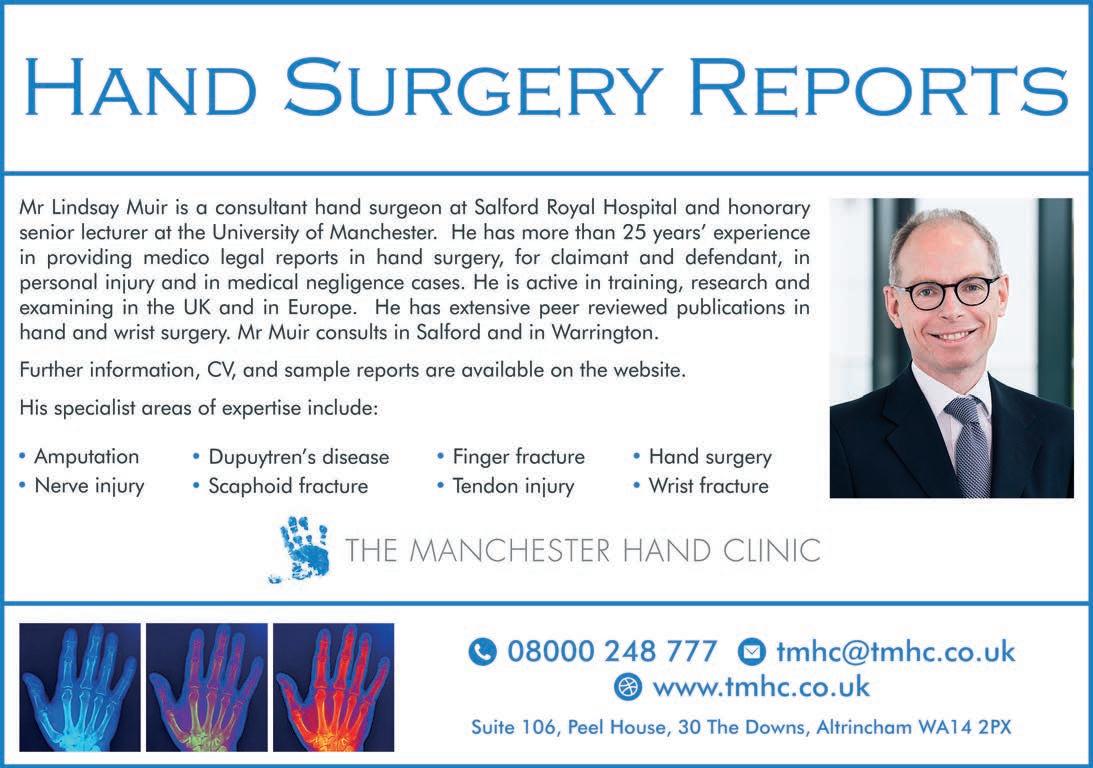
[COMPLEX HAND INJURIES often demand the combined insight of both orthopaedic and plastic surgery expert witnesses, particularly when litigation involves high-value personal injury or clinical negligence claims. The hand’s anatomy – an intricate network of bones, tendons, vessels and nerves – means that trauma rarely affects only one tissue type. For courts seeking clear, impartial evidence on causation, prognosis and long-term function, dual-discipline expertise can be decisive.
A typical case may involve an industrial crush injury, where numerous metacarpal fractures coincide with degloving of the soft tissue. An orthopaedic surgeon provides opinion on fracture management, fixation methods and the likelihood of post-traumatic arthritis or grip weakness. A plastic surgeon, meanwhile, assesses microvascular repair, skin grafting, flap coverage and the risk of scarring or contractures that may impair dexterity. Their combined testimony helps the court evaluate both skeletal stability and soft-tissue viability when determining damages and future care costs.
Road traffic accidents can present similar overlap. A motorcyclist’s high-speed collision may produce open fractures, tendon lacerations and nerve injury. Orthopaedic evidence addresses bony reconstruction and joint salvage, while the plastic surgery expert details microsurgical nerve grafting and aesthetic restoration: factors crucial for claimants whose employment depends on fine motor skills. Joint reporting can clarify the interplay between bone healing and sensory recovery, informing the court about realistic functional outcomes.
Clinical negligence claims also highlight the need for both specialties. Delayed diagnosis of compartment syndrome in the hand, for example, can result in muscle necrosis and skin loss. Orthopaedic expertise evaluates the timing and adequacy of fasciotomies, whereas plastic surgery input addresses subsequent reconstructive options, including free tissue transfer and the likelihood of residual deformity. Together, their opinions help determine whether earlier intervention would have preserved movement or reduced scarring.
In occupational injury claims, repetitive strain injuries to the wrist and hand remain a significant area of dispute. Prolonged keyboard work,
[A NUMBER OF NHS trusts throughout the UK have established dedicated teams of children’s hand surgeons.
In the North West of England, the expert team at Manchester University NHS Foundation Trust see and treat babies and children born with differences in their hands – sometimes referred to as congenital hand anomalies.
Professor Vivien Lees and Mr Robert Winterton hold congenital hand clinics at Wythenshawe Hospital in south Manchester and the surgery is performed either at Wythenshawe Hospital or at Royal Manchester Children’s Hospital in the centre of the city, depending on the age of the child and their other health needs.
They are supported by an expert and nationally-renowned team of hand therapists who, along with the surgeons, provide follow-up, splinting and long-term management for children after reconstructive surgery.
The full list of the hospitals providing children’s hand surgery is available to view on the website of the British Society for Surgery of the Hand at www.bssh.ac.uk q

vibration exposure from power tools and assembly-line tasks can all contribute to chronic pain and functional loss. Expert evaluation is vital in identifying whether symptoms stem from workplace activity, underlying pathology or a combination of factors. Clear, balanced reporting can clarify the extent of work-related contribution and guide settlement negotiations.
Plastic surgeons assess scarring or chronic ulceration following surgical repair, while orthopaedic experts comment on tendon integrity and functional rehabilitation.
For solicitors, instructing both an upper limb orthopaedic surgeon and a consultant plastic surgeon from the outset ensures that no element of the injury is overlooked. Their complementary analyses – the one grounded in musculoskeletal mechanics, the other in microsurgical and aesthetic reconstruction – provide a comprehensive, balanced account of causation, treatment and prognosis. q
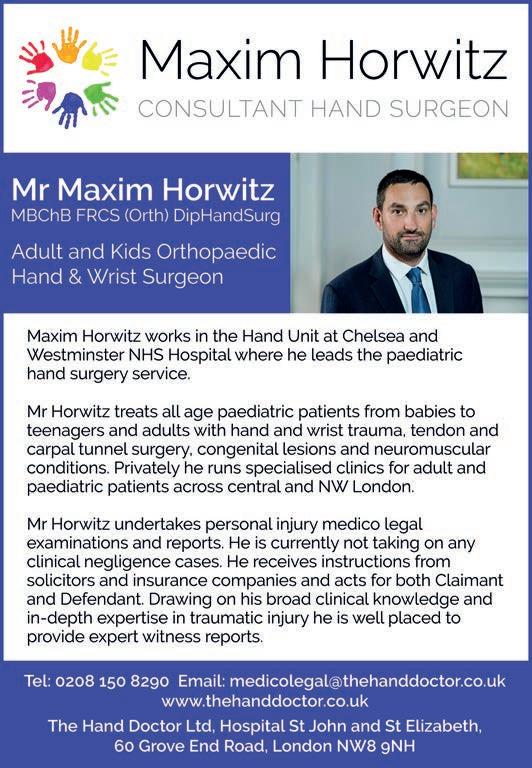
[MEDICAL TATTOOING – also referred to in the UK as paramedical tattooing or micropigmentation – has grown from a niche treatment into a recognised clinical discipline with direct relevance to the courts.
Unlike decorative body art, medical tattooing is undertaken for therapeutic purposes. Practitioners use specialised pigments and techniques to camouflage scars, recreate areolas following breast reconstruction, restore colour to skin affected by burns or vitiligo, or blend surgical scars into the surrounding tissue. The procedures are frequently carried out in hospitals or regulated clinical environments, often as the final stage of a wider course of medical treatment.
Because the results have a functional as well as aesthetic purpose, any adverse outcome can have significant psychological and practical consequences for a patient, which in turn makes the evidential issues in litigation more complex.

Solicitors handling such claims will find that expert evidence is rarely optional. Questions about the appropriate standard of care, the adequacy of pre-procedure counselling and the technical execution of the tattooing process typically fall well outside a court’s ordinary knowledge.
An experienced medical tattooing expert can explain, for example, what level of skill and training is expected of a practitioner, what information should be given to a patient about pigment longevity or colour changes, and how the healing process normally progresses. They can assess whether the choice of pigment, the depth of application or the aftercare advice contributed to a disappointing result, and they can outline realistic options for correction, together with likely costs and timescales.
The choice of expert is critical. A credible witness will usually be a clinician with direct and substantial experience in medical tattooing – perhaps a plastic or reconstructive surgeon, a dermatologist who undertakes micropigmentation or a senior specialist practitioner working within a multidisciplinary NHS or private clinic.
The expert must be able to demonstrate not only technical competence but also familiarity with infection control standards, pigment safety and, where relevant, laser removal techniques. They should also be skilled in translating highly-specialised information into clear, impartial evidence that is accessible to judges and, where necessary, a jury. q

[ACCORDING TO the charity Adult Burn Support UK, medical micropigmentation tattooing can be used in burn scars in the same way as cosmetic skin camouflage to try and reduce the contrast in colour between scars and the surrounding skin.
It can also be used as semi-permanent makeup to define eyelid margins and lips or following breast reconstruction it can be utilised to recreate areolas and colour reconstructed nipples.
“The degree of permanence of the tattoo will vary depending on the depth that the pigment is placed,” the charity says. “In contrast to decorative tattoos, the pigment is often placed more superficially in the skin so that the tattoo is semi-permanent rather than permanent.
“More often than not, you will need to seek this service privately. When choosing to go private, please remember it is your responsibility to check that the product or service meets your requirements.”
Leading practitioner and expert witness Rae Denman explains: “Scarring is a common occurrence after accidents. These can be small, medium or extensive, and on any area of the body or face. Scarring can cause low-level anxiety up to extreme distress for men and women alike whether the scarring can be covered by clothing or not.
“With an independent expert assessing the scars with respect to medical tattooing and skin camouflage it can help clients by giving them choices, information and often a way to reduce the visibility of their scarring. An in-person consultation ensures an accurate and professional opinion on instruction of the claimant, the defendant or joint instruction.” q
[THE GOVERNMENT must heed the alarm bells ahead of winter as emergency departments across England report experiencing substantial pressure over summer. That was the call from the Royal College of Emergency Medicine (RCEM) as the latest performance data, published by NHS England, revealed 122,852 patients faced a wait of 12 hours or more in July. That is the second highest number on record of people who endured that length of wait since records began in 2010 for the month of July. It means one in 12 patients experienced that length of stay to be admitted, transferred or discharged.
The data also showed that there were 1,469,050 attendances to major EDs: the busiest July on record, the busiest month so far this year and the second highest number of attendances on record. Of those patients, 63.1% (926,890) were seen within the target of four hours. In addition, 559,392 people were admitted into hospital: over 22,000 more than the previous month.
Hospital occupancy remains high, with 92,735 beds occupied (92.1%). The level considered to be safe is 85% and more than 8,460 beds would be needed for that level to be achieved.
Dr Adrian Boyle, president of the Royal College of Emergency Medicine, said: “You just have to look at these numbers to see the intense pressure our emergency departments are under despite the warmer weather. It’s deeply concerning. If this is summer, what will winter be like?
“We have thousands of patients enduring extremely long stays, often on a trolley in a corridor, through no fault of their own, because there are no available beds on wards for them to move to. They are being put at risk of serious harm because the system is in crisis.
“Health leaders and policy makers need to turn their attention to the ‘back door’ of hospitals – ensuring patients who are well enough to be discharged can be, with appropriate social care in place. Only then will we see flow through our hospitals, without patients facing lengthy delays.
“Any plans to tackle the winter months ahead must be concerted, robust and meaningful. Because if you fail to prepare, you prepare to fail.”
A similar picture was revealed in Scotland, as the latest ED performance figures for July were released on 2 September by Public Health Scotland. They reveal that slight progress has been made in reducing the longest waits compared to last year – but the picture is still bleak.
The data, for major Scottish emergency departments, showed that in July 2025:
• Around two thirds (67.3%) of patients were seen within four hours – a slight increase of 1.2 percentage points on July 2024, but still far below the safe target of 95%.
• One in 10 (11,928) patients waited an unacceptable eight hours or more: a decrease on the same month last year – but more than ten times more than in July 2019 (1,130).
• Thousands of people (4,686) were forced to wait more than 12 hours.
• There was an average of 1,928 beds each day occupied by people healthy enough to be discharged: an increase of 464 compared to July 2019.

RCEM vice president for Scotland Dr Fiona Hunter said: “There has been no summer respite in our emergency departments this year. What should have been a quieter month was busier for ED staff than winter was a few years ago. All year round, thousands of people are waiting for extremely long periods of time in EDs, which is putting them at risk of further harm. This is unacceptable.
“Not enough emphasis is being put on tackling this by politicians, and we have yet to see a winter plan which will prevent harm coming to patients from long waits in EDs this winter.”
Meanwhile, the Royal College of Emergency Medicine Northern Ireland says the emergency care system in that country is in a ‘critical condition’, following the release of their latest ED performance data. The statistics, released by the Department of Health, cover the period from 1 April to 30 June 2025.
They reveal that almost one in five patients (33,938) waited 12 hours or more to be admitted, transferred or discharged from major Northern Ireland EDs during that period. That’s the worst first quarter performance since records began in 2011.
Shockingly, in June alone 533 patients had to wait more than two days (57 hours) before a ward bed could be found for them.
Dr Michael Perry, vice president of RCEM Northern Ireland, said: “I am not exaggerating when I say this is one of the most worrying sets of data that I have seen. Tens of thousands of people endured a 12-hour wait in just three months, with hundreds ending up waiting more than two whole days in a department which was designed to get people in and out in just four hours.
“Mums, dads, grandparents – many of whom will be vulnerable –left waiting hours, often on trolleys in corridors through no fault of their own. Emergency departments in Northern Ireland are in a critical condition.” q
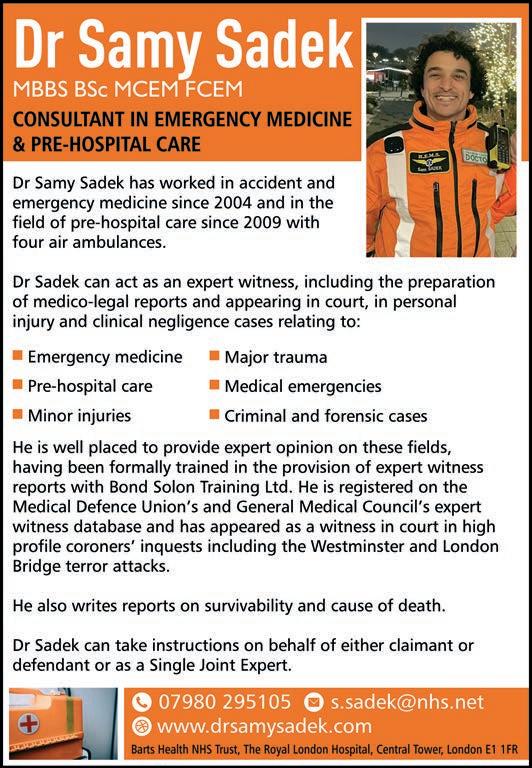

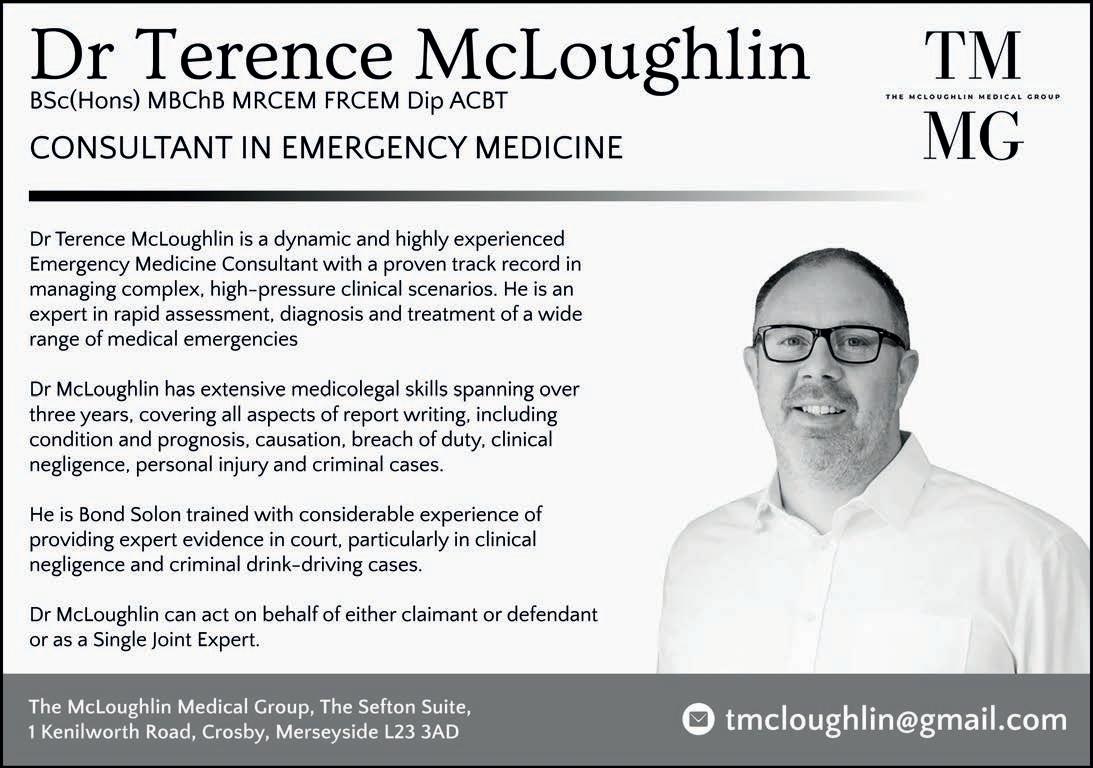
[FOLLOWING lengthy discussions
by the different committees of the Royal College of Emergency Medicine, a position statement regarding treating patients in the back of ambulances has now been agreed.
The statement says: “The relationship between the people who work within emergency departments (EDs) and those who work within the emergency services is strong. RCEM and our members will always seek to work constructively with our colleagues where we face joint challenges, in order to improve patient care. RCEM is aware that ambulances are often held outside EDs with delays experienced by patients who are still in them. These delayed hospital handovers are unacceptable.
“RCEM completely rejects the increasing normalisation of attempts to care for patients in ambulances whilst they are waiting to come into ED. It is clear that trying to deliver emergency medicine to patients in ambulances is neither safe nor effective, and results in a poor patient experience.”
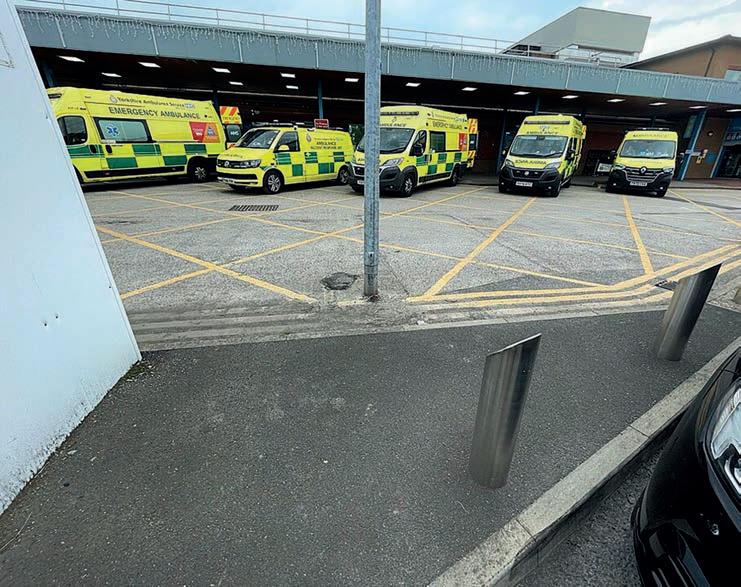
However, the adoption of ‘rapid offload’ policies based on a fixed time limit for delayed hospital handovers should not be unilaterally adopted, the statement says. Instead, it recommends a more balanced approach involving risk sharing across the system.
“Rapid offload policies may increase the risk to patients by adding to overcrowding in departments which will already be full. It should not be necessary to view such policies as a tool to focus attention on exit block. If such policies are under consideration they should be agreed with emergency department teams and never imposed upon them.
“Emergency physicians, nursing staff and other hospital-based healthcare professionals are not specifically trained to work in ambulances outside their departments. They should not be expected to do so.”
There is a recognition that in reality such practices do exist.
“RCEM is, however, aware that some emergency medicine services undertake clinical assessment of patients in ambulances, or are considering doing so. It is not possible to be prescriptive on this topic since our members are being placed in an unacceptable position. The decision about whether or not to undertake assessment and treatment of patients waiting in the back of ambulances lies with individual departments, based on local circumstances.”
RCEM guidance is available in those circumstances, as part of its Guidelines for the Provision of Emergency Medicine Services (GPEMS)
“The phenomenon of ambulances being unable to offload patients at emergency departments is an appalling indictment of the state of the health services in the UK. The reason patients are having to be held in the back of ambulances outside EDs is that EDs are crowded as a consequence of ‘exit block’. It is not within the gift of EDs to enact the system-wide solutions required to address the issues of ‘exit block’.
“EDs should not be blamed, or have unreasonable expectations placed upon them, as a result of health policy failure. Responsibility for this situation lies with governments across the four nations of the UK, and with local system leaders.” q

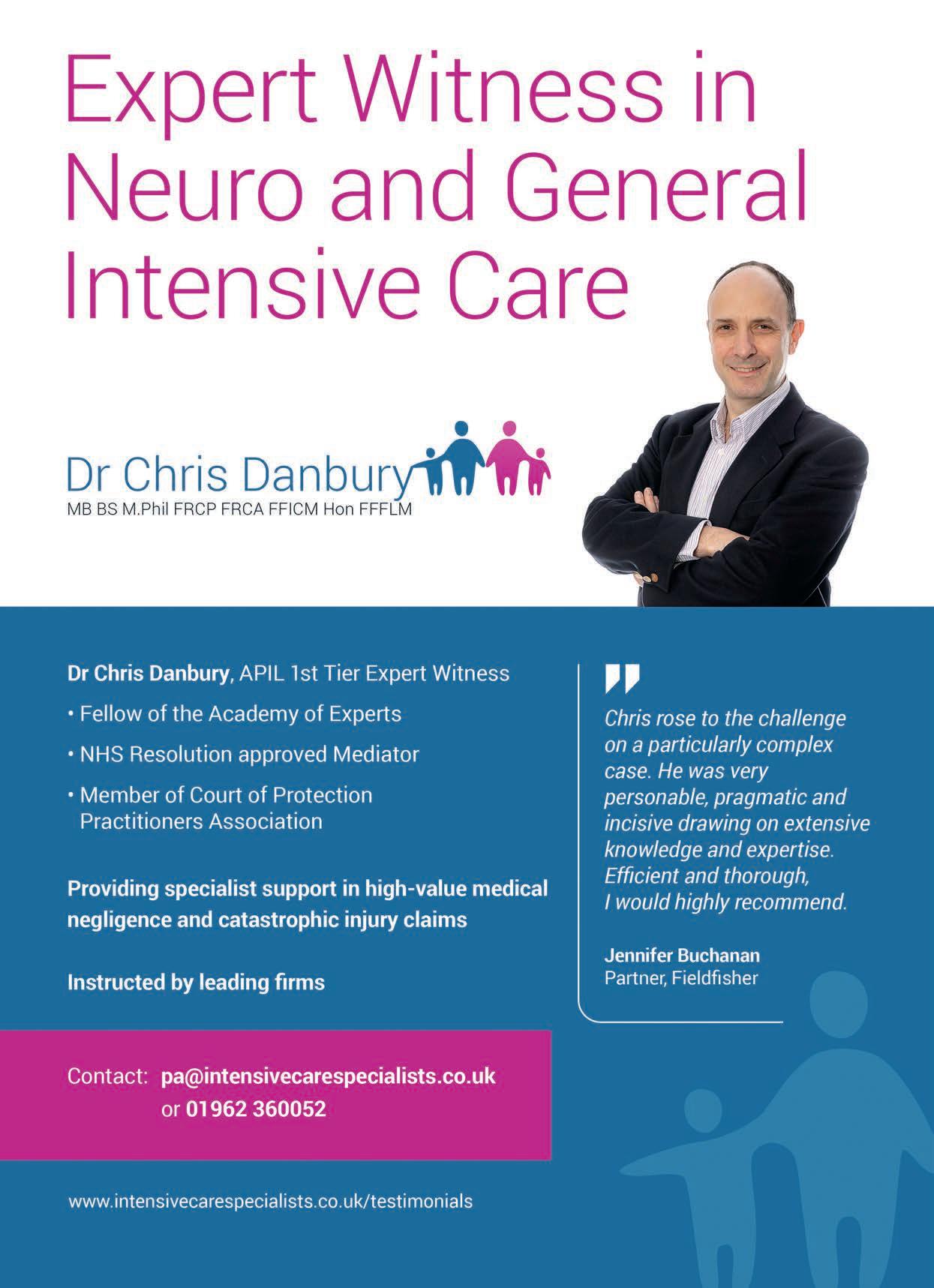
[
DESPITE NUMEROUS awareness campaigns in recent years, and the existence of well-established national guidance, sepsis remains a leading cause of preventable harm within the NHS. Unsurprisingly, it is also an area of growing focus in medico-legal claims, where the consequences of delayed recognition or treatment can be life-changing.
For litigation solicitors, cases involving sepsis present unique challenges. The progression of the condition means that every hour counts, and expert opinion is often needed to establish whether clinicians acted with sufficient urgency, whether deterioration was properly recognised and whether treatment was delivered in line with accepted standards such as the ‘Sepsis Six’ bundle or NICE guidelines.
An expert witness in sepsis is frequently

instructed to analyse whether early warning signs were identified and acted upon appropriately, and whether delays in antibiotics or fluid resuscitation altered the patient’s prognosis. That requires a detailed review of medical records, observation charts, triage notes and escalation protocols. An experienced expert is able to piece together
the timeline of events, highlighting crucial points at which intervention might reasonably have been expected.
Causation remains a central and often contentious element in sepsis claims. It is rarely sufficient to demonstrate that care was substandard without also proving that the outcome would have been materially different had appropriate treatment been provided earlier. Here, the expertise of a sepsis specialist becomes indispensable.
They are able to advise on survivability, the likely impact of earlier intervention and the extent to which complications such as septic shock, organ failure or long-term disability could have been prevented. That objective analysis allows solicitors to focus their arguments not only on liability but also on the quantifiable consequences of negligence. q
[ ON 2 SEPTEMBER, 70 parliamentarians attended an event in Parliament ahead of World Sepsis Day on 13 September and pledged their support for improving sepsis awareness. It was hosted by the All-Party Parliamentary Group (APPG) on Sepsis and The UK Sepsis Trust (UKST).
In the UK, five people lose their lives to sepsis every hour. It is a life-threatening c ondition which arises when the body’s response to infection harms its own tissues and organs. It affects 245,000 people in the UK annually, claiming 48,000 lives. Sepsis can lead to shock, multiple organ failure and death if not recognised early and treated promptly.
Those attending the APPG drop-in session included ‘Bionic Peer’ Lord Mackinlay, who is a quadruple amputee following his own battle with sepsis in 2023, and UKST ambassador Harry Redknapp, who led UKST’s Sepsis Awareness Month campaign, It’s Game On for Sepsis Awareness.
Harry Redknapp explained: “In 2018 my wife Sandra developed sepsis from a kidney infection. It was a terrifying experience – but we were lucky. She survived. 48,000 families across the UK aren’t as fortunate. That’s why I’ve teamed up with The UK Sepsis Trust to get life-saving information in front of as many people as possible.”
Sepsis arises in people of any age, whether or not they’ve got underlying illness, and although it always starts with an infection – such as pneumonia, chest infections or UTIs – it’s unknown why some people develop sepsis when others do not. As a result, sepsis presents very differently in each patient and can be challenging to identify. Early diagnosis and swift action are essential to improving outcomes for people with sepsis.
UKST has also created an educational game – Sepsis Savvy Shootout – which helps users to quickly learn key facts about sepsis. Those who play can be entered into a prize draw to win a meet and greet with Harry Redknapp.
Founder and chief medical officer of The UK Sepsis Trust, Dr Ron Daniels BEM, said: “Sepsis is an indiscriminate killer that affects 245,000 people in the UK every year. With at least 48,000 people losing their lives annually to sepsis-related illnesses – more than breast, bowel and prostate cancer combined – the need for action is clear.
“We’re so grateful to every MP who has pledged to support
our campaign and our work, this September and beyond. Their commitment is crucial in the fight against sepsis, and will help us to raise lifesaving awareness in communities across the UK.” q
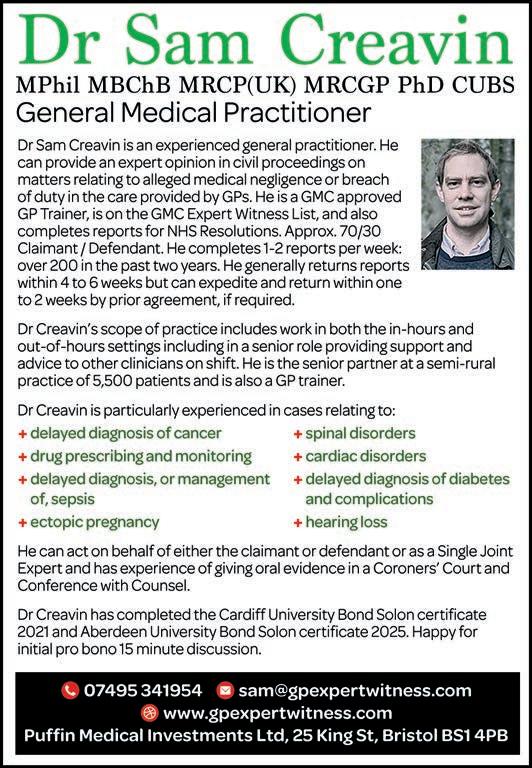
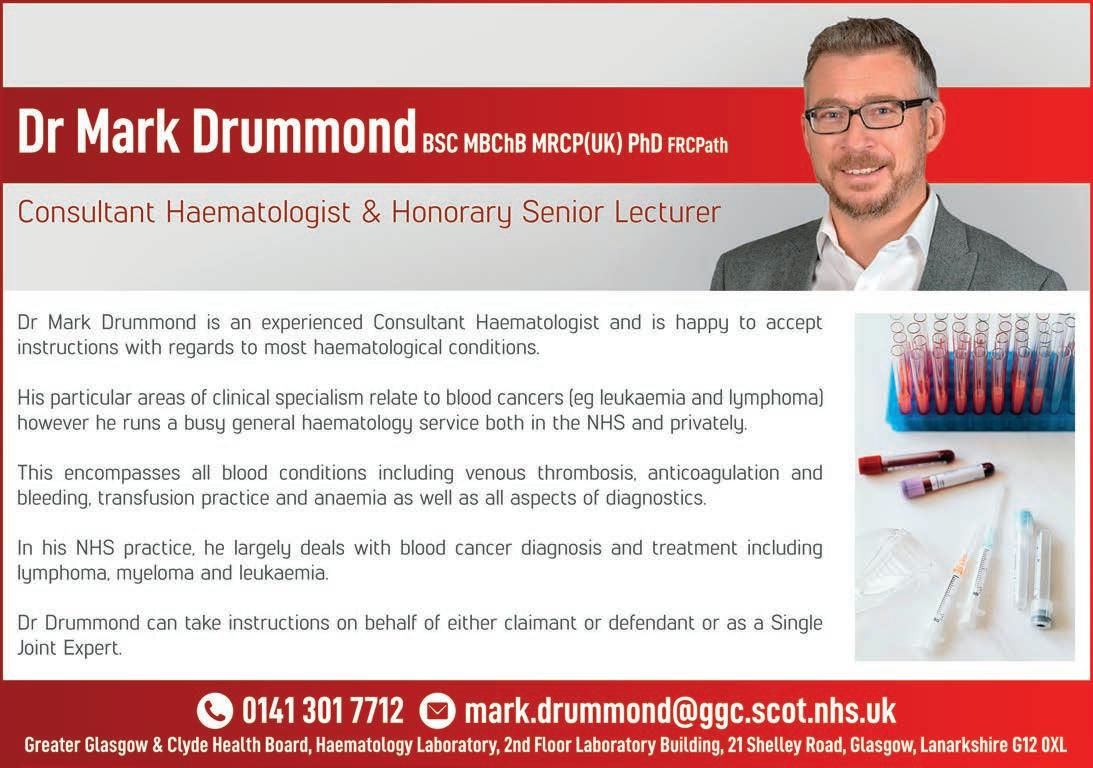
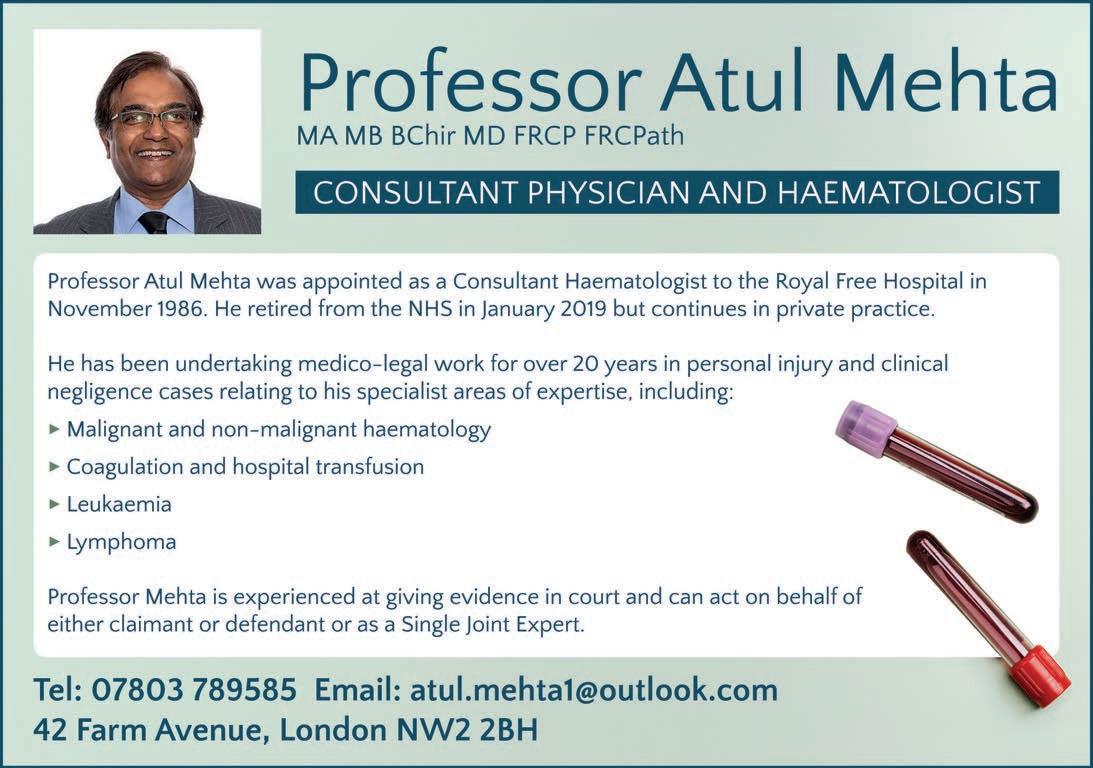
[ON 9 JULY the Infected Blood Inquiry published an Additional Report on Compensation with recommendations for the government on the Infected Blood Compensation Scheme. The report explores how the scheme was designed, the structure of compensation awards and the approach to the scheme’s delivery.
In the additional report Sir Brian Langstaff wrote: “In autumn 2024, the Inquiry began to receive increasingly concerned communications from individuals, organisations and legal representatives regarding the compensation scheme – how it had been designed without the participation of people infected and affected, the way in which the scheme was structured and being operated and the length of time it was taking for the Infected Blood Compensation Authority to make compensation payments.”

week. Lives have been shattered, and justice denied for decades. No amount of financial compensation can make up for this unprecedented suffering; however, the Government hopes the Infected Blood Compensation Scheme (‘the Scheme’) will bring redress to people who have been impacted by this harrowing scandal.
“The Government has considered the Inquiry’s report and has listened carefully to the evidence that the infected blood community has given to the Inquiry. As a result of this the Minister for the Cabinet Office set out to Parliament on 21 July 2025 the changes that will be made to the scheme.
In his accompanying letter to the Cabinet Office Minister, Sir Brian wrote: “The recommendations in the Additional Report seek to correct obvious injustices and further speed up compensation, in addition to the actions you have taken. You explained when you gave evidence that your test for decisions about the compensation scheme is that any decision should not cause even greater delay for justice. I am confident that these recommendations should not cause such delay.
“The underlying themes which run through this Additional Report are the need for transparency, involvement, listening rather than simply hearing, and recognising and remedying injustice. You have been clear about the need for a changed culture in the public sector. Truly involving people infected and affected in how the state recognises their losses would start to turn the page on the past.”
In its response, published on 30 July, the government said: “The Infected Blood Scandal is an injustice that has spanned across decades on an unprecedented scale: thousands have died, and continue sadly to die every
[THE DRUG CYCLOPHOSPHAMIDE could revolutionise blood stem cell transplants, allowing transplants from ‘mismatched’ donors, according to a new study. Haematologists involved in the research have said it suggests most patients should be able to find a bone marrow donor.
A multi-centre study in the USA, conducted by the Center for International Blood and Marrow Transplant Research, followed 145 patients who received the immune suppressant cyclophosphamide to enable them to have peripheral blood stem cells from mismatched unrelated donors.
Reporting in the Journal of Clinical Oncology, the researchers say that 80% were alive after a year. A tenth of the patients developed moderate or severe graft-versus-host disease – a proportion the researchers claim is similar to patients who receive fully matched donations. The majority of patients in the study had been diagnosed with acute myeloid leukaemia.
The researchers say the use of cyclophosphamide could be a ‘significant advance’, and call for further work to improve the safety and effectiveness of mismatched blood stem cell transplants.
One of the researchers, Dr Karen Ballen of University of Virginia (UVA) Health, said: “This study is important because all patients, regardless of background, now have a stem cell or bone marrow transplant donor, a significant advance for our field, our patients and our community.
“At UVA Health, in the past year, all eligible patients for stem cell transplant were able to find a suitably matched donor.” q
“The report provided recommendations across nine key areas making 26 individual recommendations in total: 15 of these recommendations focus on the design of the scheme. The Government is immediately accepting seven of these recommendations. The Government’s priority is making these changes as quickly as possible to ensure people can receive the full amount of compensation they are entitled to. In some cases further legislation will need to be implemented to make these changes. The Government aims to have this legislation in force by the end of 2025.
“The other recommendations, as have been suggested by the Inquiry, will be subject to consultation, after which the Government will confirm its final response, taking into account the community’s views. Building on the engagement that was undertaken by Sir Robert Francis last year and the changes that have already been made, the Government understands that more must be done to ensure the community is engaged on future changes to the scheme. Further legislation will then be required to implement the outcome of the consultation.” q


[THE 14 HOSPITAL TRUSTS to be looked at as part of a rapid, independent, national investigation into maternity and neonatal services were named on 15 September 2025 by the Department of Health and Social Care (DHSC).
Baroness Valerie Amos’s investigation will put families at the heart of the work, the DHSC said, and affected families were asked to provide input to the draft terms of reference of the investigation. The terms of reference have been developed to focus on understanding the experiences of affected women and families, identifying lessons learned and driving the improvements needed to ensure high-quality and safe maternity and neonatal care across England.

The investigation was announced in June by Health and Social Care Secretary Wes Streeting after the government ‘inherited’ systemic problems in maternity and neonatal care dating back over 15 years. It comes alongside a package of immediate actions to improve care, including greater intervention by the Secretary of State and NHS chief executive to hold failing trusts to account: a key step in delivering the government’s mission to build an NHS fit for the future through the Plan for Change.
Secretary of State Wes Streeting said: “Bereaved families have shown extraordinary courage in coming forward to help inform this rapid national investigation alongside Baroness Amos. What they have experienced is devastating, and their strength will help protect other families from enduring what they have been through.
“I know that NHS maternity and neonatal workers want the best for these mothers and babies, and that the vast majority of births are safe and without incident, but I cannot turn a blind eye to failures in the system. Every single preventable tragedy is one too many. Harmed and bereaved families will be right at the heart of this investigation to ensure no one has to suffer like this again.”
The investigation will urgently look at a range of services across the entire maternity system, following independent reviews across numerous trusts that have revealed a pattern of similar failings: women’s voices ignored, safety concerns overlooked and poor leadership creating toxic cultures.
The Health and Social Care Secretary and Baroness Amos have agreed the terms of reference of the independent investigation, which will include understanding the lived experiences of families, reviewing the quality and safety of services, identifying the drivers and impact of inequalities, and identifying barriers to making improvements.
Following its conclusion, she will deliver one clear set of national recommendations to achieve consistently high-quality, safe maternity and neonatal care, with interim recommendations delivered this December.
Baroness Amos commented: “It is vital that the voices of mothers and families are at the heart of this investigation from the very beginning. Their experiences – including those of fathers and non-birthing partners – will

guide our work and shape the national recommendations we will publish. We will pay particular attention to the inequalities faced by Black and Asian women and by families from marginalised groups, whose voices have too often been overlooked.
“Our aims are to ensure the lived experiences of affected families are fully heard, to conduct and publish 14 local investigations of maternity and neonatal services, and to develop recommendations informed by these that will drive improvements across maternity and neonatal services nationwide.”
The 14 trusts announced have been chosen for investigation based on a range of factors. They include data and metrics such as the Care Quality Commission maternity patient survey and MBRRACE-UK perinatal mortality rates, as well as criteria to determine a diverse mix of trusts.
Three of the trusts chosen – Shrewsbury and Telford, East Kent Hospitals and University Hospitals of Morecambe Bay – have been the subject of previous investigations and learnings from those will be incorporated in the new investigation.
Kate Brintworth, Chief Midwifery Officer for England, said: “This independent investigation is a crucial step in driving meaningful change in maternity and neonatal care, and the diverse range of trusts selected –including where previous investigations have taken place to incorporate learnings – will provide valuable insight to help teams across the country improve care for women, babies and families.”
The investigation will run alongside a National Maternity and Neonatal Taskforce – set up and chaired by the Health and Social Care Secretary and made up of a panel of esteemed experts and families – to keep up momentum and deliver change. q
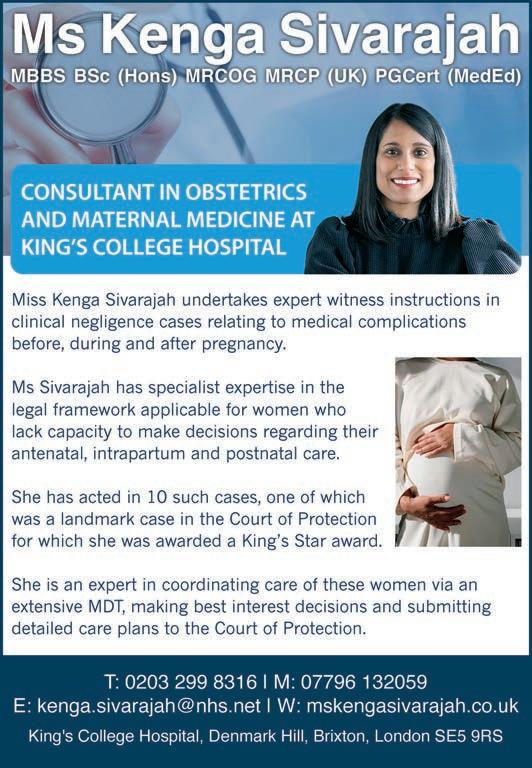
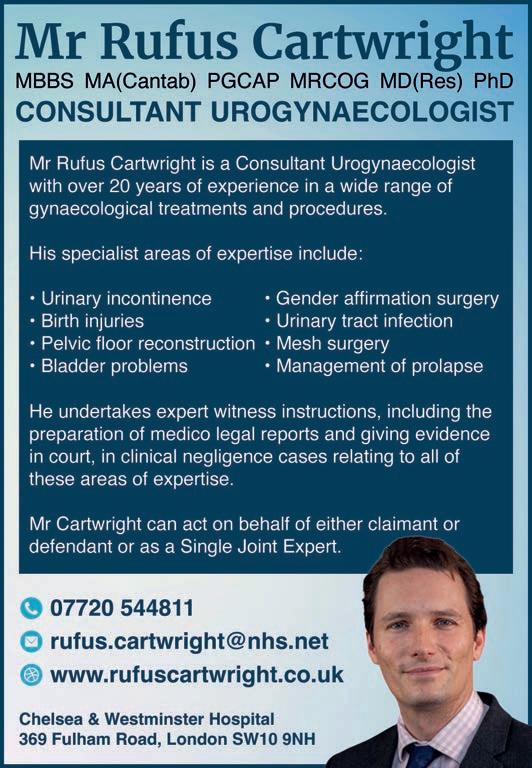
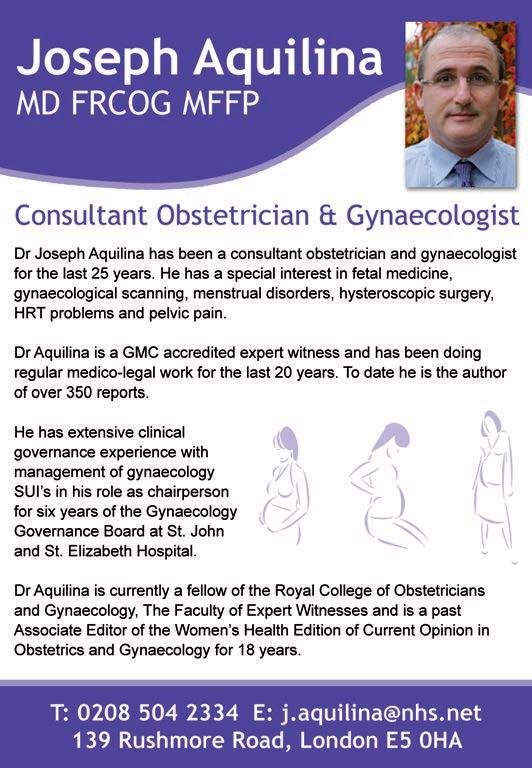
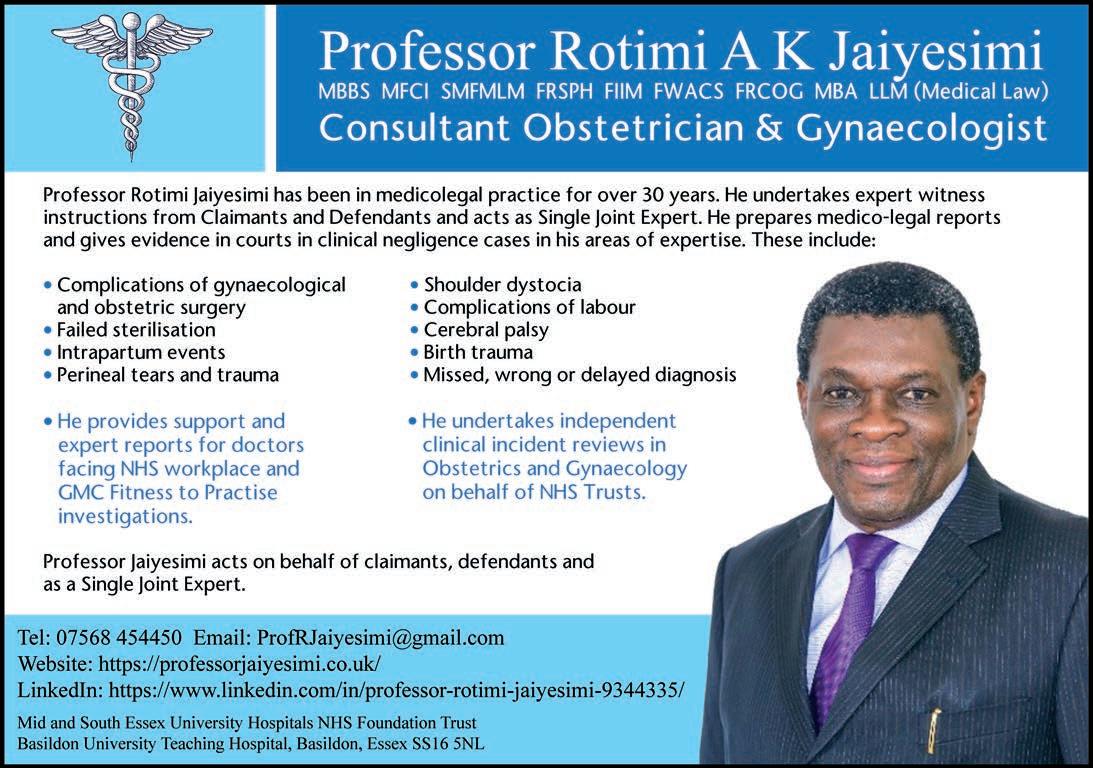
[MUCH OF THE RECENT DEBATE around failures in maternity care has focused on the tragedies post-natal. Failures in antenatal care and fetal medicine can also lead to negligence claims. Specialists at GadsbyWicks have compiled a guide for women who feel they may not be receiving the appropriate level of antenatal care.
“Whether becoming a mother for the first, second or fifth time,” the guide says, “during pregnancy a great deal of trust is placed in obstetricians, midwives and other healthcare professionals to support the health of mother and baby.
“While this care is generally of a good standard and leads to a smooth, straightforward pregnancy, sometimes it falls below expected standards. This is a very critical time, and any mistake or oversight by a healthcare professional can have serious consequences for the birth itself and the wellbeing of both mother and baby.”
Throughout pregnancy, the guide says, a woman will be offered a number of appointments with a midwife or obstetrician, where they will:
• Check the health of both mother and baby
• Offer advice on diet, exercise and more for a healthy pregnancy
• Discuss care options during pregnancy, labour and birth
• Answer any questions or concerns
“In the UK, if it is the mother’s first pregnancy, they will usually be offered up to 10 antenatal care appointments. For later pregnancies this will drop to approximately seven, unless the mother has a health condition or a previous pregnancy that supports the need for additional appointments.”
Across these appointments, the midwife or obstetrician will perform several tests to assess the health of both mother and baby, including:
• At least two ultrasound scans at 10-14 weeks and 18-21 weeks
• Screening tests for a range of infections, inherited conditions or
• conditions such as Down’s syndrome
• Weight and height checks
• Checking the baby’s pulse
• Blood tests and blood pressure tests
• Urine tests
• Blood group and rhesus status
• Iron deficiency checks
• Gestational diabetes checks
“A failure to perform these checks or identify any problems that the results indicate could form the basis for a birth injury claim if this directly causes harm to either the mother or baby.”
Some of the more common mistakes that can be interpreted as negligence are:
• Incorrect reading of CTG results, or tracking the mother’s pulse
• rather than the baby’s heart rate
• Overlooking any signs or symptoms of infection in the mother, or
• failing to treat that appropriately
• Overlooking any noticeable changes in the baby’s growth rate
• Incorrect management of medication
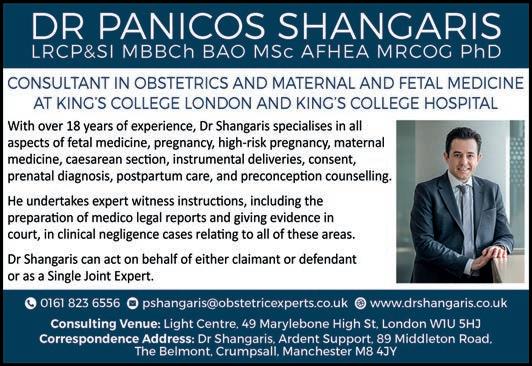
• Overlooking signs of preeclampsia or failing to address it with
• medication or induced delivery
• Underplaying any bleeding or pain suffered by the mother during
• pregnancy – that could be a sign of placental abruption, which can
• deprive the baby of oxygen and nutrients
• Lack of screening the baby for abnormalities, or failure to provide
• parents with options based on the results of these screenings. q
[THE ROYAL COLLEGE OF MIDWIVES (RCM) CYMRU has welcomed the Welsh Government’s announcement of a new Maternity and Neonatal Oversight Panel, which will undertake a current state ‘rapid independent assessment’ of maternity services in Wales.
However, the RCM has cautioned that this assessment must strengthen and support the improvement work that is already underway, not derail it. Following the Welsh Government’s publication of the New Standards for Maternity Care earlier this year the RCM says services and staff are already working hard to implement improvements.
Equally, the RCM has called for the lived experiences and voices of women and families who have suffered unbearable loss and to those who have received care that has fallen short of the high standard of quality maternity care to be central to this rapid assessment.
Commenting, RCM Cymru director Julie Richards said: “We welcome the Welsh Government’s ambitions to improve the safety and delivery of maternity care for all women in Wales. This is something the RCM is absolutely committed to, and we are also pleased to have been able to contribute to both the maternity standards and the perinatal framework earlier this year and now to be named as a key stakeholder in this new independent assessment of services.
“Like so many staff working in maternity services and the women and families that use those services, we want to see swift improvements, which make for real lasting change. So, we are pleased that the Welsh Government has set a target for concluding this work by the end of the year, and reporting in January.”
The college has previously warned that the success of both the standards and perinatal framework are dependent on investment in maternity staff. It has been calling for a workforce plan to support the successful implementation of these plans and today has restated those calls. q

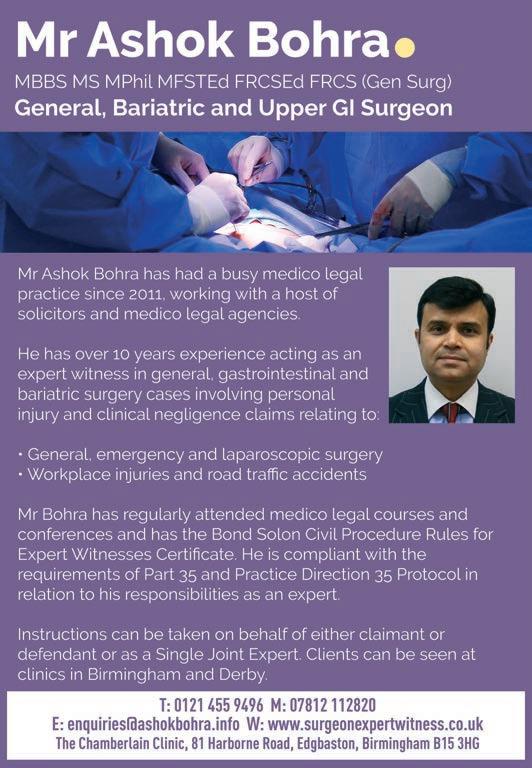
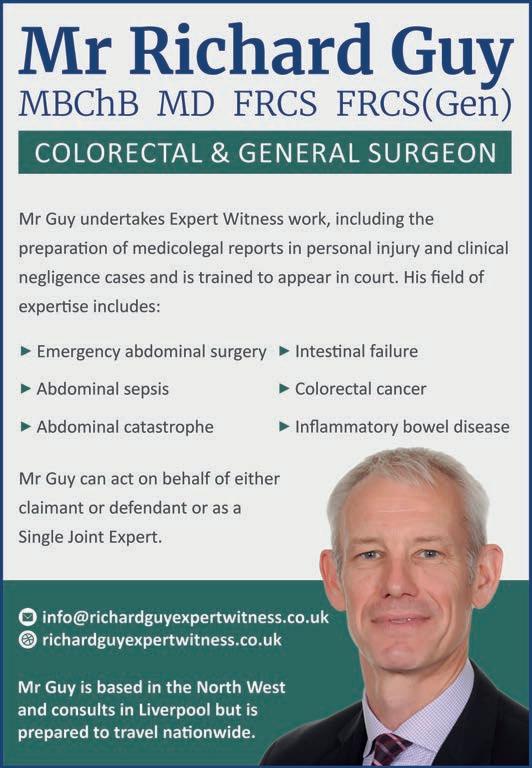
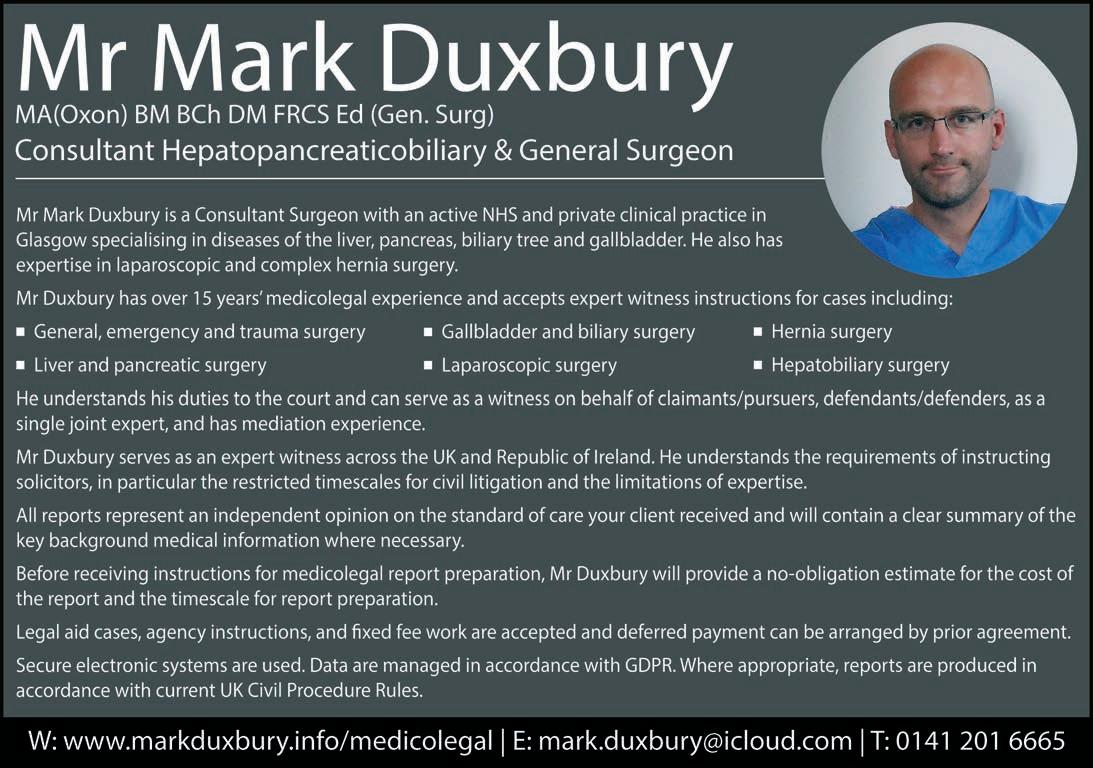
By Rakesh Bhardwaj MBChB MD FRCS FRCS (Ed) FRCS (Gen Surg) LLM consultant colorectal surgeon
[ MANY CLAIMS FOR BREACH OF DUTY in diagnosis and treatment of colorectal cancer are brought because of perceived delays in care. A patient may have been referred to see a specialist only to discover that upon diagnosis the disease is significantly advanced.
They are often frustrated because they feel that they should have been referred earlier, or if the correct investigations had been performed earlier treatment options would have been greater. Difficulties arise for the expert witness when they try to distil from any assessment – be it an interview or just a review of the records –salient facts that can be significant.
There are some concepts in the medical literature with respect to cancer care that may not be familiar. ‘Disease free survival’ refers to the period, often listed as five or 10 years, of the survival of the patient who has not succumbed to the effect of cancer. ‘Recurrence‘ is the term used when a cancer returns at the original site of disease after successful local treatment. ‘Progression’ refers to further disease developing, and conversely ‘regression’ refers to the reduction of the burden of disease. ‘Metastatic disease’ refers to when the cancer has spread beyond the original site of disease. With respect to colorectal cancer the organs commonly involved are the lungs and the liver.
The ‘UICC stages’ refer to the TNM staging, where T describes the size of the tumour and any spread, N describes spread of cancer to nearby lymph nodes and M describes metastasis. We often describe colorectal cancer from stages 1-4: 1 being the earliest stage and 4 demonstrating metastatic disease.
What are the questions commonly asked of experts and what precisely would an expert look for in the records or the medical literature?
If the patient presented earlier would the stage, and thus outcome, have been different?
We know that as time progresses the stage of the colorectal cancer will advance. Some experts suggest that it takes one year for a patient to progress each stage. That concept fails to address tumour growth rates adequately. As colorectal tumours grow the growth through the stages accelerates. Survival data indicates that if the tumour is caught at an earlier stage the outcome is better.
If the patient has metastatic disease at presentation, would the risk of metastatic disease have been less had the disease been diagnosed earlier?
Analysis of spread for colorectal cancer would suggest that, while stages 1 and 2 have low rates of metastatic spread, that number increases significantly in stages 3 and 4. That allows the expert to suggest that, if the tumour were caught at an earlier stage, the burden of metastatic disease would be less. Such information, coupled with data on stage migration, would help the expert determine what would have been the likely yield of disease if the patient had presented earlier. If the stage at presentation had been earlier, would treatment options have been different?
That is particularly important in rectal cancer treatment, where options for neoadjuvant treatment will change according to stage. For colonic cancer we know that, even for stage 3 disease, as long as the disease appears resectable, surgery is the primary optimal
choice. In cases where the disease is not initially resectable, a trial of chemotherapy may render oncological clearance possible.
For earlier stage rectal cancers surgery as a primary option is appropriate. If surgical margins are threatened and a tumour needs to be down-staged, radiotherapy with or without chemotherapy may need to be employed. Advances in chemoradiotherapy have permitted a rectum-preserving option – with close surveillance – in a significant number of patients with rectal cancer.
In the presence of metastatic disease, would options for treatment be different?
The presence of metastatic disease in the liver and lungs is of great concern. However, advances in chemotherapy, with options for monoclonal antibody therapy and aggressive surgical techniques, have widened the strategies for treatment. Therapies such a microwave ablation have permitted more minimally-invasive treatment options for liver disease.
It is of paramount importance that the surgical expert is abreast of newer oncological concepts and newer surgical approaches in cancer treatment. The landscape in colorectal cancer treatment is changing rapidly. q
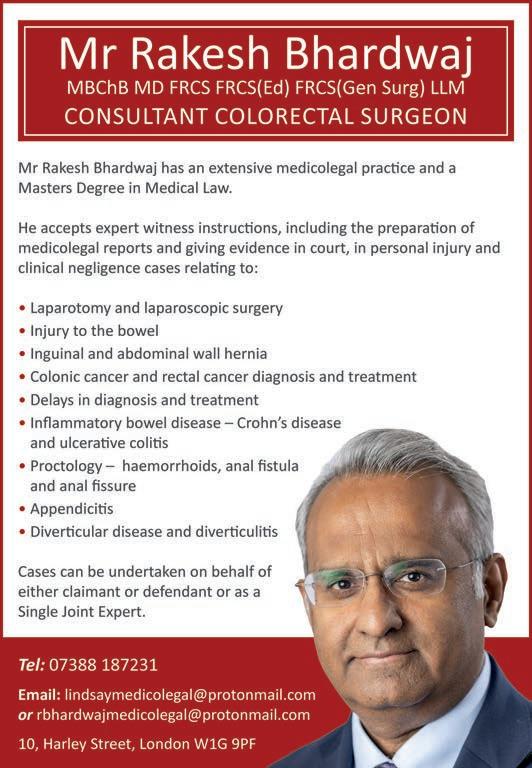
By Philip Coleridge Smith DM MA BCh FRCS, Consultant Vascular Surgeon, Medical Director of the British Vein Institute and Emeritus Reader in Surgery at UCL Medical School
[ LEG SWELLING is a common symptom in patients and arises from a number of conditions. Claimants may suffer swelling following injuries to the lower limb, and the question often arises as to the causal relationship to the injuries sustained and the prognosis.
In clinical negligence litigation deep vein thrombosis may occur when preventative measures are omitted following hospital treatment. That can leave claimants with longterm swelling of the leg.
Establishing a causal relationship between potentially negligent care and permanent swelling of a limb depends on establishing the precise cause of the swelling and establishing the mechanism which has led to the limb swelling.
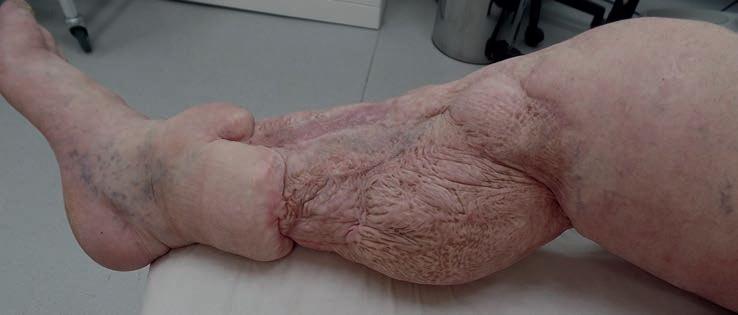
the foot. With worsening of lymphoedema the swelling involves the ankle and calf. In severe cases, the whole limb may be affected.
Blood comprises about 85% water and that may leak from the capillaries, leading to swelling of the leg. That is a common accompaniment to many inflammatory conditions such as injury or infection, as well as following surgery. General measures such as elevation of the leg or the use of compression stockings will help to reduce swelling.
The main tissues of the leg which may swell are the subcutaneous fat and the muscles of the leg. A number of conditions may give rise to increase in size of those tissues by a number of different mechanisms.
In this condition the main veins of the leg become blocked with blood clot. That may occur following lower limb injuries, especial where operative treatment is required. Trauma and orthopaedic surgeons are well aware of those risks and prescribe preventive treatment with anticoagulant drugs for the post-operative period. Where the patient has limited mobility after their injury, the risk of venous thrombosis persists.
Deep vein thrombosis may develop despite appropriate preventative measures being taken. The blocked veins lead to increased loss of water from the blood and worsening swelling. That may be attributed to the aftermath of a leg fracture, but it is important to identify and treat a deep vein thrombosis when it occurs.
A higher dose of anticoagulant drug is used to treat deep vein thrombosis. That will usually facilitate gradual restoration of blood flow in the affected veins. A delay of diagnosis of the deep vein thrombosis of more than a week or two is likely to lead to a less satisfactory outcome. Restoration of blood flow in the affected veins is prejudiced and the occurrence of chronic pain and swelling in the leg may develop. That is known as ‘post-thrombotic syndrome’.
Prevention of deep vein thrombosis, as well as prompt and appropriate treatment when it arises, are crucial to a good recovery following lower limb trauma.
The lymphatic vessels are an extensive set of vessels that drain extracellular fluid – fluid outside blood vessels which bathes the cells of the body – from the limbs. These are small and fragile vessels which are easily damaged. The superficial lymphatic vessels lie near the great saphenous vein which runs the length of the leg up the inside. Where lymphatic vessels are damaged the syndrome which results is ‘lymphoedema’. In that condition fluid accumulates within the subcutaneous tissues of the leg leading to swelling of the limb. The worst affected region is the foot, where swelling begins and is most prominent on the top (dorsum) of
The most common cause of iatrogenic lymphoedema these days is cancer treatment involving removal of sections of the lymphatic system and radiotherapy to those regions. Treatment of breast cancer may lead to lymphoedema in the arm. Treatment of pelvic cancers such as those arising from the ovary or uterus may lead to lymphoedema in the lower limb.
I have advised in cases where traditional varicose veins surgery has led to lymphoedema due to excessive dissection of the lymphatic system, usually in the groin. These days almost all patients are managed with ‘minimally invasive’ varicose vein treatment which is very unlikely to lead to lymphoedema. In my view the use of varicose veins ‘stripping’ operations is now unnecessary and could be regarded as substandard care, especially if it results in the development of lymphoedema in the lower limb.
Litigation in cases of lymphoedema usually arises from trauma to the limb. I have advised in cases where regions of tissue loss in the lower limb included the main lymphatic system, leading to lymphoedema of the limb below the level of injury. It has proved technically difficult to repair the main lymphatic vessels by surgical methods. Patients with post-traumatic lymphoedema are usually obliged to undergo compression treatments with bandages and stockings on a lifelong basis. Swelling of the limb can never be permanently resolved.
This condition arises from increased loss of water from the capillaries into the tissues in the lower limb. Swelling of the ankles, and to a lesser extent of the feet, occurs as a result. It appears to run in families and usually becomes gradually worse from middle-age onwards. Affected people find that the legs swell during hot weather and when sitting still for extended periods, such as on an aeroplane flight.
The mechanism appears to be one of ‘leaky capillaries’ which allow more water to enter the tissues than normal. In hot weather, blood flow to the skin increases and that leads to increased loss of water. The lymphatic system appears to function normally, but its limited capacity is overwhelmed by the additional fluid which then remains in the ankle and foot region, causing swelling.
Where an injury occurs to the lower limbs, the inflammatory process surrounding the injury increases the fluid loss in patients with phlebolymphoedema, leading to more substantial swelling than would occur in someone without the condition. A suspicion of occurrence of deep vein thrombosis may arise in such cases and that requires investigation.
The management of limb swelling in phlebolymphoedema is similar to that in lymphoedema. Leg elevation and compression stockings or bandaging are helpful. In patients who have suffered injury to the leg,
once healing has been achieved the swelling should return to the same state as previously. Sometimes the swelling appears to be worse than previously and the suspicion of the presence of lymphoedema occurs.
The function of the lymphatic system can be checked by using lymphoscintigraphy, an investigation which provides images of the function of the lymphatic system. In lymphoedema delayed flow through the lymphatic system is observed, whereas in phlebolymphoedema flow is often accelerated since increased amounts of fluid are cleared via the lymphatics.
Phlebolymphoedema is not an acquired condition, so claimants cannot usually show that this condition is attributable to their injury.
Lipoedema is a congenital condition which involves swelling of the lower limbs due to preferential deposition of subcutaneous fat. As a result of the condition the legs become large, but there is no substantial accumulation of fluid. Ultrasound imaging shows that the subcutaneous layer is thicker than would be expected, but contains no excess of fluid – in contrast to other causes of leg swelling.
Another factor distinguishing this condition from lymphoedema and phlebolymphoedema is that the feet and ankles are not affected and have normal, minimal amounts of subcutaneous fat. The increased fat deposition extends to the calf and thigh and may also include the hips.
Patients with the condition tend to accumulate fat preferentially in the lower limbs when they put on weight. That has led to some claimants asserting that leg swelling was due to injuries sustained in road traffic incidents. In those cases it is likely that the lipoedema has been emphasised after the claimants put on weight in the aftermath of the injury. The lipoedema was present prior to the incident.
In conclusion, personal accident and clinical negligence litigation may involve the subject of swelling in the leg. Several different causes of swelling may arise and successful litigation depends upon detailed evaluation of the circulation of the limb to establish causation. q

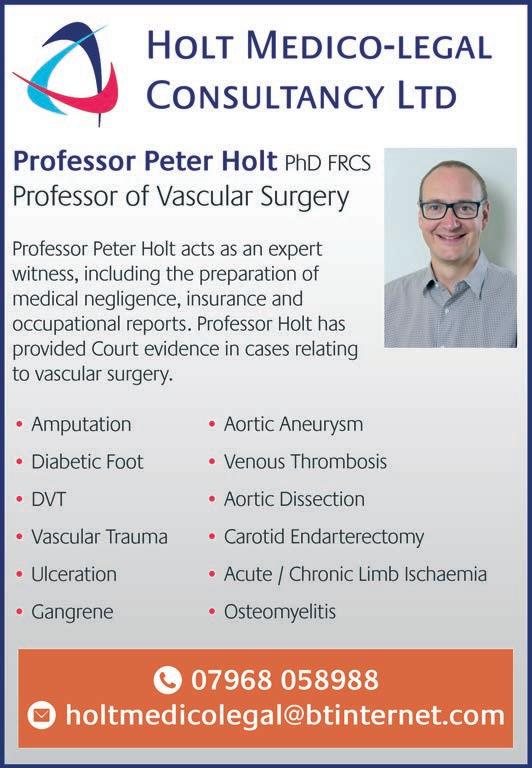
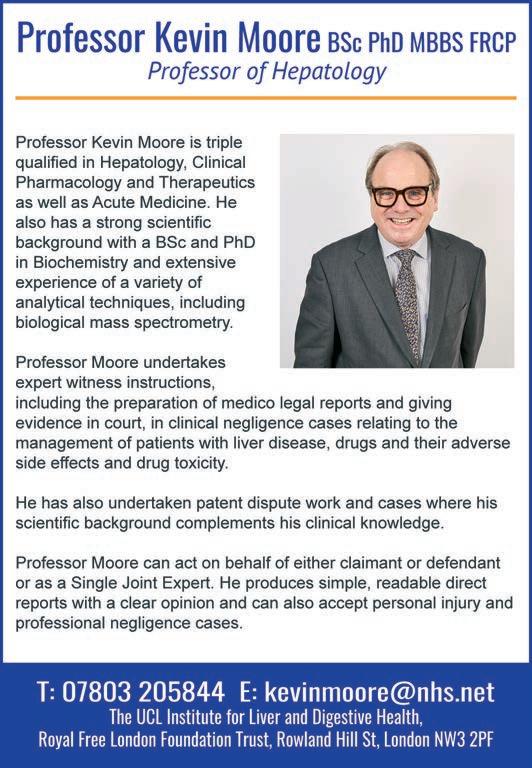
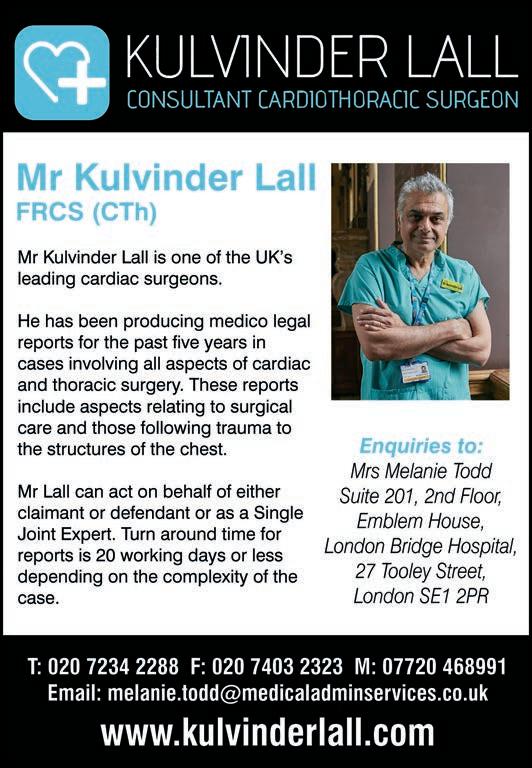
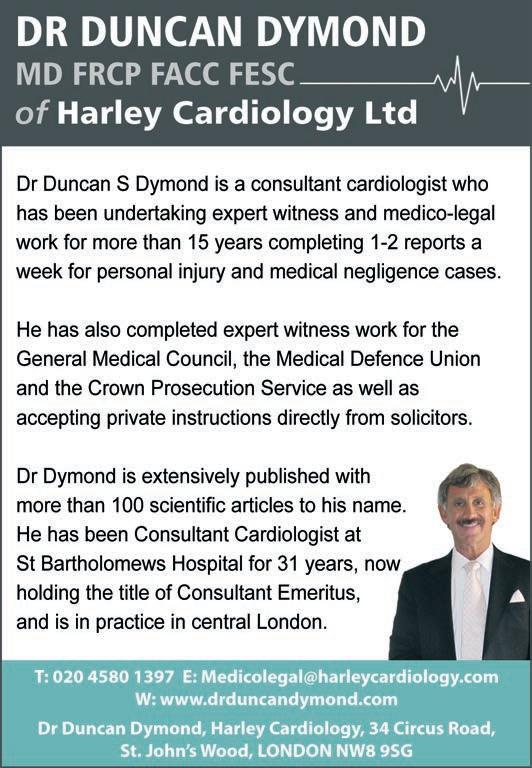
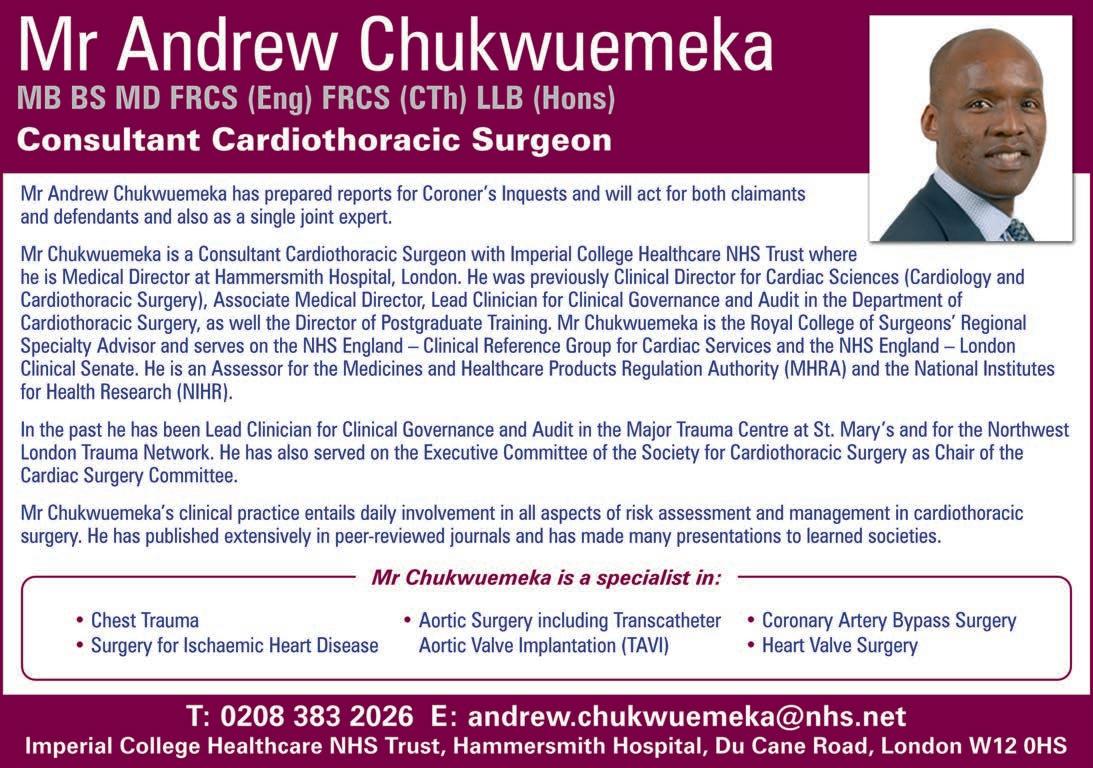
[THE PRESIDENT of the British Cardiothoracic Society (BCS), Professor André Ng, has joined the Arrhythmia Alliance in calling for better treatment for patients with atrial fibrillation (AF). Atrial fibrillation is the most common heart rhythm disorder, affecting around one and a half million people in the UK –with a suspected quarter of a million people yet to be diagnosed.
People with AF are five times more likely to have a stroke; and if they do, it is likely to be more severe. It also causes heart failure and has a detrimental effect on the patient’s quality of life.
Yet across the UK there is variable access to the most effective treatments, due to a combination of ineffective care pathways, delays in referral and lack of access to one of the most effective treatments: cardiac ablation.
Professor Ng (pictured) joined Mrs Trudie Lobban MBE, the founder of Arrhythmia Alliance, at an event at the House of Commons to celebrate 21 years of the Alliance and call for better treatment for AF patients. The event, One Heart, Many Rhythms: Awareness, Action, Advocacy , took place on 11 June and featured presentations on cardiovascular disease challenges and improvements, and examples of good practice.
Professor Ng talked about unlocking access to ablation treatment for AF patients, including how virtual wards and technology can improve patient outcomes. He underlined the importance of treating patients with acute AF with the appropriate treatment early, as otherwise they risk being sent back to primary care, creating further delays and more health risks.
At Glenfield Hospital, where Professor Ng leads a team, increased focus and investment have meant patients have been receiving the most effective treatments more quickly –reducing disability and health risks for patients while reducing admissions and bed days, which saves the hospital money.
For one of the most effective treatments – ablation – the UK lags behind European countries, for example France and Germany, who have rates of ablation 3-5 times higher. In the UK, the lack of access is due to referral delays, inefficient care pathways, lack of NHS capacity and a lack of dedicated general anaesthetic provision for the procedure.
Professor Ng and the other speakers joined Mrs Lobban in calling on the NHS to implement best practice in care for AF patients to reduce heart failure, strokes and save more lives. q

[ THE HEART CARE waiting list fell in June 2025, latest figures from NHS England show. There were 405,414 people waiting for ‘routine’ cardiac care in England at the end of June, down from 409,800 in May.
The figures, published on 14 August, also show that there was a fall in the number of people waiting 18 weeks or more, from 157,358 in May to 153,908 in June. In addition, the proportion of people on the list who have been waiting that long for what is time-sensitive cardiac care is still 38%
There was a slight fall in the number of people waiting over a year for cardiac care, to 7,529 in June: down from 7,848 in May.
The longer people wait for treatment, the higher their risk of becoming disabled from heart failure or dying prematurely.
Dr Sonya Babu-Narayan, clinical director of the British Heart Foundation and a consultant cardiologist, said: “While recent downward shifts in waiting list numbers appear encouraging, we know there are still far too many heart patients waiting far too long for vital care – waiting longer than 18 weeks is potentially dangerous when it comes to the heart. Extended waits for procedures such as stents, pacemakers or heart valve surgery risk disability or even death that could be avoided if treatment happens in time.
“The government has rightly committed to reducing premature deaths from heart disease and stroke by 2035. Ensuring that people get the heart care they need, when they need it is critical to achieving this aim.” q

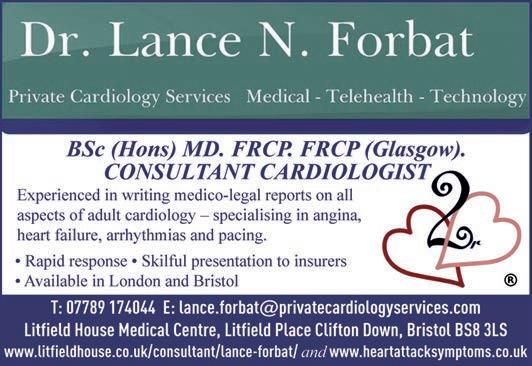
[ THE Advertising Standards Authority (ASA) has taken action against nine advertisers who, against the law and its rules, have been promoting weight-loss prescription-only medicines (POMs) to the public. The action is part of an on-going, multipronged and tech-assisted approach to tackling ads for those drugs.
Using an AI-based ‘active ad monitoring system’ (AAM) to monitor for problem ads and launch proactive investigations, they have published rulings that make it crystal clear that all injectable forms of weight-loss medication are POMs and cannot be advertised, even where ads don’t explicitly name a medicine. That work is shaped, in part, by what’s happening more broadly in society.

According to the ASA: “Turn on the TV, read a newspaper, browse social media; chances are you’ll have seen or heard about weight-loss POMs. In a short space of time they have become part of a national conversation. They are a central plank in government’s health plans to tackle obesity. Public awareness and interest in these drugs is high.
“We’re not here to regulate the drugs, their safety or availability. And we acknowledge the role they might play in combatting obesity. But we are here to protect people from irresponsible and, in the case of weightloss POMs, illegal ads.”
The law prohibits POMs from being advertised to the public for good reason, the ASA says. They are powerful drugs which can only be prescribed after consultation with a medical professional and require appropriate medical supervision. They are not a cosmetic treatment to be used without serious consideration and advertisers should not be promoting them to the public.
That’s why in December they issued a warning to businesses and individuals targeting the public with ads for the medicines. And they set out the ASA’s commitment to an extensive rolling programme of monitoring, investigation, enforcement action and partnership working.
The investigations and rulings sit alongside extensive monitoring and enforcement work that the ASA been carrying out since it launched the project. It has enabled them to check ads at pace and scale, identify problems, provide intelligence to its compliance and investigations teams and take action as needed. That has included monitoring weightloss POM ads from 35 high-priority pharmacies who had been the subject of a complaint to the ASA since December or been identified as potentially problematic by its AAM, and capturing over 20,000 ads from
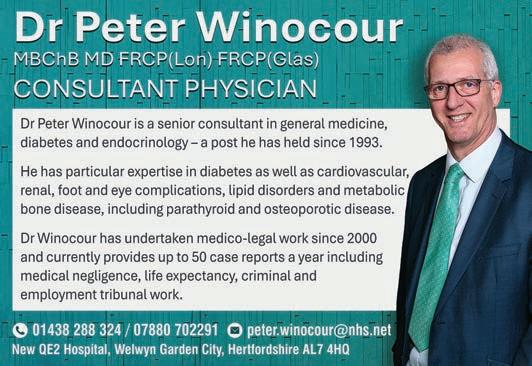
those pharmacies: 10,000 of which were for weight-loss treatments.
Of those, 80 ads were found to directly use or mention a named weight-loss drug name. That points to over a 99% compliance rate for that strict element of the rules. Most of the ads did not reference a named weight-loss POM, but instead used imagery of weightloss pens, or strongly implied the use of weight-loss POMs without naming the drug – something which the ASA’s rulings address.
The ASA continued: “In all of this we continue to work closely with our partners, the Medicines and Healthcare products Regulatory Agency (MHRA) and General Pharmaceutical Council (GPhC). We issued a joint Enforcement Notice to all 13,214 pharmacies registered with the GPhC, putting pharmacies on notice of our action in this area and which has led to improved compliance rates in paid-ad space.
“We’ve taken an education-first approach and proactively contacted advertisers not sticking to the rules and given them the tools to comply. And we put on a joint training webinar with GPhC and MHRA for pharmacies, attended by 480 delegates, on how the rules apply and the help and guidance that’s in place.
“These issues won’t be resolved overnight, we know the scale of the problem and that means approaching this in a methodical, phased way. We’ll continue to make sure weight-loss providers take their medicine rather than advertising it.” q

By Rick Miller MSc RD MBDA, consultant dietitian and medico-legal expert witness
[ GLP-1 AGONIST WEIGHT-LOSS INJECTIONS are booming alongside bariatric surgery, which is now a routine approach to obesity treatment. Yet, as obesity treatment further advances, so too does something else – the potential for litigation: often not around the procedures themselves but in terms of the ‘wraparound care’ being woefully inadequate.
We’re now seeing a wave of claims surrounding what was missed: vomiting ignored, weight loss unchecked, nutrition unmonitored. And the consequences are quite often catastrophic: neurological injury, blindness, irreversible brain damage – all from nutrition-related deficiencies or issues that never needed to happen.
As a consultant dietitian and expert witness that is often where I get contacted, because behind the allure of rapid weight loss lies something less headline-grabbing but legally explosive: failure to meet the duty of care in weight-loss treatment nutritional planning.
Take the case of ‘Molly’, who underwent a gastric sleeve procedure on the NHS. She followed the diet plan, but began vomiting 15-16 times a day. Despite two hospital visits, clinicians missed a critical thiamine deficiency.
When it was finally diagnosed it was too late. She had developed Wernicke’s encephalopathy – a life-altering brain injury resulting from thiamine deficiency that left her visually impaired, dependent on care and unable to work. The NHS trust settled for over £2.7m.
Or take the case of a 33-year-old man, post-bariatric, who developed the same deficiency. He is now permanently blind, cognitively impaired and wheelchair-bound. His claim was settled for £2.8m plus lifelong annual payments.
In Sheffield a third patient suffered nerve damage after reporting she couldn’t tolerate post-operation vitamins. The trust persisted with oral supplements despite clear signs of intolerance and eventually settled for £100,000.
Each case had one thing in common: missed opportunities for nutritional intervention.
The GLP-1 ‘litigation time bomb’ is ticking
It isn’t just about surgery: GLP-1 drugs like semaglutide (Wegovy) and liraglutide (Saxenda) are now becoming widely prescribed for weight loss in the UK. But legal scrutiny is catching up.
Investigations have uncovered telehealth clinics prescribing these powerful agents without verifying BMI or assessing risk factors. One UK nurse died after two doses of tirzepatide (Mounjaro) – her death certificate listing pancreatitis and multiorgan failure, with the drug contributing.
In the US, over 1,600 lawsuits have been filed against semaglutide manufacturers over complications such as gastroparesis.
Legal analysts warn the UK is next, but more quietly. The Medical Defence Union has cautioned clinicians that prescribing GLP-1 agonists without adequate patient knowledge, consent documentation or follow-up could expose them to claims. Without nutrition support, those drugs can lead to malnutrition, gallstones or dangerously low nutritional intake, especially if side effects like nausea or vomiting are not actively managed.


Duty of care: it doesn’t end at the prescription pad
Whether it’s a prescription or a surgical procedure, obesity treatment fundamentally alters a client’s relationship with food. Appetite changes, absorption of nutrients changes, and as a consequence nutritional risks skyrocket.
NICE NG69 and NHS TA875 guidelines make it clear: post-treatment care must include nutritional monitoring and supplementation. For bariatric patients, that means lifelong follow-up and annual nutrition bloods. For GLP-1 users, that means ensuring they understand dietary adjustments and side effect risks.
And yet I see case after case where patients are left to fend for themselves after treatment commences. It’s there that claims emerge.
Why medical nutrition and dietetic expertise matters in court
Legal teams are increasingly recognising the value of instructing a registered dietitian expert witness in these matters, given their experience in both acute and outpatient settings across a broad spectrum of clinical conditions.
In weight loss mismanagement cases, I’m often asked to clarify:
• Was the client given appropriate and timely nutritional
• guidance?
• Did the care team follow clinical guidance and wider (eg.
• ESPEN) standards?
• Were signs of malnutrition, deficiency recognised and, more
• importantly, acted on?
• Could earlier intervention or escalation have prevented harm?
In short, was the duty of nutritional care breached and, on the balance of probabilities, did it lead to the medical issues the claimant now is left with?
Expert dietetic opinion helps courts understand what should have happened, why it didn’t and how that failure led to often life-altering outcomes.
The clinical nutrition is the new negligence frontier
This isn’t about demonising obesity care; it’s about raising the bar for what safe, ethical and legally defensible treatment looks like.
If you’re litigating a case involving Wegovy, Saxenda or bariatric surgery, and nutritional harm is even suspected, a dietitian expert may be the link that turns the story into a case. In obesity litigation, nutrition management is no longer peripheral: it’s central. q
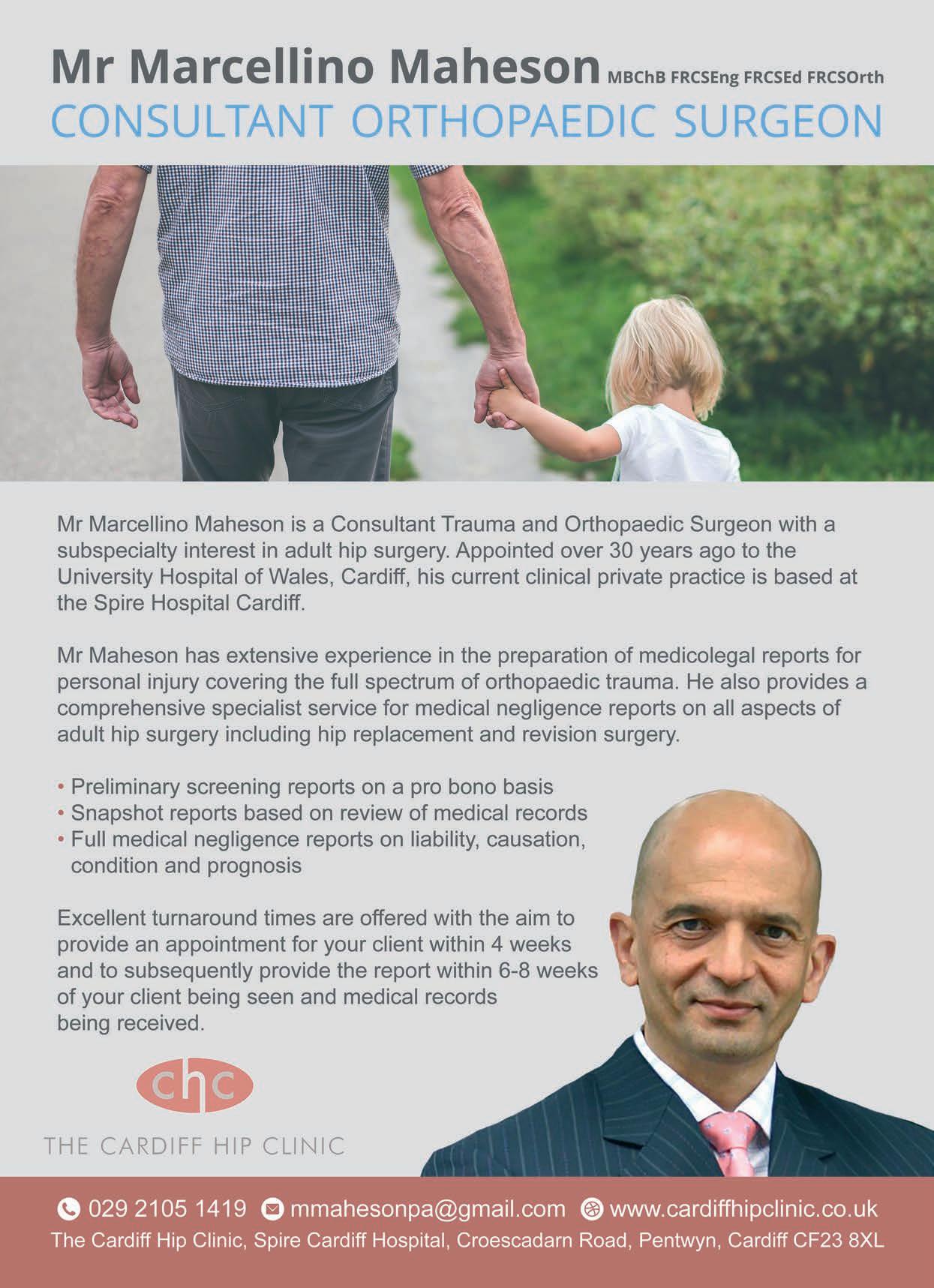
[ TOTAL HIP REPLACEMENT is one of the most common elective orthopaedic procedures, and its success has transformed mobility and quality of life for thousands of patients. Yet, as with any surgical intervention, it carries risks. Complications such as implant failure, post-operative infection, fractures or issues arising from surgical technique can have profound consequences.
Claims involving hip replacement often hinge on whether complications were avoidable or represent recognised risks. Implant failure may arise from mechanical issues, surgical error or patient-related factors, while infections can result from lapses in peri-operative care or uncontrollable patient vulnerabilities.
Delayed diagnosis of fractures, whether peri-prosthetic or in adjacent structures, can have serious implications for mobility and long-term outcomes. Similarly, disputes over surgical technique – ranging from component positioning to fixation
methods – are common in contested cases, and the technical complexity of these procedures demands expert interpretation.
For solicitors and barristers, hip surgery experts provide critical guidance on numerous fronts. They assess whether the standard of care was met, whether consent procedures adequately informed the patient of risks, and whether complications could have been reasonably anticipated or prevented.
The rehabilitation process following hip replacement is another key area where expert evidence is often required. Early mobilisation, physiotherapy and weight-bearing instructions can significantly influence long-term function, and any shortcomings in post-operative management may exacerbate complications.
By assessing whether rehabilitation protocols were appropriately followed and whether deviations contributed to on-going disability, hip surgery experts offer the court a comprehensive understanding of both surgical and post-operative factors. q
[ THE NATIONAL HIP FRACTURE DATABASE has issued its report on performance in 2024 Room for improvement: hip fracture care in 2024
With over 70,000 people in England, Wales and Northern Ireland experiencing a hip fracture – and with an ageing population this figure could double by 2060 – it is important to both improve hip fracture patient care and to prevent this injury.
The report examines how care in 2024 aligned to the key patient goals of:
• Admission – how soon will I be made comfortable and admitted to the right ward?
• Operation – how is my operation explained and supervised, so I can get up afterwards?
• Rehabilitation – how will I be supported to get back on my feet after surgery?
• Care quality – will I receive the same quality of care as other people?
• Care consistency – does every fracture lead to the same quality of care?
Among the key findings the 2024 report found that emergency departments know that each day at least one person will need urgent admission for hip fracture surgery. But in 2024, patients still spent an average of 15 hours waiting before being made comfortable in a bed, on a ward appropriate to their needs.
A quarter of people who break their hip will have another fragility fracture in the future. The majority of patients (58%) now receive bone strengthening medication, but in 2024 10 hospitals (6%) discharged over three-quarters of their patients without effective bone protection.
The key recommendations include that, by April 2026 all Integrated Care Boards, Health Boards in Wales and Health and Social Care Trusts in Northern Ireland should:
• Require emergency and orthopaedic departments to agree fast track admission policies, so that at least one in five patients reach a specialist orthopaedic ward within four hours of admission with a hip fracture.
• Review each hospital’s National Hip Fracture Database data to ensure that at least 95% of patients are able to access surgery; that this is documented as having been supervised by a senior surgeon and that it allows them to get up fully weightbearing.
• Require each hospital to commission appropriate physiotherapy capacity so that all inpatients recovering from hip fracture can receive at least one session of physiotherapist-directed rehabilitation each weekend.
• Require all hospital teams to review their use of injectable bone
protection, so that at least half of all patients are recorded to be on bone strengthening medication four months after a hip fracture.
Mark Bowditch, president of the British Orthopaedic Association, said: “Whilst the surgical care of older people with a broken hip continues to improve, this report makes clear that there is still more to be achieved that will yield better outcomes for them.
“Of particular note is the decision to pilot the use of the results of the pelvic ring fracture audit to challenge the inequity in the management of fragility fractures in different anatomical sites.” q

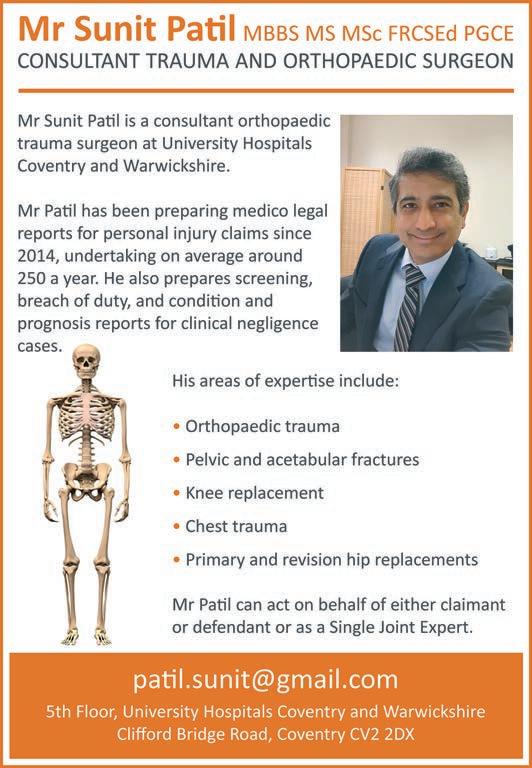
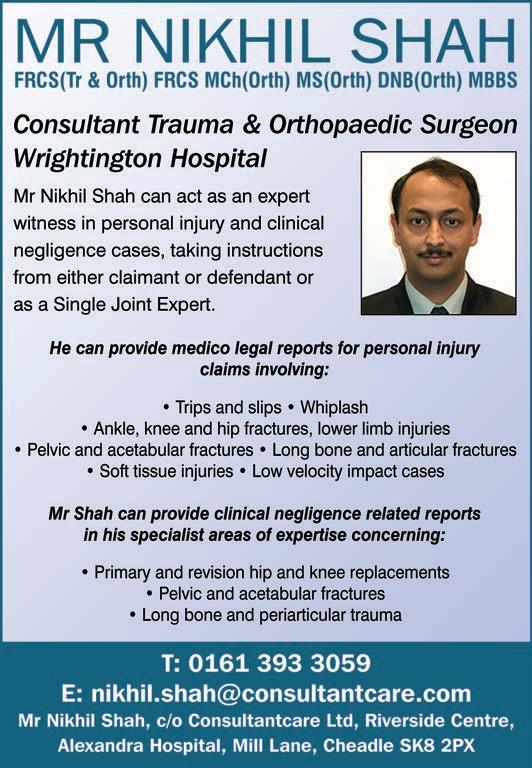
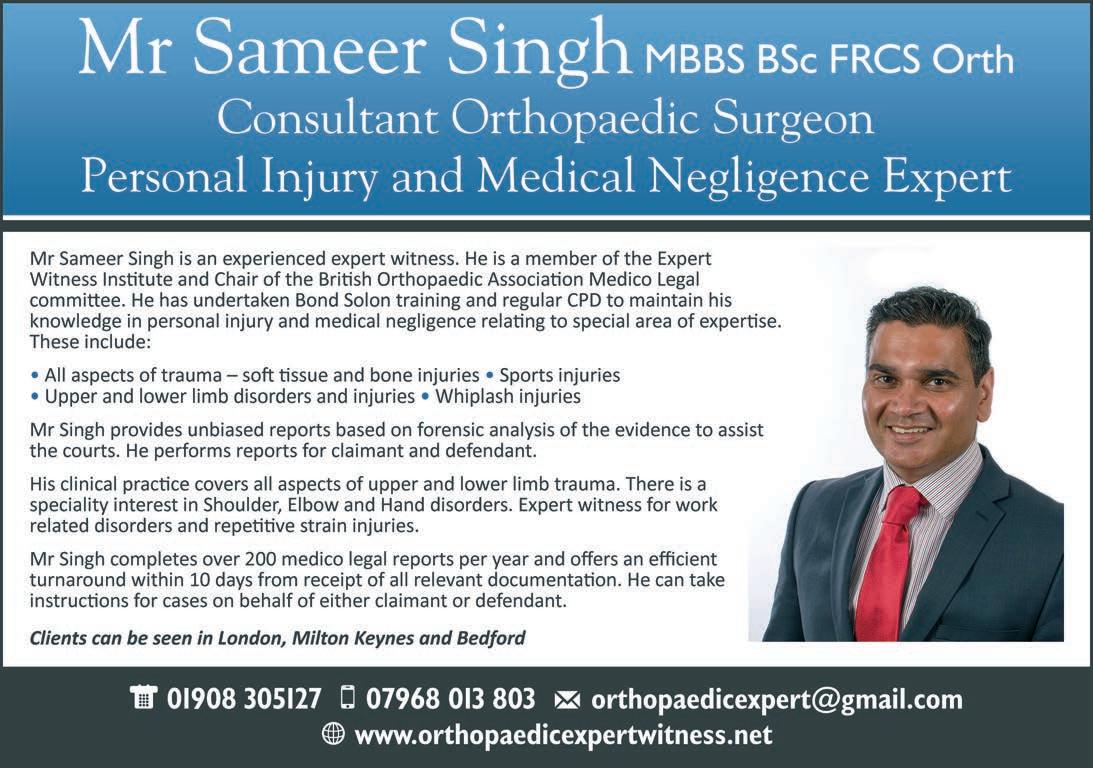
[AN MHRA INVESTIGATION has found increased risks of wear and corrosion, including an increased occurrence of device fracture and revision surgery, associated with cobalt chromecontaining Profemur modular neck hip stem components.
The majority of patients implanted with those hip replacements have well-functioning hips and are thought to be at a low risk of developing serious problems; a small number of patients implanted with those hips may, however, develop soft tissue reactions or other metal-related effects resulting in the need for revision surgery.
The MHRA, with the support of the British Orthopaedic Association and the British Hip Society, has recommended that NHS trusts and provider hospitals should review local and national databases, for example the National Joint Registry, to identify patients implanted with the specified devices and all identified patients should be contacted and invited to attend a virtual or face-to-face clinical review under the prioritised conditions.
All patients should be invited for clinical review as soon as practically possible if implanted with the recalled CoCr modular neck product code
PHAC1254 (Highest Risk Group) or implanted with a CoCr neck on either a Profemur or Ancafit titanium alloy or Profemur Xm CoCr stem: that group includes patients whose implant material combinations are unknown – the moderate risk group. Priority should be given to the highest risk group of patients. Patients implanted with a titanium alloy neck on a Profemur Xm CoCr stem should be invited for clinical review only if they are concerned or have symptoms such as pain, loss of function or instability – the lowest risk group. q
[ A PAINFUL yet misunderstood upper limb condition is lateral epicondylitis: tennis elbow. While often the result of everyday activity involving repetitive activity, it can also be the result of negligence in the workplace or even a car crash.
According to claims specialists InjuryClaims.co.uk: “Tennis elbow is a painful condition that causes soreness and swelling around the outside of the elbow. It often develops due to repeated use of the forearm muscles situated near the elbow joint. Its symptoms can be debilitating and affect your ability to work and carry out daily activities.
“The condition can affect workers in many industries, such as construction, production workers, plasterers and plumbers. Employers must identify health risks to employees and take reasonable measures to reduce or eliminate them. If your employer has failed to protect you, you might be eligible to make a tennis elbow claim against them.”
Despite its name, tennis elbow is not limited to tennis players; it can affect anyone who engages in repetitive arm and wrist motions. It is typically due to inflammation or damage to the tendons in the forearm near the elbow.
InjuryClaims.co.uk continues: “Tennis elbow is diagnosed based on your medical history and a physical examination. A doctor may also order imaging tests like X-rays or MRI scans to rule out other causes of the problem and show the extent of the damage. A personal injury solicitor could help start a tennis elbow claim if the condition developed due to someone else’s negligence. The symptoms develop slowly and are often overlooked during the initial stages.”
Another cause of tennis elbow that may result in a claim is a car crash. Claims specialist LegalExpert.co.uk explains: “If you did suffer a permanent elbow injury from a car accident, it could greatly affect the amount of compensation you would receive should your claim be successful. This is because the compensation is based on the extent and severity of your injury.

“You may be wondering: ‘How can you suffer tennis elbow from a car accident?’. Similar to other elbow injuries that can be caused by a car accident – such as a sprain, dislocation or fracture – it depends on how your arm has been affected by the crash. If your arm has been pulled and stretched or had excessive pressure on it from, for instance, a car door, it could cause you to develop tennis elbow.
“Other ways you could suffer tennis elbow from a car accident include the force of impact jolting your braced arm as you’re crashing, your elbow striking part of the car during the moment of impact or your arm becoming strained due to debris falling on it. That could result in your arm being in an awkward position, leading to you making an elbow injury claim.” q

[NHS ENGLAND’S Getting It Right First Time (GIRFT) programme has launched a new workstream aiming to ensure that more patients living with chronic pain – including children and young people – receive personalised, holistic and evidence-based care, with seamless transitions between services.
Working in collaboration with the Faculty of Pain Medicine (FPM), the British Pain Society and wider stakeholders, GIRFT has appointed a clinical lead and two clinical advisors to lead the new chronic pain workstream. The leadership team have expertise in pain medicine, primary care and paediatric academic rheumatology, offering a unique diversity of approach across community, primary, secondary and tertiary care services, and across all stages of life.
System level peer reviews will be carried out with providers of pain management services to identify variation and challenges, and to develop a structured, best practice model. Areas of focus include the effect of inequalities and personalised care related to the management of pain, pain education, digital offers, support to return to work or school, reducing harm from medication and access to multidisciplinary pain management programmes.
Data from the FPM’s 2025 Gap Analysis document, which describes the variation in service delivery, commissioning and provision against the faculty’s Core Standards for Pain Management Services, will feed into the reviews.
The three new GIRFT clinicians are:
• Dr Helen Makins (clinical lead): consultant in pain medicine and anaesthesia, working clinically with both adults and children in Gloucestershire. Helen has worked extensively on projects for people with pain, from community-based social prescribing projects for children to holistic clinical pathways and evidence-based criteria for pain interventions. Helen is an elected member of the Faculty of Pain Medicine board.

• Dr Jacqui Clinch (clinical advisor, children and young people): consultant in paediatric and adolescent rheumatology and rare bone disease at the Bristol Royal Hospital for Children and medical lead of the Bath National Pain Service for children and young people.
• Dr Graham Syers (clinical advisor): GP partner at Alnwick Medical Group in Northumberland and a clinical lead with the North-East and North Cumbria ICB, where he chairs the Northumberland System Transformation Board and is vice chair of Northumberland Health and Wellbeing Board.
Dr Helen Makins commented: “This GIRFT programme is an exciting and long-awaited opportunity for the field of chronic pain management, and I am delighted and privileged to lead it. I know that there is much excellent work and innovation occurring in all parts of the system and we will be looking to shine a light on best practice, while identifying ways to share this equitably around the country. Importantly, this work will link closely to other relevant GIRFT workstreams and key stakeholders.
“Through liaison with multidisciplinary health and social teams, third sector organisations and patients, we will provide recommendations for improvement which are both fit for the future NHS and benefit the large number of people of all ages experiencing chronic pain.” q

[
FOLLOWING ITS previous position statement around modified release (MR) opioids and the treatment of post-operative pain
(YEW Issue 73), the Faculty of Pain Medicine has issued a further statement to make clear its position on modified release opioids and acute pain:
MR opioids are not suitable for postoperative pain in opioidnaïve individuals. Acute pain should be managed with short-acting opioids, if opioids are needed.
Modified-release or long-acting opioids are generally not appropriate for managing perioperative and other forms of acute pain due to:
• Risk of accumulation and overdose, especially in opioid-naïve patients
• Delayed onset and offset, which makes titration difficult
• Prolonged adverse effects (eg respiratory depression)
• Increased risk of long-term prescribing/use of opioids.
The statement goes on to say that MR opioids may be considered for patients already on a stable long-acting opioid regimen for chronic pain or palliative care, to prevent withdrawal and maintain analgesia – in particular when the long-acting opioid is being prescribed for pain that is not directly related to the scope of surgery. In those patients specialist acute pain input is recommended to explore whether the long acting opioid dosage needs to be adjusted.
They may also be considered in acute pain, with specialist pain team input and appropriate monitoring. That is in exceptional circumstances, balancing the risks and benefits on an individual patient basis while adhering to local policy and ensuring patient safety. q
[
RESEARCHERS HAVE SHOWN for the first time that a drug that prevents cancer cells from repairing can control the growth of mesothelioma – a rare and aggressive form of cancer caused by asbestos. The results of the NERO clinical trial were presented at the American Association of Cancer Research conference in April.
The findings provide new hope for patients with mesothelioma that has come back after initial treatment and could give people more time with their loved ones.
The NERO trial was run by researchers at the University of Leicester and the Cancer Research UK Southampton Clinical Trials Unit and was funded by the charity Asthma + Lung UK.
A new hope for patients
Mesothelioma is an aggressive cancer that forms in the lining of the lungs or abdomen and is linked to breathing in or ingesting dangerous asbestos fibres.
“Currently, only around 5% of people diagnosed with mesothelioma will survive for five years or more,” said Professor Dean Fennell, Chair of Thoracic Medical Oncology at the University of Leicester and co-lead of the NERO trial. In patients where initial treatment is
unsuccessful and the cancer comes back, there are very few further options. Most patients will therefore only receive treatment to control their symptoms, rather than cure the disease.”
The NERO trial looked at a class of drug known as PARP inhibitors, which work by blocking the repair of damaged DNA in cancer cells, thereby causing the cancer cells to die. PARP inhibitors have already been shown to improve the survival of patients with some types of breast and ovarian cancers.
A previous study had also shown that mesothelioma does respond to that type of drug, but more evidence was needed as to whether it can improve outcomes for patients.
In all, 88 patients whose mesothelioma treatment had stopped working took part in the trial at 11 hospitals across the UK. Those given a PARP inhibitor called niraparib were found to have a 27% reduction in the risk of the cancer progressing or death. It delayed the worsening of mesothelioma by an average of 1.5 months compared to those receiving the standard care treatments, with a number of patients seeing a much longer period of time where their cancer is being controlled.
“Although this increase may seem small,

[IN JULY HSE published the annual figures for deaths from mesothelioma. The figures show that 2,218 people died from the disease in 2023, representing a fall of 62 compared with 2022 and substantially lower than the average of 2,508 deaths per year over the 10-year period 2011-2020. Current mesothelioma deaths reflect exposure to asbestos that often occurred before the 1980s and annual deaths are expected to continue declining during the next decade. q
for this group of patients who have very few treatment options and a generally poor prognosis, this is a significant step forward,” explained Professor Gareth Griffiths, Director of the Southampton Clinical Trials Unit and co-lead of the trial. “We have shown for the first time that this kind of drug can improve progression-free survival for mesothelioma patients compared with their usual treatment in the NHS.
“This gives enormous hope to those patients and their families and means we can now carry out further research to find out more about how these treatments could be tailored and enhanced to stimulate an even better response in more people.” q

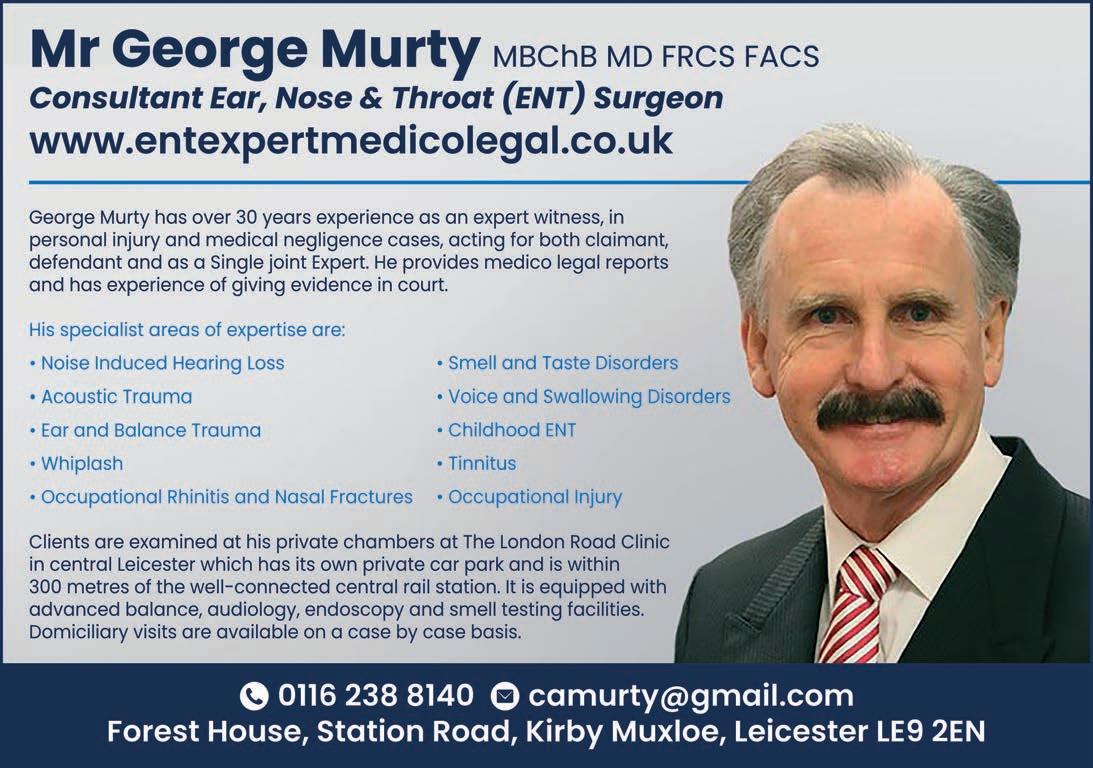

[A RECENT INSPECTION CAMPAIGN by HSE has identified significant failings in workplace hearing protection, uncovering issues with employee training and equipment management. One in four workplaces had noise levels requiring mandatory hearing protection, placing crucial responsibilities on employers to ensure proper provision and management of protective equipment. However, inspections revealed concerning gaps in implementation.
At high-noise workplaces, more than 75% of employees lacked essential knowledge about storing hearing protection, checking for damage or reporting equipment faults to employers. Nearly two-thirds (63%) had not received guidance on the critical importance of wearing
[THE British Irish Hearing Instrument Manufacturers Association (BIHIMA) has published the findings from its most comprehensive annual audiologist survey to date, offering an unflinching look at the mounting challenges facing the UK’s hearing care sector.
With significantly increased participation from NHS professionals alongside those in private practice, the 2025 survey provides the clearest picture yet of a profession under pressure. Key concerns include escalating NHS waiting times, staffing shortages, limited access to care and the unresolved national issue of ear wax removal.
“This year’s survey has brought into focus the growing burden our audiology professionals carry and the disconnect between what they’re able to provide and what patients truly need,” said Paul Surridge, chairman of BIHIMA. “We must act decisively and collectively: to expand access, to standardise service quality and to elevate the profession through education, investment and public awareness. We know that that demand is far higher than our current service levels can meet and something needs to change if we are able to improve conditions for patients and professionals alike.
“Hearing health is connected to every aspect of our overall health, so this is not a challenge we can afford to ignore. We’re talking about people’s quality of life, and we all have a stake in that.”
BIHIMA is urging stakeholders – from healthcare leaders to policymakers and manufacturers – to engage with the profession’s concerns and help co-create a more resilient, accessible and stigmafree hearing care system. q
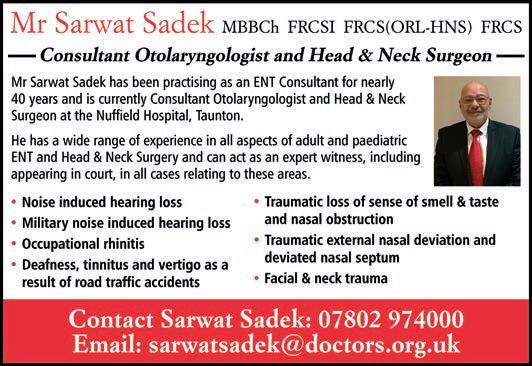
protection continuously during exposure to harmful noise levels.
Training deficiencies were particularly evident, with 80% of employees receiving no instruction on proper wearing techniques, including avoiding interference from hats and hoods, keeping hair clear of earmuffs or ensuring compatibility with other personal protective equipment such as hard hats and eye protection.
Most significantly, 95% of employers had failed to verify whether workers wearing hearing protection could still detect vital warning signals, including fire alarms and vehicle reversing alerts.
Chris Steel, HSE’s principal specialist inspector, said: “The gaps that we found in implementation are serious. They place an added risk to workers of excessive exposure to noise when they may believe they are being protected.
“If your defence against workplace noise is to give your workers hearing protection then you need to check that it works. How confident are you that the hearing protection you have supplied is in good order, is being worn when it should be, how it should be, and that it is not stopping your workers from hearing warning signals?”
To address those issues, HSE is promoting the CUFF checking system to help employers assess hearing protection effectiveness.
The acronym covers Condition (equipment integrity), Use (proper deployment when needed), Fit the ear (correct wearing) and Fit for purpose (appropriate specification).
HSE specialists will deliver guidance at industry events and webinars, providing practical advice on implementing effective hearing protection programmes and using the CUFF system to safeguard workers from noise-induced hearing damage. q
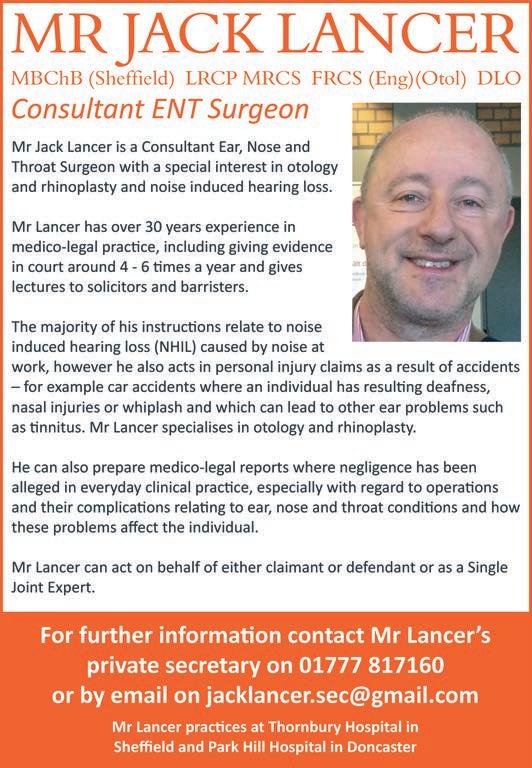
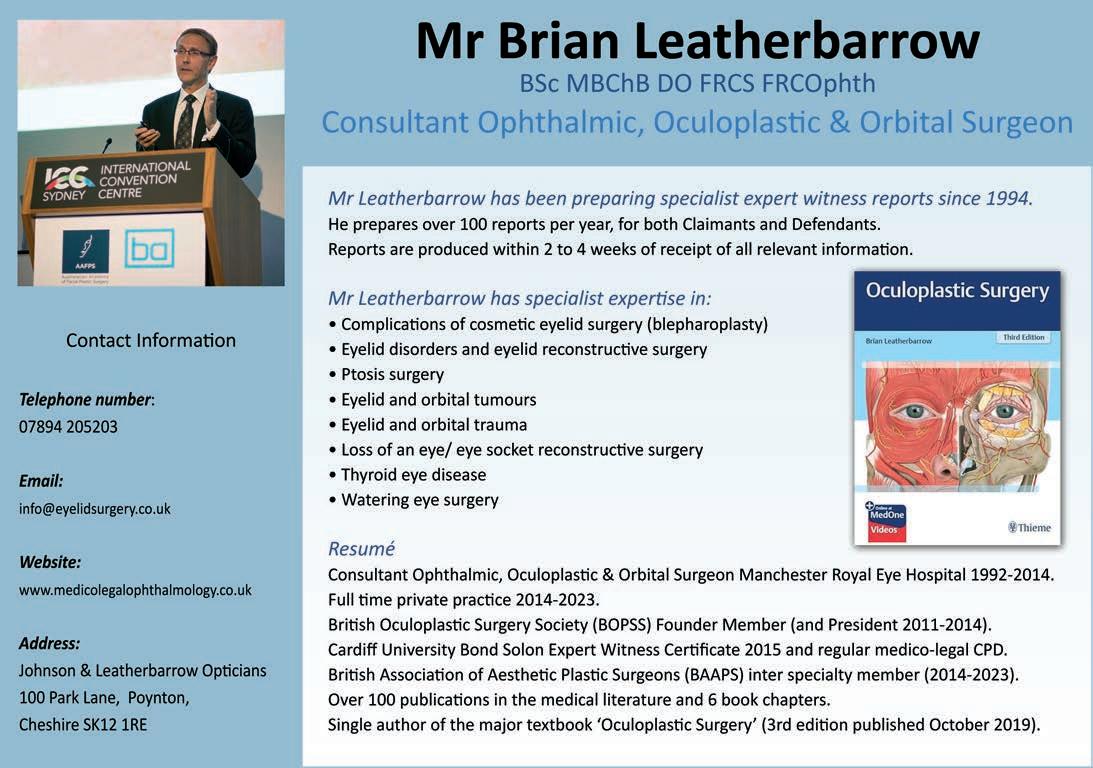

[SURGICAL OUTCOMES from cataract operations have consistently improved over the past decade, according to the results from the latest National Ophthalmology Database (NOD) cataract audit.
The rate of posterior capsule rupture or PCR – the major complication of surgery – has more than halved since 2014 and now stands at just 0.69%. That indicates that thousands of complications have been avoided, leading to significant benefits for patients and substantial savings for the NHS.
Around 200 centres contributed data to the audit, which looked at adult cataract surgery performed in the UK by traditional NHS
ophthalmology departments, independent sector treatment centres and private practices between 1 April 2023 and 31 March 2024.
The annual report is published on the NOD website at nodaudit.org.uk. It features a new easy-to-read format focusing on areas that are most important to clinicians and commissioners, with links to quality improvement opportunities. Centre-specific reports, which are being sent out to lead clinicians for presentation at departmental audit meetings, are also new for this year.
Introducing the report, RCOphth president Professor Ben Burton said: “Cataract surgery remains the most performed operation in the
[ THE COLLEGE OF OPTOMETRISTS and the Association of Optometrists have welcomed a move that will be the most significant shake-up of driving laws in a decade. Mandatory sight tests for drivers over the age of 70 could be included as part of an overhaul of driving laws in the new road safety strategy, set to be published in the autumn.
Dr Gillian Rudduck MCOptom, president of The College of Optometrists, commented: “An introduction of mandatory sight tests for drivers aged over 70 would be a welcome step in improving vision standards for drivers in the UK.
“But the rules could go further to ensure that UK standards are in alignment to those internationally. We are calling for a mandatory requirement for all drivers to submit evidence of an up-to-date sight test at licence application and renewal, every 10 years and then every three years from age 70, to align with age-related eye conditions and deterioration in visual function. This would enable early detection and treatment of eye conditions that may be otherwise asymptomatic, and utilises regulated sight tests that are delivered by registered optometrists on the High Street across the UK.”
Adam Sampson, chief executive of the Association of Optometrists, added: "We welcome the potential changes to driving laws in England and Wales that will tighten up vision standards, as a long-overdue step toward modernising road safety. The introduction of compulsory sight tests for motorists over 70, alongside wider changes, signals a decisive break from complacency in the face of preventable tragedies.
“For too long, the UK has relied on a self-reporting model for visual standards – one of the laxest regimes in Europe – despite mounting evidence that it puts lives at risk. We have long called for changes to a system that simply isn't working in the interest of public safety.
“The recent inquest into deaths caused by drivers with eyesight problems laid bare the human cost of inaction. Introducing routine sight tests for drivers is a proportionate and necessary response to ensure fitness to drive – and something that we have been clear about in our calls to government.”
The UK is one of only three European countries to rely on selfreporting of visual conditions that affect a person's ability to drive.
In April, HM Senior Coroner for Lancashire Dr James Adeley brought an inquest into four road deaths, in which the Association of Optometrists and College of Optometrists gave evidence. Dr Adeley sent a report to Transport Secretary Heidi Alexander to say action should be taken to prevent future deaths, after he found enforcement of visual legal standards for drivers was ‘unsafe’. q
NHS, with over 680,000 procedures undertaken annually in England alone. The scale of this service demands robust quality assurance, particularly as we see an increasingly diverse landscape of providers delivering cataract care. This year’s report continues to demonstrate the remarkable improvement in surgical outcomes over the past decade.
“I would like to thank all the contributing centres and the dedicated National Ophthalmology Database team who make this work possible. Together, we are ensuring cataract surgery in the UK continues to be among the safest and most effective in the world.” q



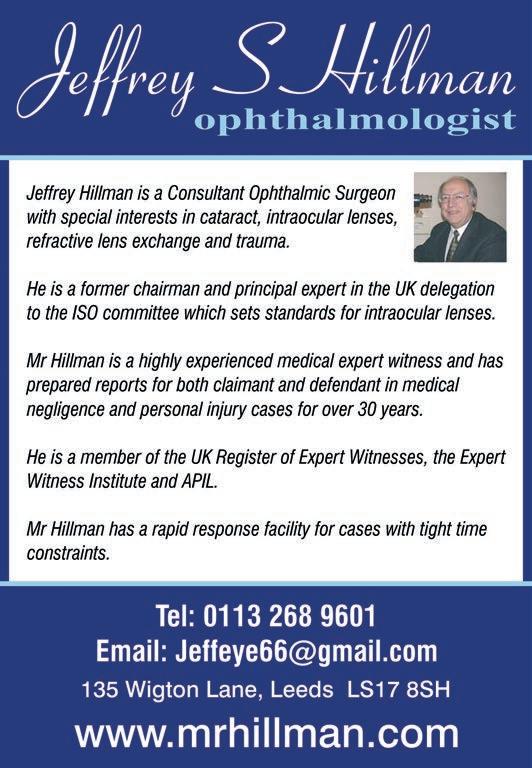

[THE ROYAL COLLEGE OF OPHTHALMOLOGISTS is leading an urgent joint call for the national standardisation of electronic health records (EHRs) in eye care, which it believes is essential to improve services, outcomes and patient experience.
Organisations representing professionals in primary, secondary, NHS and independent care settings, including The College of Optometrists, Independent Healthcare Providers Network (IHPN) and the Professional Record Standards Body, have united to appeal for agreed eye-care information standards. In a newly-published position statement, they make several asks of policymakers. They include:
• Commissioning eye care information standards based on datasets developed by the Royal College of Ophthalmologists and The College of Optometrists
• Alignment of EHR systems with those standards
• Making the necessary financial investment
• Training staff to collect and input patient information into EHRs.
RCOphth president Professor Ben Burton said: “For some time now, we have recognised that joint working and standardisation are key to improving our patients’ experience, and we are pleased to be working in collaboration with professionals across different eye care settings.
“The current lack of standardisation causes delays to diagnoses and treatments for patients and increased workloads and inefficient working practices for optometrists and ophthalmologists. It is clear that change and innovation are needed, and we are encouraged to see this recognised by the government with the announcement of the single patient record in the 10 Year Health Plan.”
Dr Gillian Rudduck MCOptom, president of The College of Optometrists, commented: “With primary care optometrists playing an important and growing role in the delivery of commissioned services and multidisciplinary shared care schemes, having access to standardised

electronic health records is key to improving patient care and enabling effective referrals, data sharing and communication. We look forward to collaborating with commissioners, developers and eye care professionals to ensure these recommendations are implemented.”
IHPN clinical director Dr Howard Freeman added: “Accurate and up-todate shared patient records are a vital part of delivering high-quality care, and as a major provider of eye care for both NHS and private patients, the independent sector is pleased to be working with the Royal College of Ophthalmologists to support calls for the standardisation of electronic health care records – ensuring that patients experience seamless care, regardless of where they received it.” q
[THE GENERAL OPTICAL COUNCIL (GOC) has published research on a risk-based framework for the testing of sight, to understand the risks of the different components of a sight test not being carried out at the same time, by the same person and/or in the same place. The study concluded that the separation of sight testing components by person, time or place may pose some risks for both the NHS and patients. However, in the context of a routine eye examination, the likelihood of these risks occurring was considered to be low.
It also found that tailoring eye care to individuals, for example through considering patients’ risk profiles more thoroughly, may offer significant advantages in the prevention, diagnosis and management of ocular conditions. Future studies were recommended to determine if a personalised approach based on patient risk assessment could be considered value for money and cost-effective.
The GOC’s director of regulatory strategy Steve Brooker explained: “This research comes at an important time, as technology is evolving and models are developing where parts of the sight test are carried out remotely from the patient and sometimes different elements are carried out by different people, in different places and at different times.
“We recognise the significance of the issues and the diversity of views about them, so will carefully consider the findings and their policy implications before deciding next steps. Initially, we will convene a roundtable in October 2025 to hear stakeholder views, as well as discuss the report with our advisory committees and council.
“I am grateful to the research team led by Glasgow Caledonian University for undertaking the study and to all those who participated in the Delphi exercise.”
The full report can be accessed at optical.org q
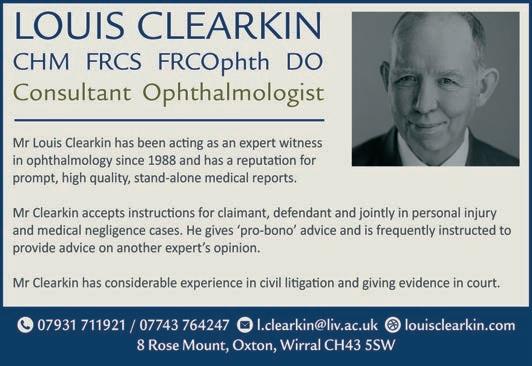

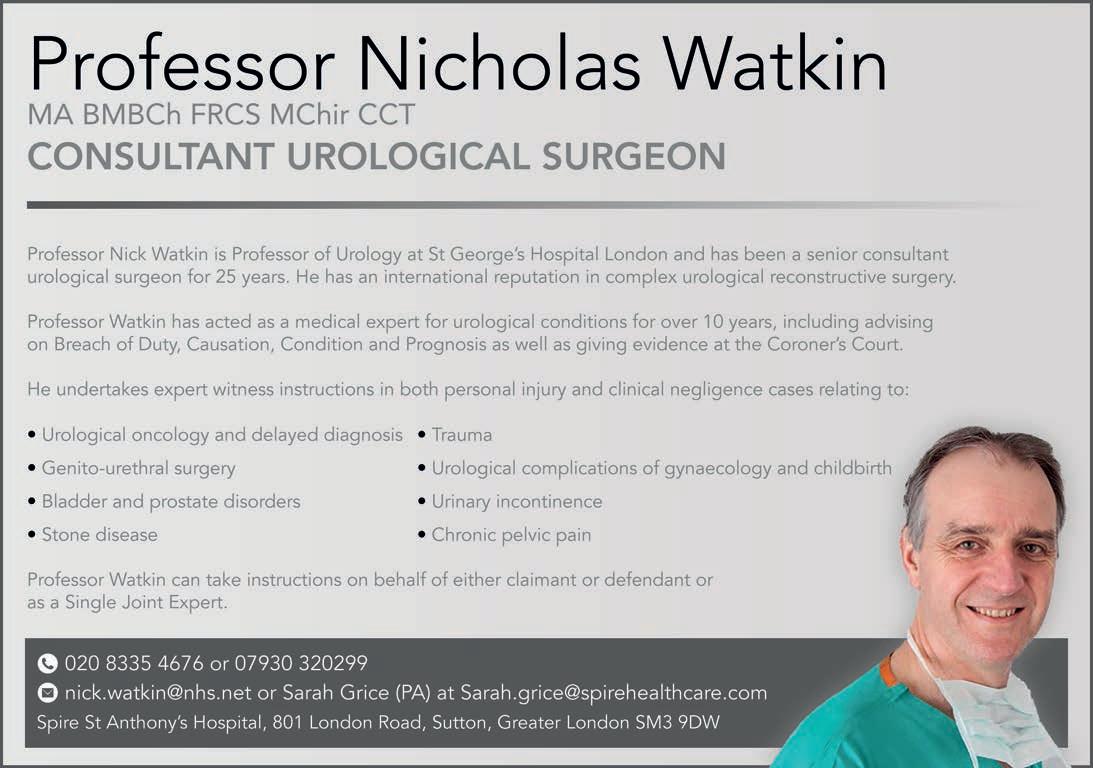
[ ONCE CONSIDERED a private medical issue, erectile dysfunction is now frequently encountered in high-value claims involving impact on quality of life, relationships and mental health. For solicitors, these cases require careful handling and are often dependent on clear and reliable expert evidence.
Erectile dysfunction can result from a wide variety of causes. Trauma to the pelvis or spinal cord may damage the nerves and blood vessels required for erectile function, while the condition is also a recognised complication following prostate surgery or radiotherapy. In some cases the side effects of prescribed medication play a role. Psychological trauma can also be a key factor, whether as a direct result of an accident or as a secondary consequence of injury.
Determining the true cause can be complex, especially where pre-existing conditions such as diabetes, hypertension or cardiovascular disease are present. In many claims the central question is whether erectile dysfunction can be attributed to negligence or trauma, or whether it would have arisen in any event. That is where the input of independent experts becomes essential. Urologists, endocrinologists and psychiatrists are often instructed to assess diagnosis, treatment pathways, causation and prognosis, and to explain the interaction between physical and psychological elements.
Specialists are able to advise on whether appropriate investigations were carried out, what treatment options should have been offered and whether delays or omissions worsened the outcome. Commentary may cover oral medications, devices, surgical interventions or counselling, and whether the claimant’s prognosis could have been improved with proper care. For younger claimants in particular, experts may need to consider the longterm consequences of a condition that affects intimate relationships and psychological wellbeing for many years to come. q
[ONE OF THE LARGEST settlements for compensation for erectile dysfunction, coupled with urinary incontinence, was reported by law firm FBC Manby Bowdler last year, who secured a settlement of £400,000 for a client who was left with life changing injuries following a negligent prostatectomy operation.
According to a post by the firm: “Our client suffered these injuries following negligent surgery, namely a prostatectomy performed by a consultant neurologist. Our client alleged that the consultant involved failed to counsel him in relation to active surveillance before surgery, and that there was a failure to inform our client as to the risks of surgery. There was also a failure to counsel our client in relation to a nerve sparing prostatectomy.
“Ultimately, the surgery was performed in a negligent manner which led to our client obtaining these avoidable injuries.”
Tim Gray, a partner in FBC Manby Bowdler’s personal injury department and head of its medical negligence team, acted on behalf of the client in this matter.
“Court proceedings were necessary, but Tim and the team managed to bring the defendant trust to a settlement meeting, where a settlement agreement was ultimately agreed by way of payment to the claimant of £400,000.” q

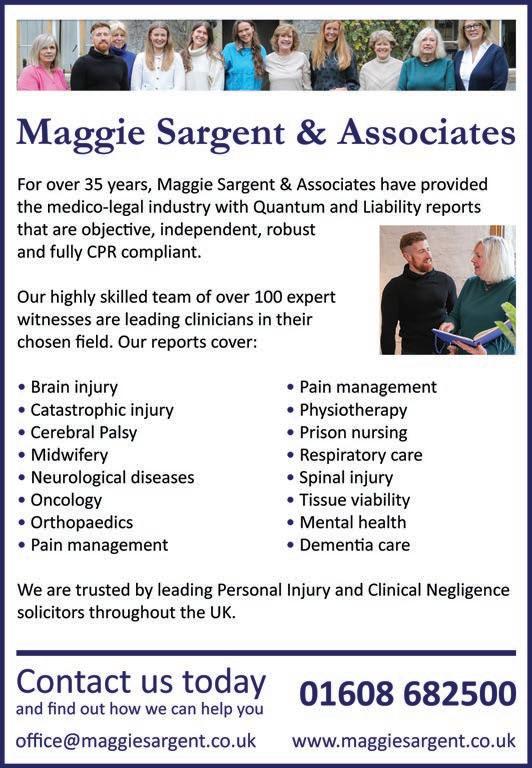
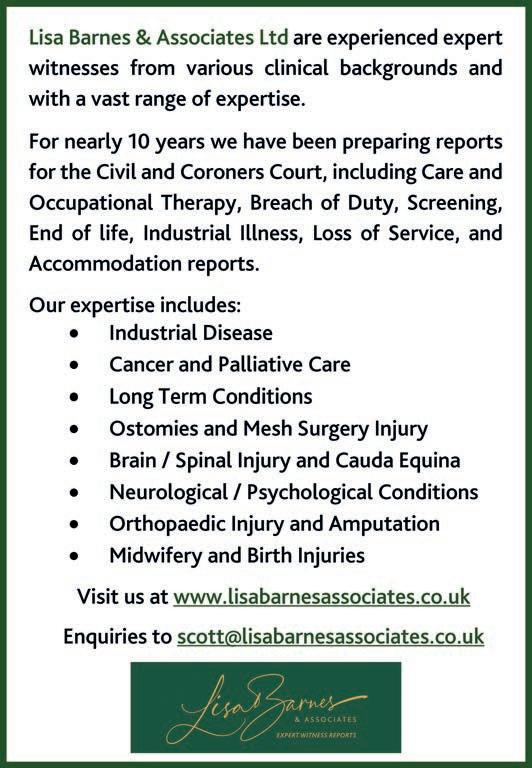

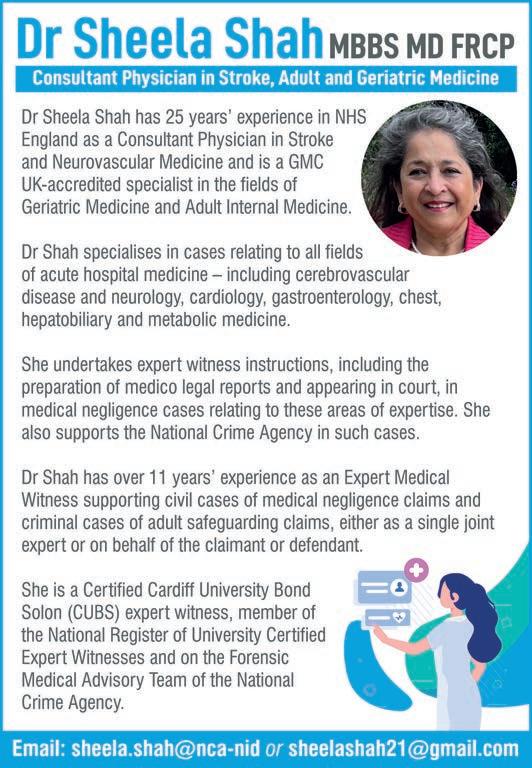
[STROKE – a life-threatening condition that occurs when the blood and oxygen supply to part of the brain is blocked or cut off – is more common among the elderly, according to the NHS: “You’re more likely to have a stroke if you’re over 55.”
And the therapies available for older patients may differ from the medical treatment given to others.
[A LEADING health and social care research centre, The Academic Unit for Ageing and Stroke Research (ASR) has a reputation for addressing key questions relevant to ageing and stroke. The focus of the ASR is applied health and social care research, with particular expertise in development and evaluation of complex interventions.
“We conduct high-quality research to inform changes in policy and to services. Our aim is to improve the health and well-being of older people, stroke survivors and their carers.
“A programme of multidisciplinary health and social care research has been developed, facilitated by a strong and supportive network of local and national research colleagues, NHS clinical staff, service providers and public representatives.”
The ASR is physically based in the Bradford Institute for Health Research on the Bradford Royal Infirmary site, and is also part of Leeds Institute of Health Sciences, University of Leeds.
Last year it was awarded a £892,518 research grant by Nuffield Foundation to establish the Well-being in later life in Bradford cohort study.
The 46-month study is being led by Andy Clegg, professor of geriatric medicine and consultant geriatrician at the University of Leeds and Bradford Institute for Health Research, and Jamilla Hussain, consultant in palliative care medicine and senior research fellow at Bradford Institute for Health Research, collaborating with experts from the Universities of Leeds, Manchester and Edinburgh and Hull York Medical School.
Another ASR initiative, the ADAPT study led by Dr Jess Johansson, has spent the past year exploring how to reduce sedentary behaviour after stroke. Through innovative research methods, the team identified four distinct types of stroke survivors: determined, passive, fearful and overwhelmed.
The study, funded by the National Institute for Health and Care Research, concluded in August and will provide tailored recommendations for supporting different types of stroke survivors. q
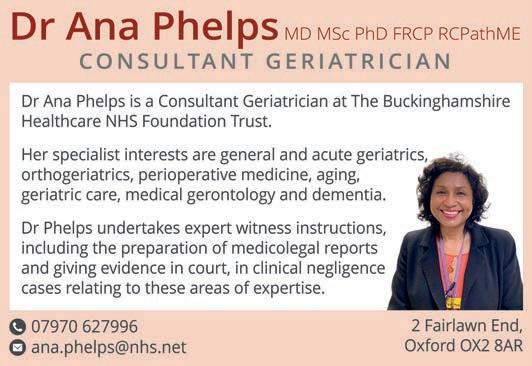
According to home care agency Helping Hands: “A stroke can impact individuals in different ways; for some, the effects may be minor and they can recover faster, whereas for others strokes can have a lifechanging impact.”
Ways in which the treatment of stroke in older patients is different:
Shrinking of blood vessels
The Stroke Association states that, as we age ‘our arteries naturally become narrower and harder’ and ‘more likely to become clogged with fatty material’, leading to an ischaemic stroke, the most common type of stroke. That is one of the leading causes of stroke among older people, but it can be treated with medication and treatment.
Higher risk of mortality

According to Helping Hands: “Age plays a significant risk in any condition and life expectancy after a stroke can decrease. That can be due to weakness in health and lack of mobility.”
Healthline states: “Regular exercise appears to lower chances of developing a blood clot. If older individuals are unable to stay active it can cause blood clots which can lead to a stroke. Therefore, extra support and attention are required.”
Recovery can be slow
Again, according to Helping Hands: “As we age, it takes a lot longer to recover from injuries and specific conditions like stroke. So older patients may need extra support from healthcare professionals to help with physiotherapy, mobility and speech. Also, lifestyle changes such as controlling cholesterol, managing diabetes and maintaining a healthy and active lifestyle can help with recovery.” q
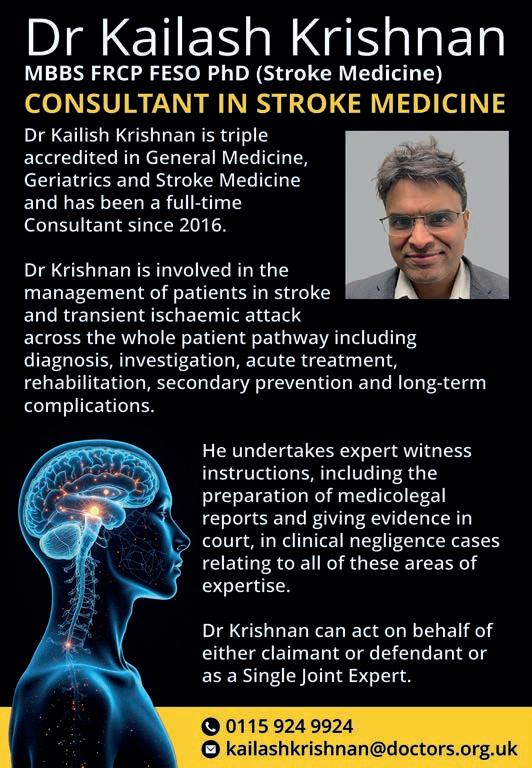
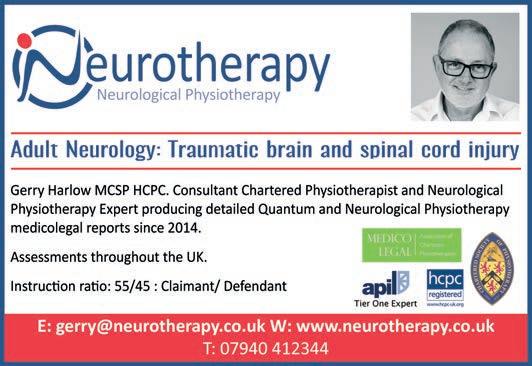

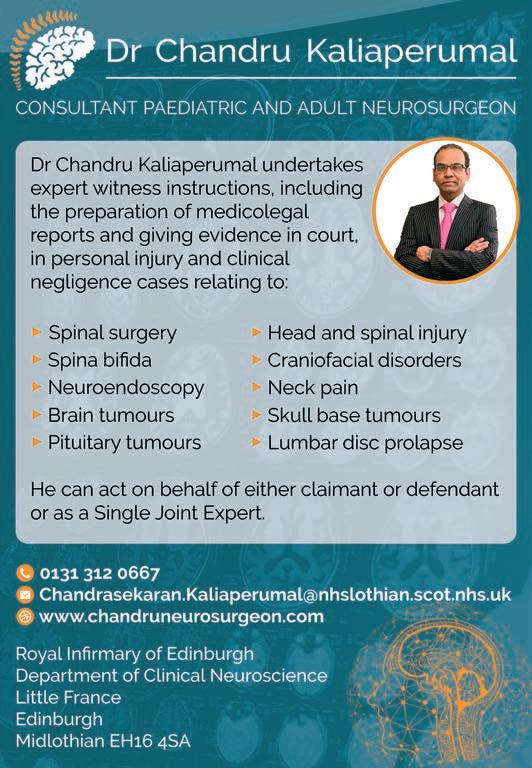
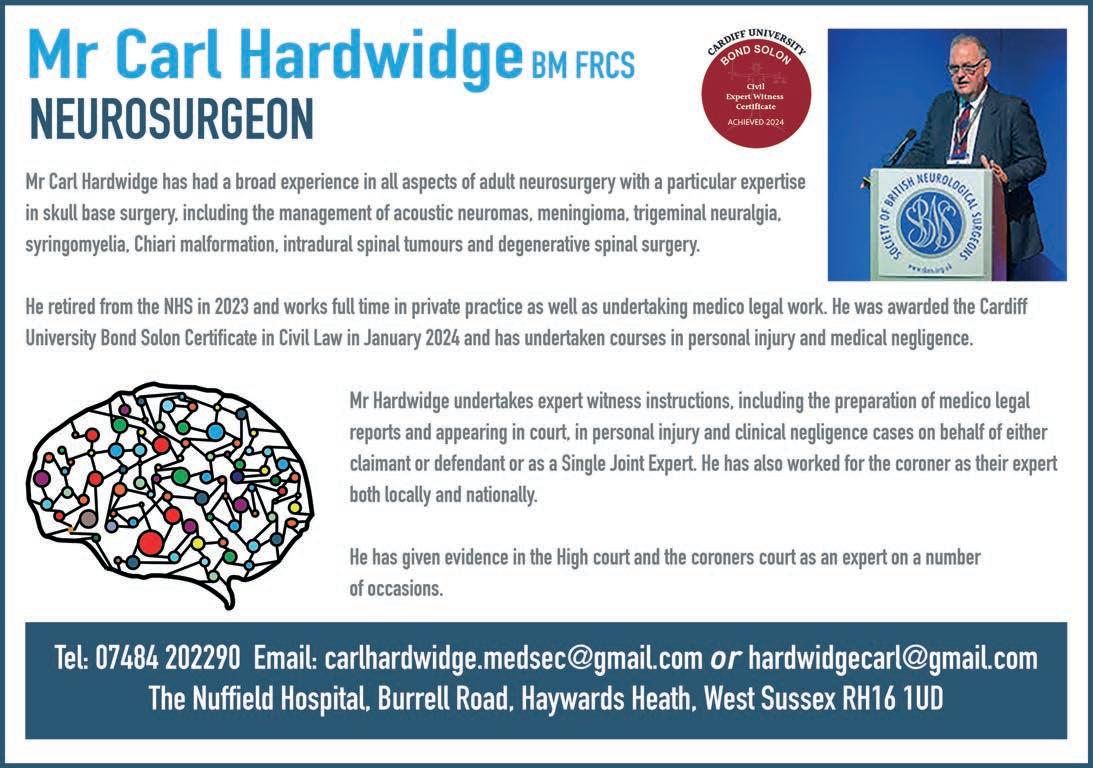
[IN JULY ITV News broadcast the story of Ian Huxley, a former soldier who completed four tours in the Middle East – ‘I’ve been suffering for 10 years’: Why are brain injuries still going undiagnosed in veterans? In the ensuing 10 years he has been suffering what is now known as blast-induced traumatic brain injury, or blast-TBI.
Senior news editor Paul Tyson wrote: “After two tours of Iraq and two of Afghanistan, he had trouble sleeping, was drinking heavily and was quick to anger. He felt depressed and reported intrusive thoughts and emotions.
“The diagnosis was post-traumatic stress disorder (PTSD), a psychiatric condition that can occur in response to distressing or threatening experiences and affects 9% of veterans of the ‘War on Terror’. But when Ian did not respond to normal treatments, he was discharged from the army into the care of the NHS.”
Ian had been experiencing intense symptoms for over a decade, but doctors
never suggested that it could be a traumatic brain injury.
“I get panic attacks, I freeze and get hot and cold sweats,” he told ITV News. “Even doing something like going to the shops, I need to see the exit all the time... if I can’t see it, I start flapping and freaking out and then the anxiety goes up and you get to the point like I’d rather not eat than do the shop.
“I get headaches, blurred vision, really severe headaches. I had one the other night and it wiped me out for five hours.
“I just had to be in a dark room on my own. Really, really intense and painful... I’m always ill as well, from lack of sleep, always ill.”
It was friends, not doctors, who suggested he might have blast-related mild traumatic brain injury, a condition where repeated exposure to blast causes cumulative damage to the brain, resulting in severe neurological problems.
ITV News reported that several weapon
systems used by the British Army appear to breach that threshold, meaning the soldiers who fire them are particularly at risk.
Responding to the story, chair of the British Psychological Society's Division of Neuropsychology Dr Ingram Wright said: “It is essential that those who have suffered with blast-induced traumatic brain injury (bTBI) are given comprehensive support as part of a multi-disciplinary approach, as effectively as possible.
“Clinical neuropsychologists assess and provide assessment of cognition as well as psychological symptoms such as traumatic stress, and provide a vital component of the rehabilitation approach.
“It is crucial therefore that those who suffer from bTBI are given neuropsychological support as standard at the earliest opportunity so that an accurate diagnosis of any difficulties can be made in the early stages of assessment.” q
[ BRAIN INJURY CHARITY HEADWAY has hailed rugby union international Garry Ringrose for what it describes as his ‘selfless’ withdrawal from a career-defining game for the British and Irish Lions against Australia.
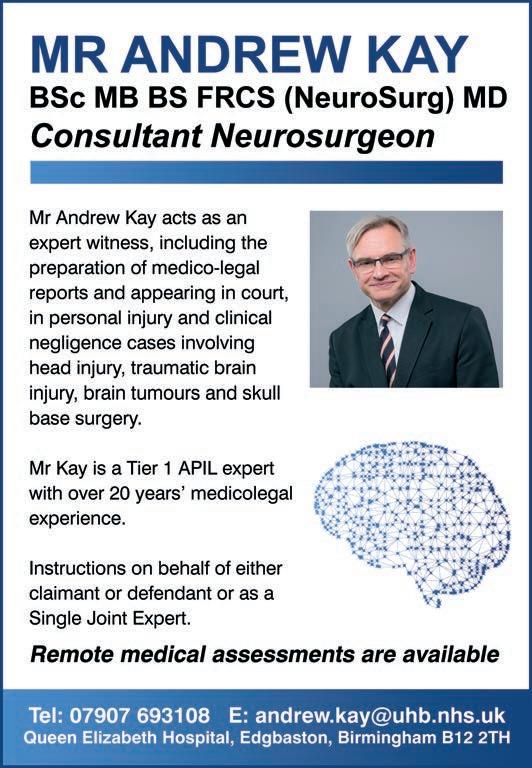
Having been named in the starting XV, Ringrose approached head coach Andy Farrell following a training session to report lingering symptoms from a concussion sustained earlier in the tour.
Headway stated: “Having achieved his goal of winning a coveted starting berth among intense competition, Ringrose’s decision has rightly been described as selfless. By flagging the on-going effects of his brain injury, he has put the team first by stepping aside – allowing a fully-fit teammate to take his place in one of the most highstakes matches of the tour.
“By recognising the risks of playing while concussed, Ringrose has rightly prioritised his own health. In doing so, he is also setting an incredible example to other sportspeople at all levels.”

The story highlights how difficult it is for medics to accurately assess players for concussion: both in the immediate aftermath of a collision and in terms of the lingering effects, which can last for months.
Luke Griggs, chief executive of Headway, commented: “Garry’s decision is incredibly brave. It’s also selfless and potentially transformative in the way sports people at all levels consider brain injury.
“It must have taken great courage to rule himself out of what would have been one of the biggest games of his career.
“In doing so, not only has he protected himself from a potentially much more serious brain injury, but he’s also set an incredible example for others.
“Looking after yourself and looking after your team are not mutually exclusive. No concussed player will be an effective teammate, and no game is more important than your long-term health.
“Garry deserves all the praise and support that comes his way. To see such a high-profile example of how far we have come with increased awareness of brain injury in sport is incredibly encouraging.” q
[IN ENGLAND, people with signs of cancer may receive an ‘urgent referral’ from their GP or from their screening results. It’s the first step on a pathway that should either diagnose or rule out cancer within 28 days. That is known as the Faster Diagnosis Standard (FDS) and the NHS aims to meet it for 75% of people.
NHS cancer waiting times data show that the FDS target has been met almost every month since the start of 2024. But it leaves out something important. It has not been known how performance against the FDS target differs for those who have cancer ruled out and those who are diagnosed.
A new FDS report, published by Cancer Research UK (CRUK) in partnership with NHS England’s National Disease Registration Service, reveals that while the NHS is ruling out cancer effectively, it’s not diagnosing it on time.
Between April and June 2024, only half (52.3%) of people who went on to be diagnosed with cancer after an urgent referral received their diagnosis in 28 days. That’s compared to 75.1% of people getting the ‘all clear’ in the same timeframe.
The data also suggests that things have been getting worse instead of better for people with cancer. The proportion of people diagnosed on time after an urgent referral actually fell four percentage points between 2021 and 2024.
In addition, data published by the NHS on 11 September shows little improvement in 2025. Between May to July this year, only 53.3% of people who received an urgent referral were told they have cancer on time.
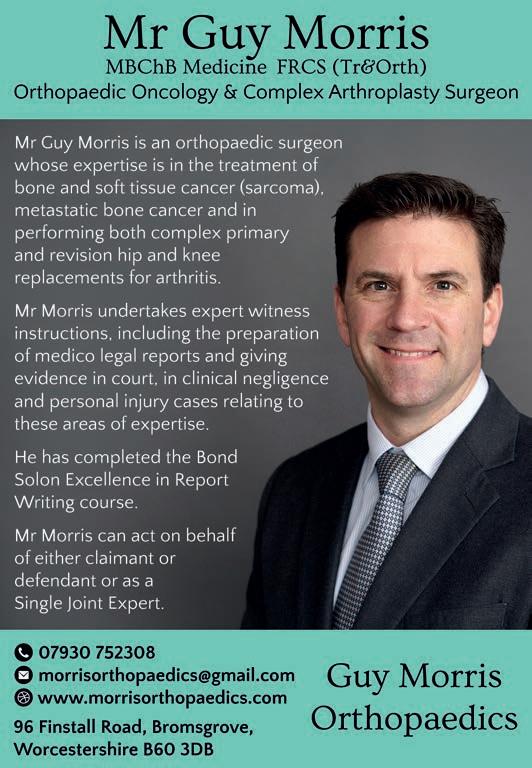

Delays to diagnosis are a key reason why so many cancer patients are waiting longer than they should to start their treatment. The FDS was introduced in October 2021 to support timelier diagnosis and prompt treatment, which can lead to better outcomes. The new breakdown of the data emphasises how important it is to consider people who are diagnosed with cancer separately from those who have cancer ruled out.
The good news is that the NHS in England is now beginning to report separate FDS performance breakdowns for those having cancer ruled out and those who are diagnosed. There are also plans to raise the overall FDS target to 80% by March 2026, taking it closer to the originally proposed target of 95%.
CRUK chief executive Michelle Mitchell commented: “The upcoming National Cancer Plan for England must include a new commitment to diagnose cancers earlier and a pledge to meet all cancer wait time targets by the end of this parliament, including the increased FDS target. This will require investment in specialist staff and equipment, coupled with reform. Without these actions, things could continue to get worse instead of better.”
The findings of the FDS analysis reflect the fact that diagnosing cancer can be more complicated than ruling it out. A single test might be enough to show that someone with cancer symptoms doesn’t have the disease, but saying for certain that someone has cancer may mean running a number of specialist checks to find and identify it. Each of those tests needs to be planned and conducted, and its results then need to be analysed and shared. Those steps can add up to push someone over the 28-day target.
The same complexities also help explain some of the differences in FDS performance for different cancer types. Testicular cancer referrals actually exceeded the overall FDS target between October 2021 and June 2024, with 83.2% of patients being diagnosed within 28 days. Skin cancer (74.7%) and breast cancer referrals (70.5%) saw the second and third highest proportion of people diagnosed on time.
Other cancer types are harder to diagnose, and they may require more investigations and tests. Urological cancer referrals, such as prostate and kidney, saw the lowest performance for getting people diagnosed within 28 days, at just 29%. Referrals for sarcomas (31.4%) and head and neck cancers (34.6%) were the second and third worst performers.
Over half of people diagnosed after a urological cancer referral between April and June 2024 (54.6%) waited more than 42 days for a diagnosis.
“Waiting for a cancer diagnosis can make every single day feel like forever,” said Michelle Mitchell. “It’s promising that more people are having cancer ruled out on time, helping to put their minds at ease. However, it’s unacceptable that only half of people who have cancer are being diagnosed within the target timeframe. The UK Government needs to act.” q
[ BECAUSE RENAL CONDITIONS
can develop quickly and have lifechanging consequences, courts often rely on nephrology experts to untangle whether poor outcomes stemmed from unavoidable progression or lapses in care when it comes to disputes involving kidney disease. Allegations typically relate to late or missed diagnosis, drug toxicity, dialysis complications or transplant rejection.
In primary and secondary care, failure to act on red-flag signs such as rising creatinine or declining renal function is a recurring theme. In those circumstances solicitors need independent opinion on whether accepted standards were followed

and whether earlier intervention might have changed the patient’s trajectory.
Specialists in nephrology are frequently
instructed to assess complex conditions such as acute kidney injury, sepsisrelated renal failure and hypertensioninduced damage. Their role extends beyond reviewing clinical records: they interpret intricate laboratory data, examine compliance with NICE guidance and provide authoritative views on causation and prognosis.
By explaining whether deterioration was preventable or inevitable, nephrology experts give solicitors the clarity required to build or defend a case. Their evidence often proves decisive in high-value claims where the stakes include both life expectancy and long-term quality of life. q
[IN AUGUST the UK Kidney Association (UKKA) joined MPs, patient organisations and health professionals in signing an open letter urging government and NHS leaders to strengthen the focus on chronic kidney disease (CKD) prevention within the Ten-Year Plan.
The letter was led by Dr Simon Opher MP, the chair of the All Party Parliamentary Group on Health, and raised concerns about the removal of CKD indicators from the Quality and Outcomes Framework (QOF). Signatories included UKKA presidents Dr Katie Vinen and Clare Morlidge, past UKKA leaders, patient charities and representatives from across the kidney community.
The letter emphasised the rising impact of kidney disease and its close links with cardiovascular health. It was addressed to Ashley Dalton MP, Under-Secretary of State for Public Health and Prevention, together with the National Director for Primary Care and Community Services, the National Clinical Director for CVD Prevention in England and the National Specialty Advisor for CVD Prevention at NHS England.
The letter reads in part: “As medical colleagues, you will know and appreciate the importance of this issue, with kidney disease set to
[ A NEWLY UPDATED VERSION of the Home Dialysis Utility Reimbursement Toolkit is now available to help support patients with the rising costs of home dialysis. It is the first update since 2022 and reflects the latest utility tariffs for April 2025 – March 2026, helping ensure patients are fairly reimbursed for additional electricity, water and sewage costs.
The toolkit includes:
• An updated reimbursement calculator with new pricing
• A patient assessment and agreement form
• A quick guide for using the calculator
• Practice recommendations outlining the responsibilities of NHS
• Trusts and Health Boards
The resource is produced by the Welsh Kidney Network, in collaboration with the UKKA, ANN UK and the Association of Renal Technologists. It is designed to support teams across England and Wales to apply reimbursement consistently and in line with the NHS England service specification for home dialysis.
A new formula for additional home dialysis devices is in development and will be included in future updates. q
become the fifth biggest cause of premature deaths globally by 2040. By 2033, CKD will be costing the NHS alone £10.3bn, and the total cost to the UK economy will hit £14bn annually – over 2.5% of this year’s total government expenditure. All of us feel strongly that this event and the discussion it facilitated cannot be simply left alone, and requires significant action.
“With this in mind, we are writing to you to raise significant concerns around the effective removal of chronic kidney disease from the Quality and Outcomes Framework for 2025-26. Research has shown financially incentivised care is a key enabler of effective CKD management. In 2015, annual albuminuria testing for patients with a CKD diagnosis was removed from QOF and annual testing fell from 80% in 2015/16 to 40% one year later, and it has only recently reached 49%.
“The recent retirement of CKD005 indicator further removes incentive for practices to monitor chronic kidney disease. We must be encouraging primary care to monitor more closely for early signs of kidney disease and carefully manage diagnosed patients.”
The signatories ask for the inclusion CKD identification and management within future primary care incentivisation schemes and for the government to consider the kidney community’s unified call for the development of a CKD Modern Service Framework.
“The Ten-Year Plan, in which many of us were involved, outlines several key shifts and detailed proposals for improving healthcare. Our suggestions would support the plan by shifting focus towards prevention, enabling it to demonstrate some key early successes. We are also aware that the WHO has adopted CKD as a priority, in a motion supported by the UK government. We welcome this move, and believe that our proposals would help ensure that we are fulfilling these obligations.” q



[ THE GENERAL DENTAL COUNCIL
(GDC) has published new research exploring how remediation could be used earlier in the fitness to practise (FtP) process.
Reporting the results, the GDC said: “We have been exploring remediation as an approach to addressing potential FtP issues before a case is referred to case examiners, to support learning, improve patient safety and reduce the negative impacts of lengthy investigations on dental professionals.”
The study, conducted by a collaborative research team from the University of Manchester, Newcastle University, the University of Nottingham and Queen Mary University of London, found that there was broad support for tailored and targeted remediation as part of the FtP process – but acknowledged that there may be varying views on the acceptability of remediation as an outcome of an investigation.
The research was conducted to understand views, approaches and potential obstacles to remediation in healthcare regulation and to inform thinking on how the GDC might
manage less serious public safety and confidence risks more effectively and earlier in the process.
Currently, only a small proportion of cases raised are so serious that they require sanctions or restrictions on registration. In most cases, there could be opportunities for earlier interventions focused on remediation, empathy and learning, through which the punitive effect of the FtP process could be reduced.
There was a common view that remediation could support improvements in patient safety and the quality of care. It was widely accepted that some issues were so serious that they were irremediable.
Stefan Czerniawski. executive director of strategy at the GDC, said: "We know that fitness to practise investigations can be long drawn out and feel overly complex in relation to the issues raised, often leading to feelings of mistrust in and fear of the process among registrants. We need to think differently if we want that to change.
“We’re using these research findings to inform our thinking on whether early evidence
of remediation can play a greater role in the fitness to practise process and lead to more proportionate outcomes in some cases.”
The researchers identified the adversarial nature of the process and lack of trust in the regulator as two of the key barriers to effective implementation of remediation. Addressing those issues would require a greater risk tolerance and the creation of a more supportive regulatory environment that encouraged registrants to remediate early. Consideration will also need to be given to whether changes to legislation would be needed to make the most effective use of remediation in the resolution of FtP cases.
The findings highlighted the need for the regulator to develop clear guidance, and for remediation to be specific to any deficiencies identified to be effective and meaningful.
As set out in the proposed Corporate Strategy for 2026-2028, the GDC is aiming to shift towards a more prevention-focused regulatory model that protects the public and prioritises learning and development to mitigate risk. q
[THE UK’S REPRESENTATIVE BODY for dental professional, the British Dental Association (BDA), has applauded the proposed ban on sales of high-caffeine energy drinks to under-16s in England. Retailers online and off are set to be prohibited from selling energy drinks containing more than 150mg of caffeine per litre to anyone under 16. That means drinks such as Red Bull, Monster, Relentless and Prime Energy will be covered, and it will force their industry to reformulate their products.
There is real scope for gains in oral health, the BDA says, given the high sugar content in many of those products; and even the zero/low sugar versions have an erosive impact on teeth due to high levels of acidity.
“Products that are habit forming, highly acidic and can contain over 20 teaspoons of sugar have no place on the menu for children,” says BDA chair Eddie Crouch. “Our kids are growing up in a toxic food environment, and this boldness needs to be applied across the piece.”
According to the BDA: “We have pressed for change for years, but we feel government should go further and faster – and tens of thousands of you have already backed the call. The time has come to tackle the catastrophic impact of unhealthy food and drink on children’s health, with mandatory guidelines for industry and expansion of the sugar levy.”
On 3 September the government launched an open consultation on the subject, which closes on 26 November. In its introduction to the consultation the Department of Health and Social Care said: “Data suggests that large numbers of UK children regularly consume high-caffeine energy drinks. There is research reporting that up to one third of UK children aged 13 to 16 years, and nearly a quarter of those aged 11 to 12 years, consumed one or more high-caffeine energy drinks each week between 2013 and 2018.
“Of children aged 11 to 15 years surveyed in 2018 in England, 9% reported consuming high-caffeine energy drinks between two and four times a week, which translates to over 250,000 children.
“More recent data from a 2022 survey of children aged 11 to 15 years in England reported that 4% of children consumed one or more high-caffeine energy drink each day, estimated to reflect over 100,000 children consuming these at least daily.” q



[I AM an independent occupational therapist and have worked with children and young people for more than 26 years. My clients have a range of needs, including autism, ADHD, developmental co-ordination disorder, early attachment and trauma, challenging behaviour, developmental delay, learning difficulties, pathological demand avoidance, complex needs, mental health issues and difficulties with motor skills, handwriting, functional tasks and sensory processing. I provide services to local schools and colleges and receive requests for independent assessments.
I am an approved practitioner in sensory integration, which is a specialist approach used for assessment and therapy. An assessment explores motor skills, how a child/young person responds to sensory input – from outside and inside the body – and how that affects function. Sensory processing is important for co-ordination, balance, feeling safe and secure, and regulation: ie adapting to situations, coping with demands and managing emotions. Difficulties affect the development of skills, daily living skills, learning, tolerance of situations, emotional wellbeing, confidence and concentration.
Occupational therapy is key to a child’s EHC plan. As an occupational therapist I work with children and young people, their families and schools to improve function and increase independence at home, at school and in the community. I assess clients in the environment where they are most comfortable, whether that is at home or in an educational placement. Recommendations may include the provision of equipment, changing the approach to tasks or routines, adapting the classroom, occupational therapy programmes and sensory diets. An accurate description of a child or young person’s needs is necessary to inform the support and provision in an EHC plan.
How does an expert occupational therapist add value?
I prepare expert reports for special educational needs tribunals. I trained with Bond Solon and have an expert witness certificate from Cardiff University. I have extensive experience of issues related to special educational needs and EHC plans: ie refusal to issue, description of need, inadequate support, inappropriate provision or placement. My recommendations are based on a comprehensive assessment and include information from the family and carers and the current and/or proposed provision. Where possible I include the child or young person’s perception of their difficulties. My conversations with children are supported by alternative methods of communication, such as pictures, gestures or symbols.
I really enjoy expert work and have faced many challenges. I need to build a rapport with a child or young person in a very short period of time to complete the assessment. It is important to understand the needs of their family and carers and how that has an impact. Some need additional support to understand a child or young person and to help them function on a daily basis, particularly if needs are complex.
Challenging an EHC plan is a long process, so emotions can be high. Children and young people can be ‘dysregulated’ for a number of reasons: the assessment is a new experience or they have struggled without adequate support. Some are wary, anxious and reluctant to communicate or engage in the assessment. I work hard to build a rapport with them, adapt the assessment if needed and reduce demands as much as possible.
It is important to explain my skills and how the report informs the EHC plan and tribunal process. My reports are impartial, adhere to the facts and comply with practice directions. They are comprehensive but use little jargon, so they are easy to follow. I recognise the limitations of an assessment and when skills are outside my area of expertise. q

[REPRESENTATIVES from the Chartered Society of Physiotherapy (CSP) joined a packed Health Equals parliamentary reception in July to highlight the role of physiotherapy and community rehabilitation in closing the UK’s health inequality gap.
The reception, which had the theme Making Equal Health a Reality, brought together MPs, campaigners and healthcare organisations to explore how social and economic factors such as housing, poverty and employment shape health outcomes.
CSP’s Helen Sharma and Natasha Owusu attended to promote the #RightToRehab campaign, talk about the importance of physio-
led community services and urge MPs to support the Community Rehabilitation Alliance’s call for every Integrated Care Board to have a rehab strategy and director-level leadership.
Ashley Dalton MP praised the government’s 10-year plan for its focus on social determinants of health, while activist Darren McGarvey delivered a powerful account of growing up without access to the building blocks of health.
The CSP spoke to several MPs, including Afzal Khan MP and Shockat Adam MP, who both expressed interest in becoming rehab champions and visiting physiotherapy services in their constituencies.
Discussions focused on the impact of
physiotherapy in neighbourhood health services, the risks of graduate recruitment freezes and the need to tackle postcode lottery access to rehab.
CSP assistant director Sara Hazzard said: ‘We’re proud to stand alongside MPs and the Health Equals coalition of over 80 organisations. Together, we’re shining a spotlight on the vital role of physiotherapy and rehabilitation in tackling the social causes of ill health and narrowing the healthy life expectancy gap.
“As long as community rehabilitation is unavailable in certain areas, then the system is neither comprehensive nor universal. This fuels health inequalities.” q
[THE Chartered Society of Physiotherapy has told MPs that physiotherapy must be at the heart of plans to boost physical activity and healthy ageing, in evidence submitted to the Health and Social Care Select Committee’s healthy ageing inquiry. The inquiry is examining how physical activity can prevent and reduce ill health in later life, and how increasing activity levels could help close the gap in healthy life expectancy between the most and least deprived communities.
The CSP’s submission to the inquiry highlights the central role physiotherapists and physiotherapy support workers play preventing illness, supporting recovery and reducing demand on overstretched NHS services. It calls for urgent investment in physiotherapy services and workforce expansion, highlighting how improved access could help close the healthy life expectancy gap between richer and poorer communities.
The key recommendations to MPs are:
• Make physiotherapy advice available early for people with long-term conditions, through primary care and neighbourhood teams.
• Expand community rehabilitation by using record physiotherapy graduate numbers and growing rehabilitation support worker roles.
• Reform primary care funding and develop integrated neighbourhood health services to address gaps between GP surgeries and community health teams.
• Full rollout of 5,000 first contact physiotherapists in primary care to provide rapid access to expert assessment and self-management advice.
• Investment in fracture prevention services, such as fracture liaison services, to reduce avoidable hospitalisations and maintain independence.
• Cross-sector partnerships between NHS, social care, local government, voluntary organisations and leisure and well-being sectors to integrate physical activity into care pathways.

The CSP also urged MPs to tackle the postcode lottery in rehab services, integrate physiotherapy into social care and leisure settings, and roll out proven innovations such as MSK hubs and Prehab4Cancer.
Rachel Newton, head of policy at the CSP, said: “We have the workforce, the evidence and the innovation to make a huge difference to older people’s health and independence. What’s needed now is investment and the political will to make it happen.”
The committee will hear oral evidence in the coming months before publishing its findings. The CSP will continue to engage MPs and decision-makers to ensure physiotherapy is recognised as central to healthy ageing policy. q

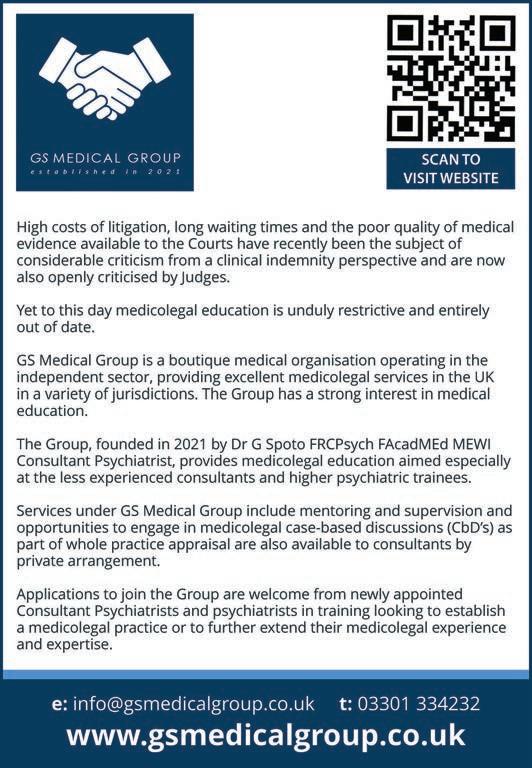
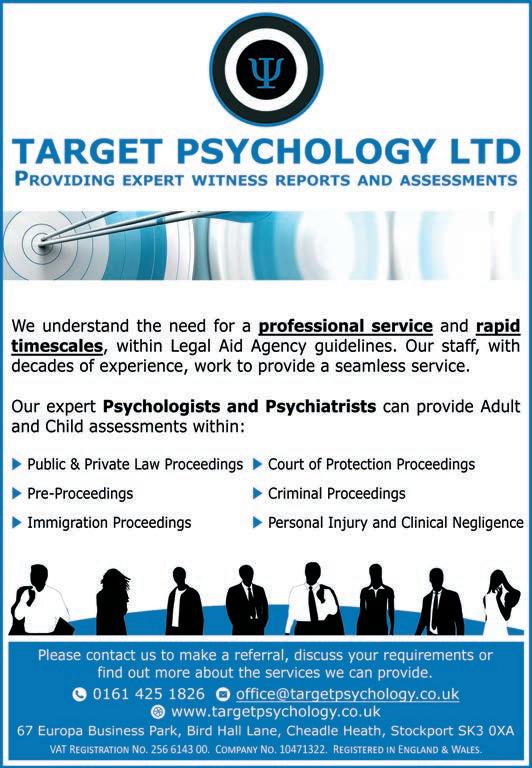


By Dr Priscilla Kent, consultant psychiatrist
[ A DEPRESSIVE EPISODE is often accompanied by signs such as constant low mood, a loss of interest in daily activities and a loss of pleasure in things which the patient previously enjoyed. Many patients experience anger, which may cause issues at work or in close relationships.
Cognitive difficulties, including poor concentration and poor memory, are also commonly reported. The likelihood of these may be increased by the sleep disturbances that are characteristic of depression. Depression is extremely common, occurring in around 6% of the population at any one time and around one in four people will experience at least one depressive episode during their lifetime.
Serious injury can be life-changing: it can lead to chronic pain, disability and psychological stress. If immediate or appropriate treatment is not received, this will increase the emotional impact. Furthermore, the inability to work, even in the short term, can result in financial hardship. All of these may lead to the patient developing depression. Therefore, a claim for compensation for depression often forms part of litigation for personal injury.
Depression is a recognised consequence of traumatic injury and high prevalence rates have been observed in patients who have experienced a traumatic event.
For most patients, the symptoms of depression are mild, but moderate to severe symptoms are reported by up to 45% of patients and can sometimes last for years after the initial injury. Interestingly, depression scores tend to remain stable, whereas symptoms such as pain decrease over time. This suggests that depression is not directly caused by the injury and its consequences, but may also be due to pre-existing vulnerabilities, such as a tendency to process negative experiences differently.

physical health may be useful in predicting the likelihood of disability. Chronic pain is a particularly important factor, as it is associated with many of the risk factors for depression, including sleep disturbances, poor quality diet, decreased physical activity and obesity.
There is no physical test to diagnose depression. Instead, it is identified by questioning a patient about how they are feeling and how this is impacting on their daily life, work and social relationships. Thoughts of suicide or self-harm are particularly indicative of depression. As the onset of the condition is often gradual, it can sometimes be difficult to notice changes in mood, behaviour or physical symptoms until these are very severe. Often it is a family member or friend who first suspects there is a problem. Not surprisingly, many cases remain undiagnosed.

The likelihood of developing depression is partly dependent on the seriousness of the injury. However, there is also some evidence that it is linked to the type of injury. Patients injured following a traffic accident are 1.72 times more likely to subsequently report depressive symptoms than the general population. However, in those with non-traffic-related injuries, the risk is more than doubled. Burn injuries and those sustained during interpersonal violence carry the highest risk, probably due to the increased trauma surrounding such events.
Although many people gradually recover from the feelings of shock, denial, anger, sadness or guilt that are commonly associated with traumatic experiences and their consequences, in others these feelings persist and may over time develop into depression. Some people find it very hard to adapt to their new circumstances, particularly after suffering a life-changing injury such as an amputation.
Depression has been associated with reduced physical functioning and a decline in physical health over time. A worse quality of life, an increased risk of disability and a decreased likelihood of returning to work have all been linked to the condition, even when symptoms are relatively mild. It can also interact with symptoms such as pain, anxiety and post-traumatic stress disorder.
These relationships appear to be bidirectional, with each heightening the effect of the others and giving rise to worse outcomes than for each symptom in isolation. Therefore, the interaction between mental and
Depression is frequently a recurrent illness, so many patients will have had previous episodes. Furthermore, it is not always caused by a single identifiable event. It is a complex condition, and many factors can contribute to its development. This can complicate personal injury claims that include depression, as it can be difficult to determine if the patient would have developed the depressive episode even in the absence of the index injury.
Even in patients with a prolonged history of depression, it could be argued that the trauma suffered when they were injured has exacerbated their condition, and proving or disproving this is challenging.
The picture is complicated further by the relationship between depression and injury. It is now known that pre-existing depression can be a risk factor for accidents and injuries. In particular, the sleep disruption associated with depression has been shown to increase the risk of road traffic accidents and occupational injuries. This is likely due to the inattention, decrease in vigilance and slowed reaction times caused by insomnia, particularly if it is chronic.
Pre-existing depression is twice as likely to be reported in individuals taking time off work due to injury or non-mental health related illness compared to colleagues who remain at work. Therefore, determining the level of compensation due in personal injury claims where depression is also cited is extremely difficult. q
• Dr Priscilla Kent is a consultant psychiatrist, currently providing clinical lead to a busy community mental health team in South Hackney, London. She became a member of the Royal College of Psychiatrists in 2000 and has been a substantive NHS Consultant Psychiatrist since 2013.
In her current role Dr Kent assesses new patient referrals and provides follow up with patients with severe mental illness, including patients on restriction orders and community treatment orders. She also works alongside inpatient colleagues to provide continuing care, including home visits, outpatient appointments and online assessments. She is available for remote consultations and face-toface appointments in London.
Find out more at https://www.medicolegal-partners.com/our-experts/ dr-priscilla-kent/ and contact info@medicolegal-partners.com to discuss a case or to instruct Dr Kent

By Zofia Ludwig, director at Expert in Mind
[ AUTISM isn’t something people grow out of; thousands of adults across the UK live with undiagnosed or misunderstood autism, often navigating personal, professional and legal challenges without the support they truly need.
At Expert in Mind, we work closely with professionals across health, social care and legal fields. One thing has become increasingly clear, understanding how autism presents in adulthood is not only a specialist topic, but it is essential knowledge for anyone working with people.
While current estimates suggest that around 1% of UK adults meet the criteria for Autism Spectrum Disorder (ASD), the true figure is likely higher. That is particularly the case among women and people from minority backgrounds, where autism may present differently or be masked by well-practised coping strategies.
This gap in recognition and support was the driving force behind our recent webinar, Autism in Adulthood: Diagnosis, Treatment and Life Impact. The session was delivered by consultant psychiatrists, Dr Sajid Suleman (right) and Dr Ajay Bhatnagar (below right), and attended by hundreds of professionals across the UK. Rather than simply raising awareness, the aim was to give attendees practical insight into how autism appears in adults and how they can best provide support.
One of the core messages was that autism in adulthood often looks very different to people’s expectations. Many autistic adults appear outwardly capable; they might maintain relationships, hold down employment or communicate well; however, behind that, they may be experiencing anxiety, sensory overload or significant fatigue caused by the constant effort of masking autistic traits to fit in.
and assumptions, can have a profound impact on how well supported a person feels.
Communication plays a crucial role. Autistic adults may interpret language literally, struggle with metaphor or sarcasm, and need more time to process spoken information. In clinical, legal and workplace settings, using clear, direct language, avoiding ambiguity and offering written or visual explanations can significantly improve outcomes.
Autistic adults are at increased risk of involvement in criminal or civil proceedings. This is not because of intent, but due to misunderstood behaviours. These may include public outbursts caused by sensory overwhelm, obsessive interests that unintentionally cross boundaries, or inflexible thinking that leads to unwise decisions. Without proper awareness, these individuals can be misrepresented or unsupported.

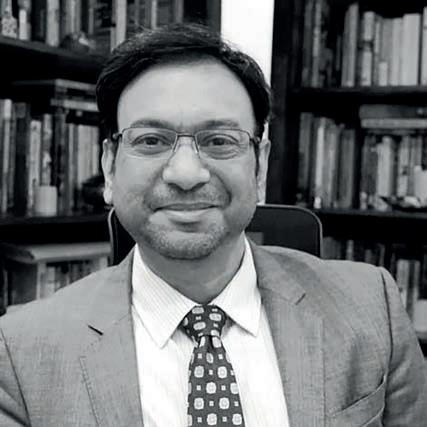
This masking is especially common among women and, as a result, a diagnosis is more likely to be missed earlier in life. Later, their difficulties are often misattributed: instead of recognising autism, professionals may diagnose anxiety, depression, personality disorder or obsessivecompulsive traits. While these may genuinely be present, the underlying cause is often overlooked.
Getting the diagnosis right is important. For many adults, it offers long-overdue clarity and can change the course of their mental health journey. But diagnosis is only one part of the picture. The way professionals respond, through communication, environment
It is vital that professionals understand how autism can shape a person’s experience of the world. That means looking beyond surface-level impressions, asking the right questions and recognising when someone might be masking. It also means knowing when to revisit a diagnosis, especially if treatment plans aren’t effective or do not fully explain the person’s presentation.
At Expert in Mind, we believe that education is the first step towards more inclusive and effective care. Our webinar is one example of how we support professionals with the insight they need to make informed, compassionate decisions. The session covered diagnostic criteria, communication strategies, co-occurring conditions, practical adjustments and real-life case examples that brought the challenges and solutions to life.
As understanding of autism continues to grow, so too does the opportunity to improve outcomes for autistic adults. But awareness alone is not enough, it must be matched by informed assessment, appropriate support and systems that adapt to meet people’s real needs, no matter when in life a diagnosis is made.
For those unable to attend any of Expert in Mind’s webinars live, full recordings are available on demand – and this is a session not to be missed. q
• To access the Autism in Adulthood webinar and explore further webinars, please visit Expert in Mind’s webinars page at expertinmind.co.uk/webinars-page/
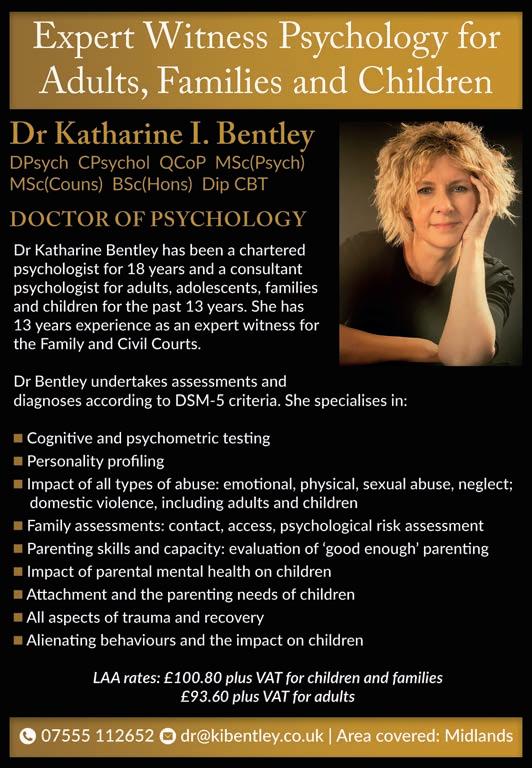

[THE BRITISH PSYCHOLOGICAL SOCIETY (BPS) has called for the next Scottish Government to take ‘bold and decisive’ steps to address the nation’s mental health emergency, as part of a coalition of 17 leading organisations. On 15 September Scotland’s Mental Health Partnership launched its manifesto ahead of the Scottish election in May 2026. It believes decisive action is also needed to transform the country’s mental health services in the future amid rising demand.
The partnership is calling for a substantial increase in investment in mental health to boost resources for early intervention and prevention, together with a choice of support, care and treatment in the right place and at the right time for all, and an ambitious public health programme to improve mental health literacy that will tackle stigma and discrimination.
Yana Yaneva, chair of BPS’s Scottish Branch, said: “Mental health is poorer than it was before the COVID pandemic, and stigma and discrimination are still rife within society. With ever-increasing demand on already overstretched services, we need decisive action to ensure a workforce fit for the future, so everyone can access the right services when they need them.”
The BPS believes psychology is central to the solution to ensure equitable access for all. In its own manifesto for the Scottish Parliament election next year, published in June, the society called for psychology to be at the heart of policy making, saying it provides the insight needed to develop policies and design public services that are ‘genuinely inclusive, effective and person-centred’.
“Psychologists have the skills needed to help individuals and the wider population to improve their health and wellbeing,” Yana Yaneva added. “They take a holistic approach, considering all factors that can impact a person’s health, such as employment and housing.” q

[THE Royal College of Psychiatrists (RCPsych) has estimated that between 56,000 and 85,000 mothers across England may have experienced postnatal depression last year. That accounts for between 10-15% of those who gave birth.
Maternal suicide remains one of the leading causes of death among women between six weeks and a year after birth. Perinatal mental illness can significantly impact women’s health and accounts for 34% of all deaths in the group during that period.
Untreated prenatal mental illness also affects unborn infants, potentially putting them at risk of premature birth and low birth weight. Parents may find it difficult to bond with their baby once they are born and that can contribute to attachment issues.
Mothers and their partners must not be left to suffer in silence and should instead be supported to seek help from those around them as well as perinatal mental health services when necessary, the RCPsych says. The conditions are eminently treatable and an approach that takes into account a person’s biological needs, psychological state and social situation is most effective.
Dr Trudi Seneviratne OBE, consultant perinatal psychiatrist and immediate past RCPsych Registrar, said: “Women can experience an enormous amount of change, including increased stress factors, when they become pregnant, and this may negatively affect their mental health. Postnatal depression is far more common than many
people realise and can have a devastating impact on mothers, babies and families if left untreated.
“Mothers who receive talking therapy and other forms of care from mental health services will often be able to recover; but some might be so unwell that they need medication, including antidepressants. Medication helps save lives. The dangers of untreated depression far outweigh the risks of antidepressants. The unnecessary deaths of mothers and sometimes their babies that result from failure to treat these conditions are truly devastating.
“Doctors are trained to ensure that the medication they prescribe is as safe as possible to take while pregnant or breastfeeding. Medication should be reviewed regularly, and any side effects closely monitored.
“For children to thrive they need as good a start in life as possible, and this is important not only for the child and their mother but also communities and society as well. We all have a role to play in ensuring mothers and their partners feel confident seeking support when they need it.”
The RCPsych advises all those thinking of stopping their antidepressants to talk to their doctor first, as those medications should not be stopped abruptly. The RCPsych has produced a resource for anyone who wants more information about stopping antidepressants. q
By Dr Timothy Brow , Consultant Psychiatrist
[AS A GENERAL ADULT PSYCHIATRIST with a Special Interest in Forensic Psychiatry I have assessed many patients with previously undiagnosed comorbid heterogeneous presentations of autism spectrum disorder (ASD) and/or adult attention deficit hyperactivity disorder (ADHD), as both a clinician and an expert witness.
Exploration of genuine developmental disorders is crucial at medicolegal assessments because those conditions frequently impact upon both criminal and civil matters.
Recent studies suggest that 50-70% of individuals diagnosed with ASD may also suffer from ADHD and vice versa. That heterogeneity reflects the neuroatypical concept of brain development expressed in the typical ‘spiky’ cognitive profile sometimes evidenced by profound cognitive abilities, in the absence of basic social skills or any understanding of societal expectations.
Problems in accessing diagnosis, treatment and follow up for ASD and/or ADHD during childhood often culminate in crises in adulthood. Failures in early detection and intervention may result in truancy, conduct disorder, victimisation, poor academic attainment and a negative societal trajectory. Both ADHD and ASD can have an impact on executive functioning, causing resistance to change and problems with timing, organisation and planning. Those challenges are often compounded by the specific learning difficulties dyslexia, dyscalculia and dyspraxia, which are associated with ASD and ADHD.
Common ASD traits of inappropriate social interaction or social disinhibition (such as uncoordinated eye contact, unusual facial expressions, touching, sniffing and an inability to interpret the body language and facial expressions of others) may incite bullying, damaging confidence and self-esteem and causing anger management issues. The risk of mental disorders (including psychosis), sleep disorders and illicit substance misuse is increased in individuals with ASD/ADHD. Traits of suggestibility and impulsivity – particularly when compounded by substance misuse – increase the risk of offending.
ASD and ADHD may contribute to offences against the person, including sexual and stalking offences due to deficits in ‘theory of mind’ (the ability to understand the intentions, thoughts, feelings and wishes of others).
As defendants, individuals diagnosed with ASD/ADHD may present as lacking in remorse owing to social emotional reciprocity deficits, possibly triggering negative jury bias, fitness to plead may prove contentious. As vulnerable adults, individuals with ASD and ADHD must be offered appropriate advocacy support during both civil and criminal proceedings.
While early intervention may reduce the risk of offending in certain vulnerable individuals, for those identified at a later stage who find themselves caught up in the criminal justice system, developments in pharmaco-therapeutic intervention offers hope for improved trajectories. q
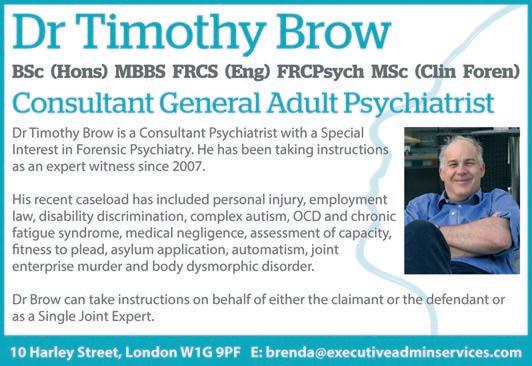
By Lisa Crowther of Carter Brown

[ INSTRUCTING THE RIGHT EXPERT can make – or break – a case. But what happens when that trusted expert, whose reports once impressed, no longer meets today’s legal or professional standards? It may be time to ask the uncomfortable question: has your expert reached their expiry date?
Over time, the demands placed on expert witnesses have grown significantly. Courts now expect more than credentials and experience. Experts must demonstrate a clear understanding of their duty to the

court, understand relevant guidance, produce reports that are wellstructured and impartial, and remain resilient under cross-examination. An expert whose knowledge is outdated, who lacks credibility, or whose reports are poorly drafted can become a liability rather than an asset, jeopardising the timely and just conclusion of proceedings.
Solicitors should be alert to red flags. Is the expert slow to respond, vague in communication, or reliant on outdated references? Do their reports contain jargon-heavy language or stray into advocacy? If so, they may struggle to withstand the scrutiny of judges and opposing counsel. They may also be failing to understand their independent role. The role of the expert is not to support a client’s case, but to assist the court. Any perception of bias – or even incompetence – can seriously undermine your case.
Without doubt, the landscape of expert evidence is evolving. New technologies, changing standards and updated case law all demand that experts stay up to date in terms of their field of expertise and the legal expectations placed upon them. CPD, peer review and experience of giving evidence should be regular features of an expert’s professional life – not distant memories.
While long-standing relationships with experts can bring comfort and familiarity, they should not blind solicitors to declining performance. The robustness of an expert’s evidence can have a significant influence on decision-making for children, families and individuals. If an expert is not up to the task, it is them who are most likely to experience the deleterious impact of this. .
The solution? Regularly review your preferred experts and providers. Assess performance post-case, seek feedback from those involved – professionals and lay parties – and consider fresh options where needed. Ensure that you complete your own due diligence when using experts new to you; up to date registration and compliance with the varying requirements of professional and regulatory bodies should be carefully checked. Experts should be committed to meeting safeguarding requirements – in terms of insurance, ICO membership and DBS checks – alongside operating comfortably within their areas of expertise.
Continuing to instruct an expert who falls short of the court’s expectations may amount to a failure in your duty to the client and the administration of justice.
In March 2025, the Ministry of Justice’s consultation in relation to the wording of Practice Direction 25 in family proceedings places a strong emphasis on instructing experts who are fit for purpose. The consequences of failing to do so are not theoretical – they play out in real lives, with real and lasting impact. q
ACCIDENT & EMERGENCY MEDICINE

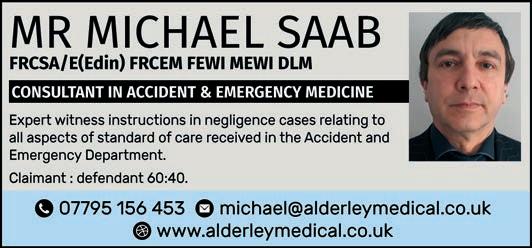

CARDIOLOGISTS & CARDIOTHORACIC SURGEONS
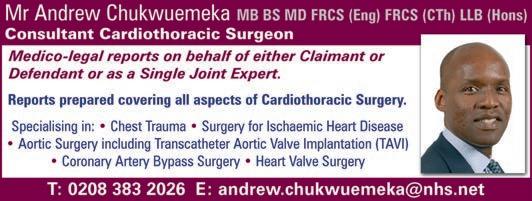


DENTAL & ORTHODONTIC EXPERTS

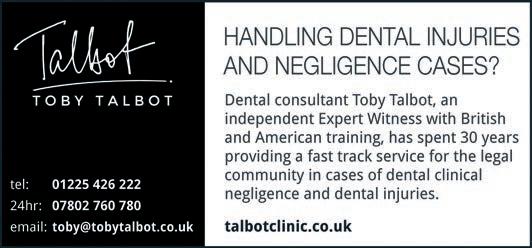

ENDOCRINOLOGY

ENT CONSULTANTS
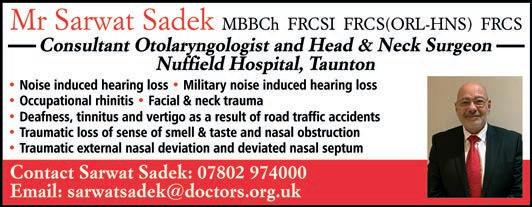




GASTROINTESTINAL & COLORECTAL SURGEONS

GENERAL SURGEONS




HAEMATOLOGY
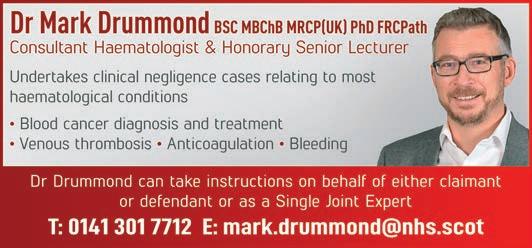

MEDICAL NEGLIGENCE
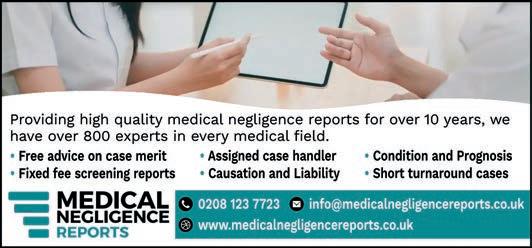

NEUROLOGY


NEUROSURGEONS



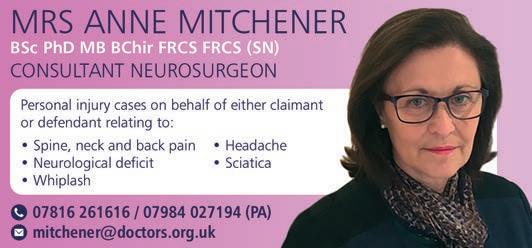


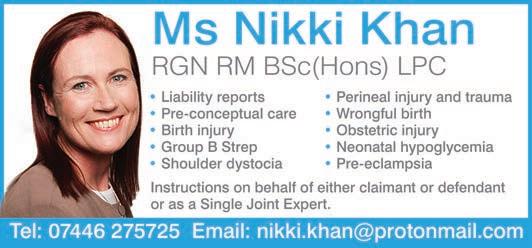
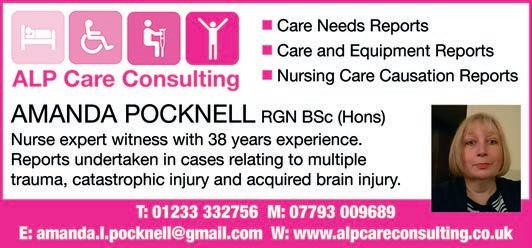
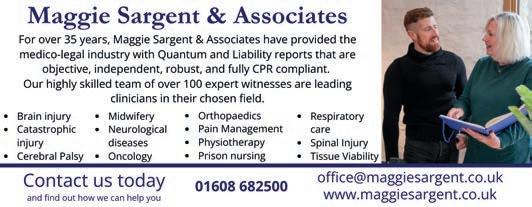





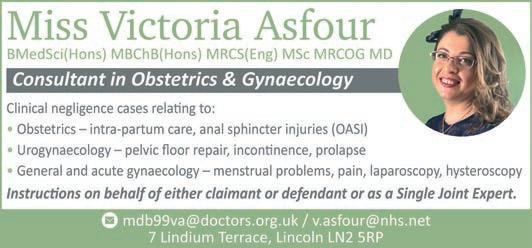
OCCUPATIONAL MEDICINE & THERAPY
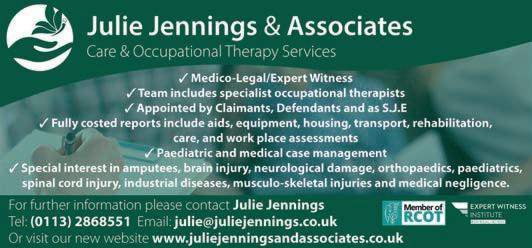
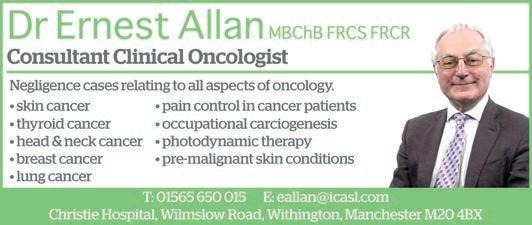
OPHTHALMIC SURGEONS
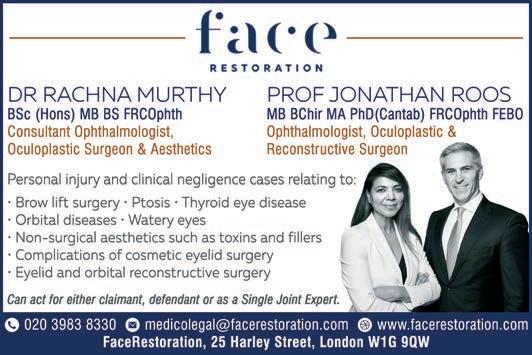


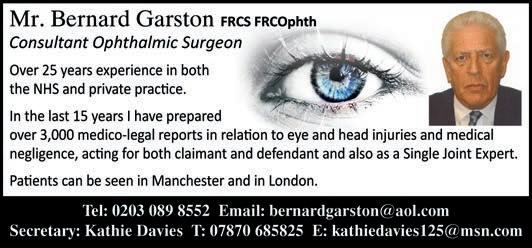

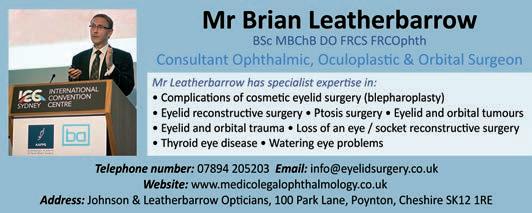



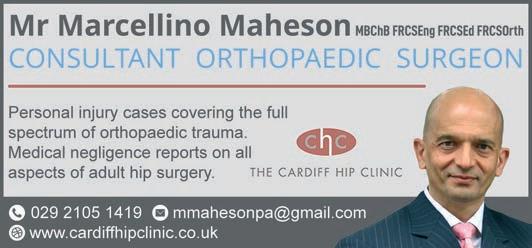
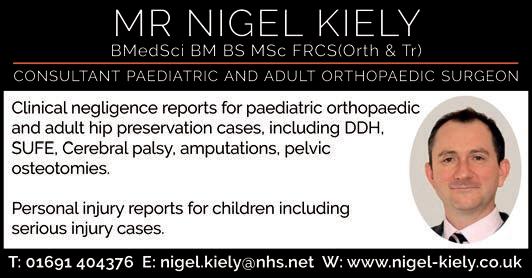

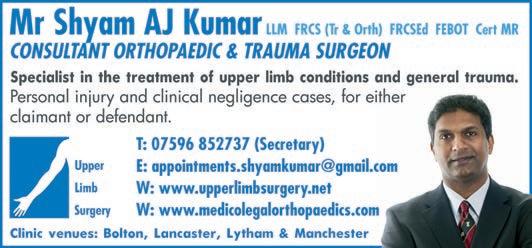
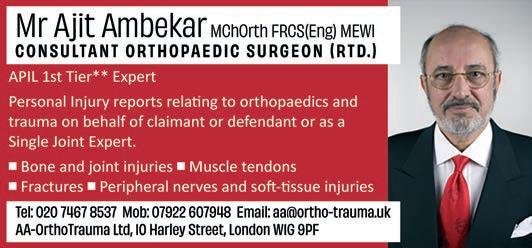





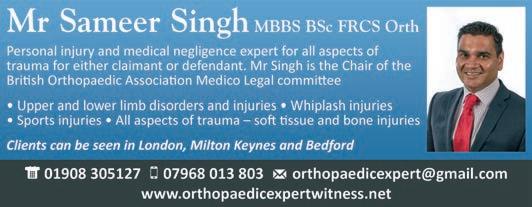




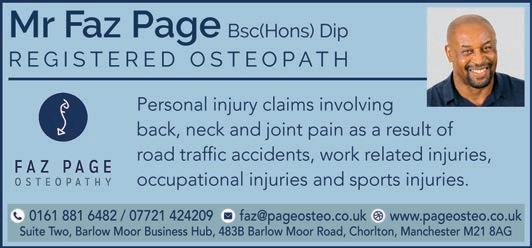

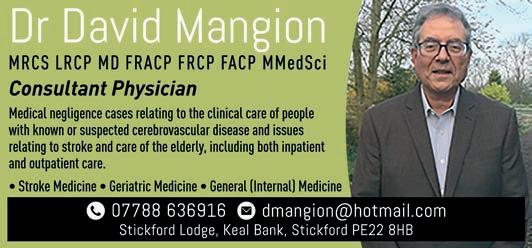




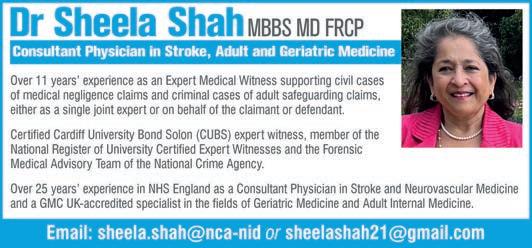

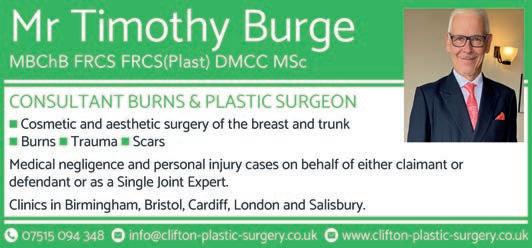
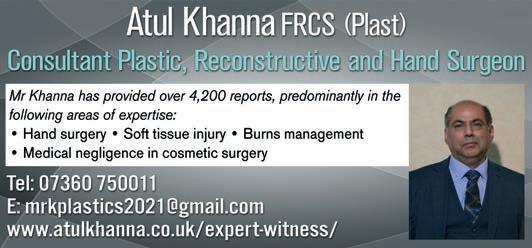





PSYCHOLOGISTS




RADIOLOGISTS
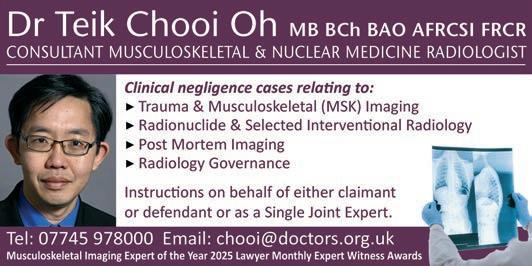

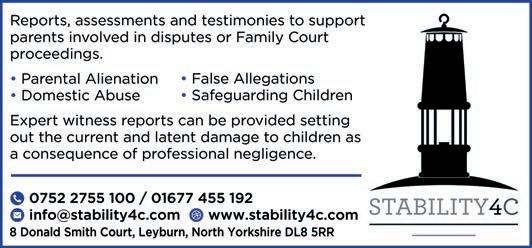

SPEECH & LANGUAGE THERAPY



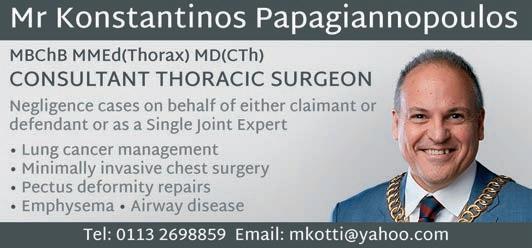
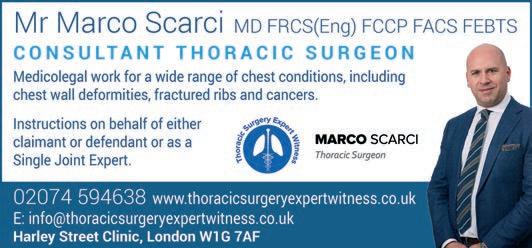

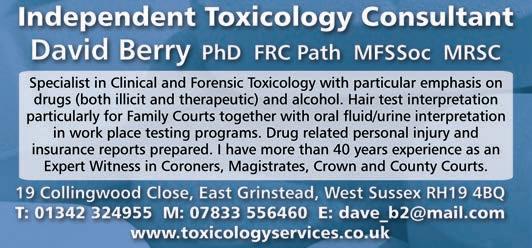



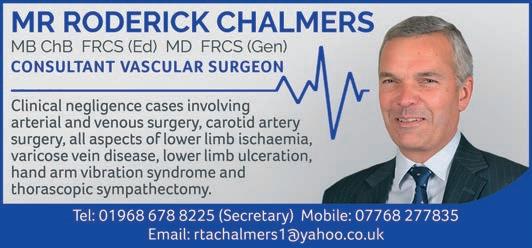
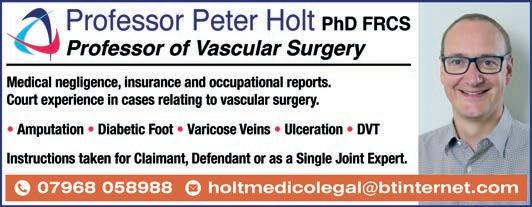

EXPERTS FOR MEDIA is a regular section in Your Expert Witness for experts who wish to offer their views and the benefit of their experience to the vast range of print and broadcast media.
Ever wondered how news teams find the experts they consult to explain the ramifications of breaking news stories, seemingly at the drop of a hat? Or how the producers of TV drama series ensure their stories are accurate and reflect the realities of the professions they portray?
The fact is that researchers consult registers of experts and expert periodicals just as lawyers do. In fact, Your Expert Witness is receiving an increasing number of enquiries from media researchers and public relations agencies looking to locate appropriate experts to inform their clients.
Experts for Media is therefore an ideal space to attract their attention. For prices and to book your space, contact Ian on 0161 710 3880 or via ian@dmmonline.co.uk .
Mr Francis Michael Brooks BSc MBBS MD FRCS Consultant Orthopaedic Spinal Surgeon
Mr Brooks is experienced in the treatment of all degenerative adult spinal conditions as well as trauma and tumour. He undertakes instructions relating to personal injury claims in general orthopaedic, spinal and trauma injuries on behalf of either claimant or defendant.
T: 07732 989991 E: brooks.francis@gmail.com / spinalreports@gmail.com

Joanne Caffrey Expert Witness & Trainer
Ms Joanne Caffrey undertakes expert witness instructions in cases relating to the following police topics:
• Use of force
• Custody procedures
• Drink/drug driving
• Ligature deaths
T: 07528 800 720 E: joanne_caffrey@sky.com

Professor Paul J Ciclitira
MB PhD FRCP MRCS FRCP AGAF Professor of Gastroenterology
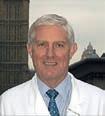
Professor Ciclitira has a particular interest in food allergy, including Coeliac disease, peptic ulcer, inflammatory bowel disorder, hepatology and general internal medicine. He undertakes expert witness instructions in cases relating to all of these conditions, acting on behalf of either claimant or defendant or as a Single Joint Expert.
T: 0207 603 3594 E: gastropjc@gmail.com W: www.profpaulciclitira.co.uk
Mr Jeremy Crew MA MD BChir(Cantab) FRCS(Urol) Consultant Urological Surgeon

Mr Jeremy Crew has offered a medicolegal service for over sixteen years. He provides expert medical opinion, medico-legal reports and court attendance on all aspects of urology including clinical negligence, personal injury and criminal matters.
T: 01865 307433 or 07508 617949 E: jeremycrew@urologyoxford.com W: www.oxfordurology.co.uk
Dr Dan Jones
PhD MSc BSc MA MEWI Cert Ecological Consultant - Japanese Knotweed
Dr Dan Jones undertakes expert witness instructions, including the preparation of expert reports and giving evidence in court, in civil claims relating to the growth and spread of all invasive plants. He can act on behalf of either claimant or defendant or as a Single Joint Expert.
T: 07967 408844 E: daniel@advancedinvasives.com W: www.advancedinvasives.com
Laird Assessors Automotive Expert


Mr Robert Marston BSc(Hons) MBBS FRCS(Eng) FRCS(Edin) FRCS(ORTHO) Consultant Orthopaedic and Trauma Surgeon

Mr Marston has 25 years experience as an expert witness. His special interest is lower limb orthopaedics and trauma, particularly hip and knee arthroplasty, joint injuries and fractures. His main medico legal work is with alleged clinical negligence. He also takes on selected personal injury cases. T: 07464 425 444 E: marstonmedicolegal@gmail.com W: www.marstonmedicalpractice.co.uk
Mr Luke Meleagros BSc MBBS MD FRCS Consultant Surgeon
Mr Meleagros completes around 6-10 expert reports per month, the majority in medical negligence cases and a smaller number of personal injury cases. He has reported extensively on cases involving abdominal laparoscopy surgery and hernia surgery.
T: 0208 527 0977 E: L.Meleagros@btinternet.com Sec: jawdobson@gmail.com

Laird Assessors are the UK’s leading independent automotive expert witness firm supporting claimant, defendant and criminal solicitors – from instruction to court. Laird provide intelligence to the automotive world predominantly relating to crashed vehicles.
T: 0151 342 9961 E: enquiries@laird-assessors.com W: www.laird-assessors.com
Mr Jonathan Luck FRCS FRCOphth Consultant Ophthalmologist
Mr Jonathan Luck over 20 years experience in medicolegal work. Experience of giving evidence in court including cross examination. Rapid turnaround of reports. Full consulting and diagnostic facility for Condition and Prognosis reports. Holder of the Bond Solon Cardiff University Civil Expert Witness Certificate. E: jon.luck@nhs.net W: www.jonathanluckmedicolegal.org.uk

Chris Makin FCA FCMI FAE QDR MCIArb Chartered Accountant • Accredited Civil Mediator
• Accredited Expert Determiner
Chris Makin was one of the first chartered accountants to become an Accredited Forensic Accountant and Expert Witness. He is also an accredited civil and commercial mediator and an accredited expert determiner. Over the last 30 years he has given expert evidence at least 100 times and worked on a vast range of cases.
T: 01924 495888 or 07887 660072 E: chris@chrismakin.co.uk W: www.chrismakin.co.uk

RSK
Materials and Structures


RSK offers impartial specialist materials and structures expertise in support of legal matters. Our team of consultants can act as expert witnesses on behalf of either claimant or defendant or as a Single Joint Expert in a range of construction disputes.
T: 01442 437500 E: info2@rsk.co.uk W: www.rskgroup.com
Target Psychology Ltd Providing Expert Witness Reports and Assessments
Target Psychology provide exceptional reports and their highly trained team of expert psychologists and psychiatrists regularly take instructions from solicitors and local authorities, providing assessments for families and individuals involved in legal proceedings.
T: 0161 425 1826 E: office@targetpsychology.co.uk W: www.targetpsychology.co.uk
Kathryn Thorndycraft-Pope
Examination of Documents and Handwriting


FHDI provides an independent document examination service, giving unbiased professional advice for criminal or civil litigation.
• Handwriting • Alterations • Indentations • Authenticity
T: 01569 764508 M: 07710 655838 E: fhdi@icloud.com W: www.forensichandwriting.co.uk

